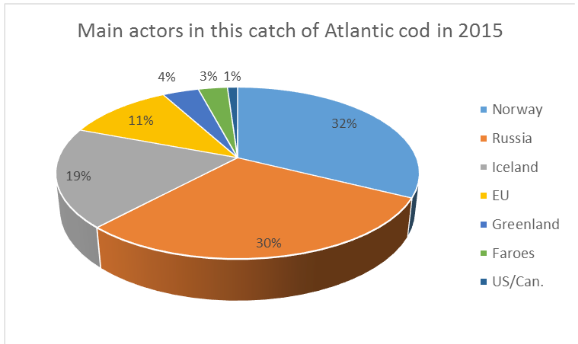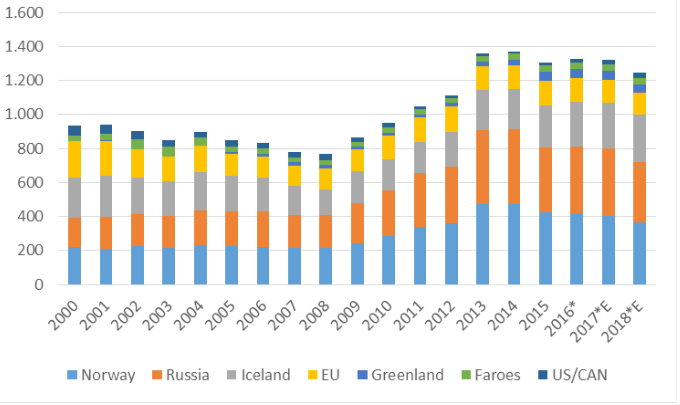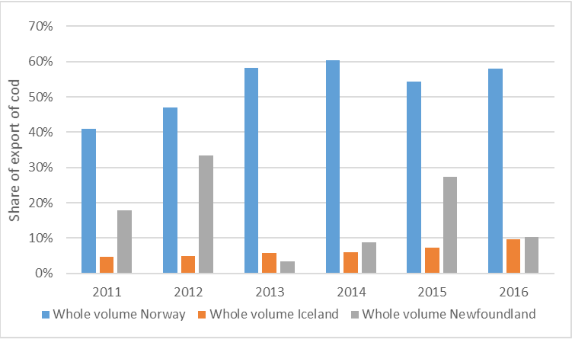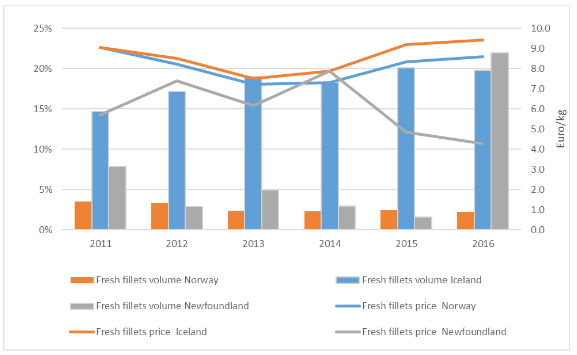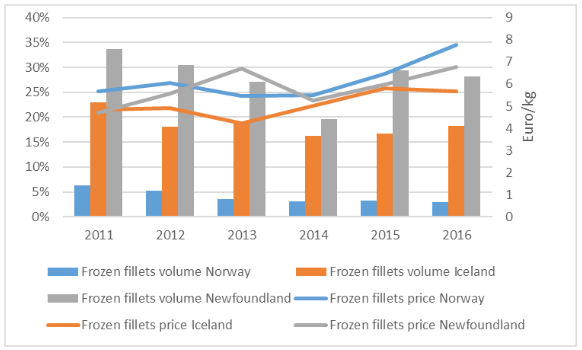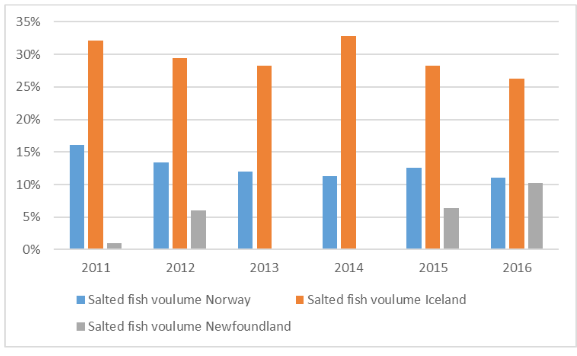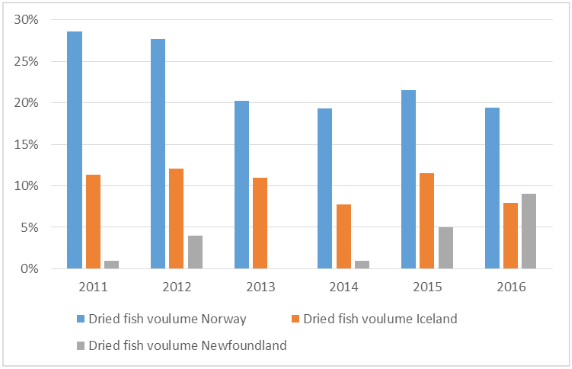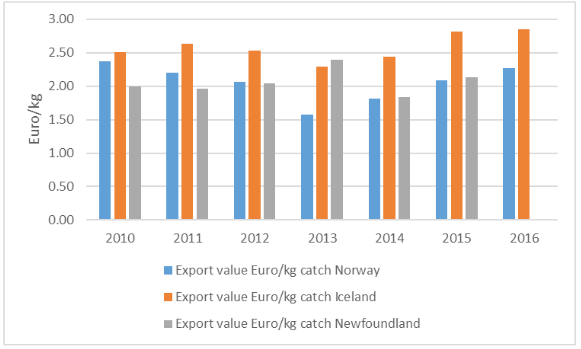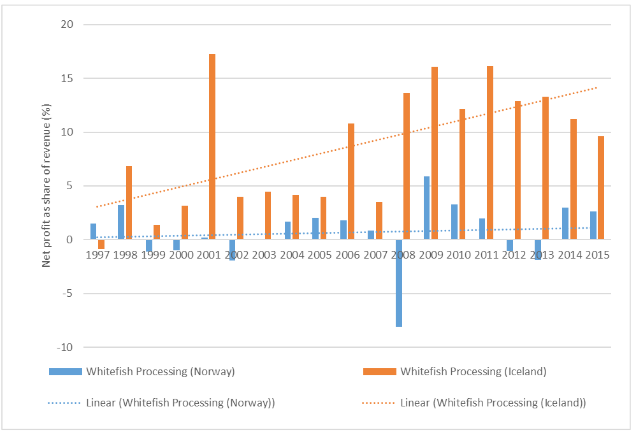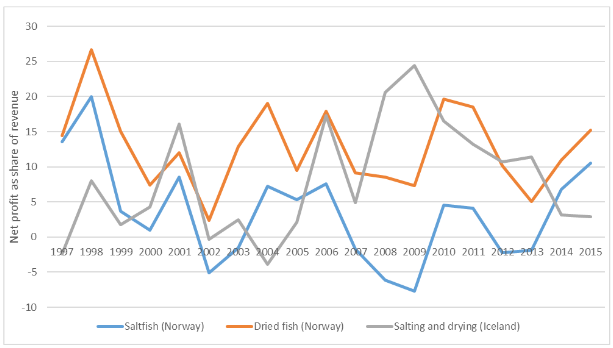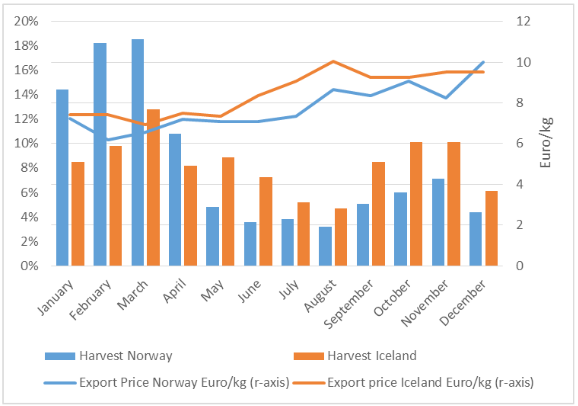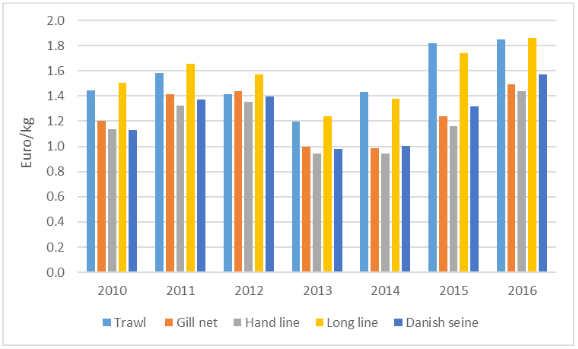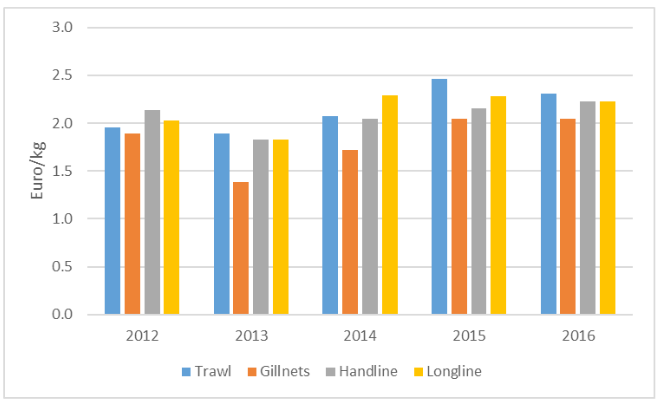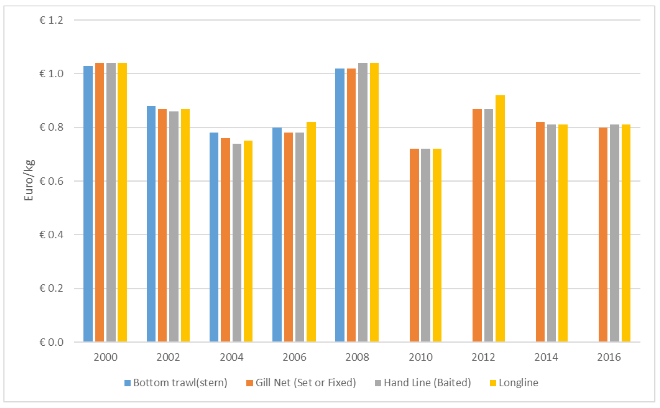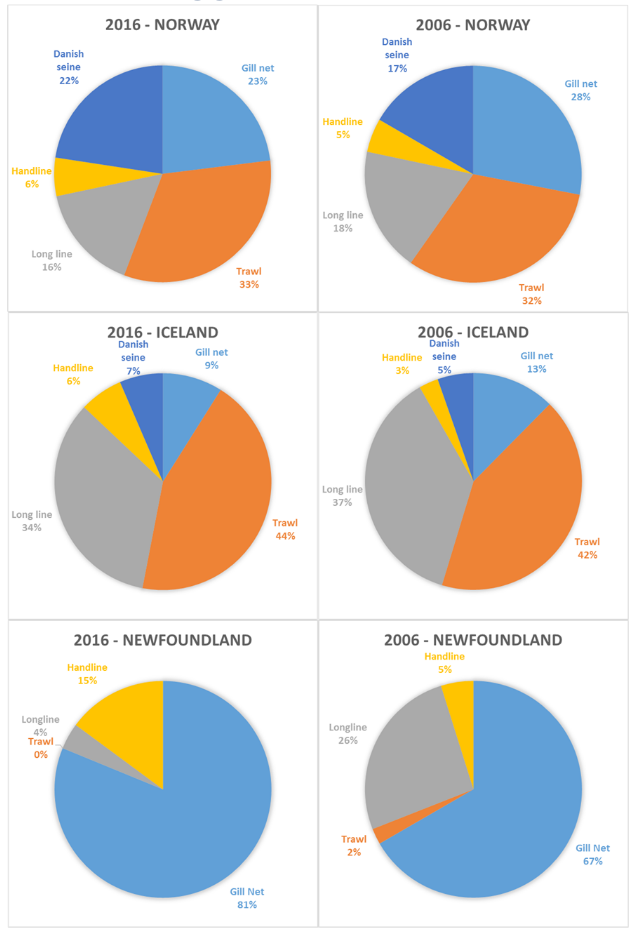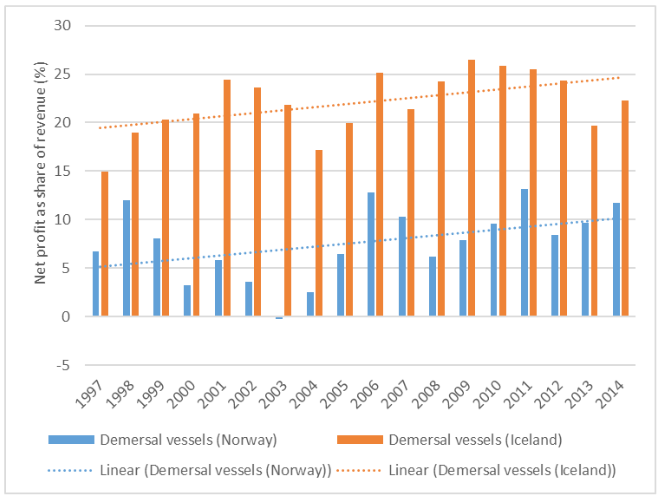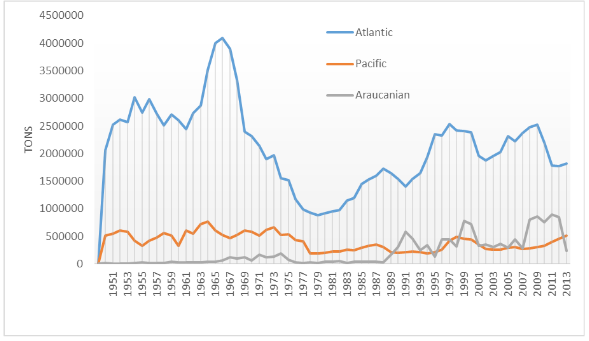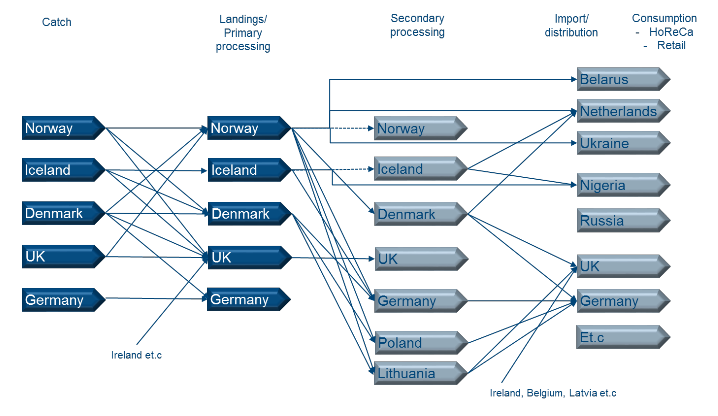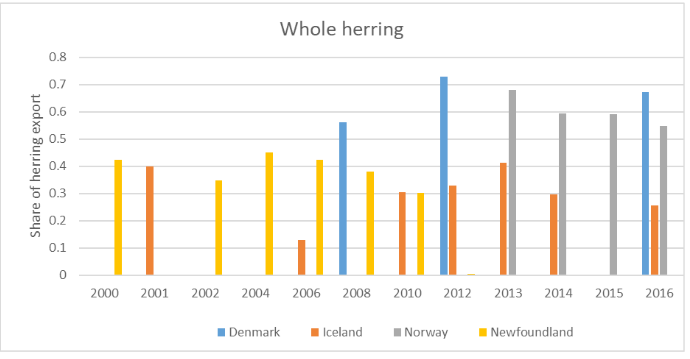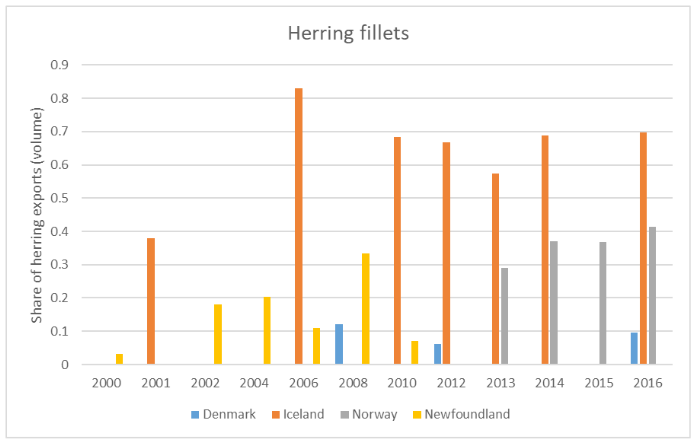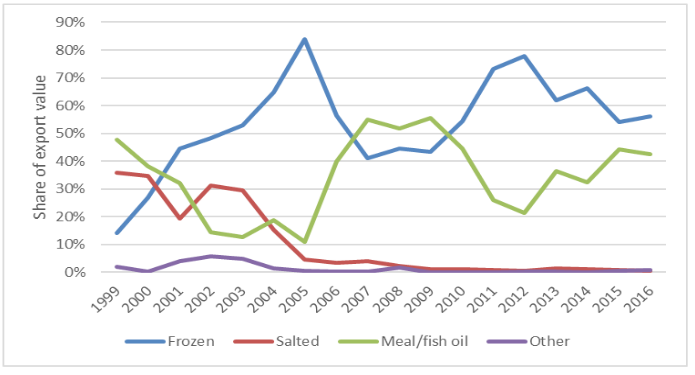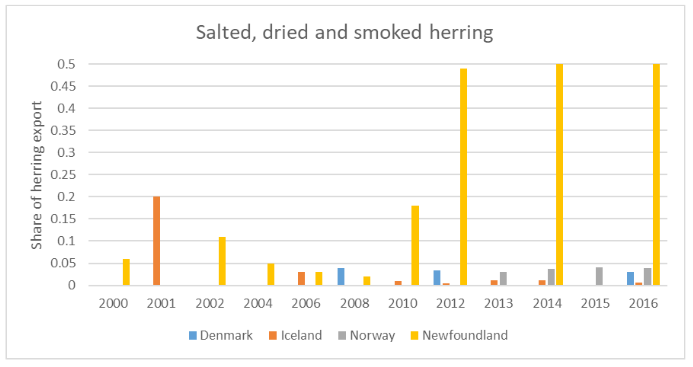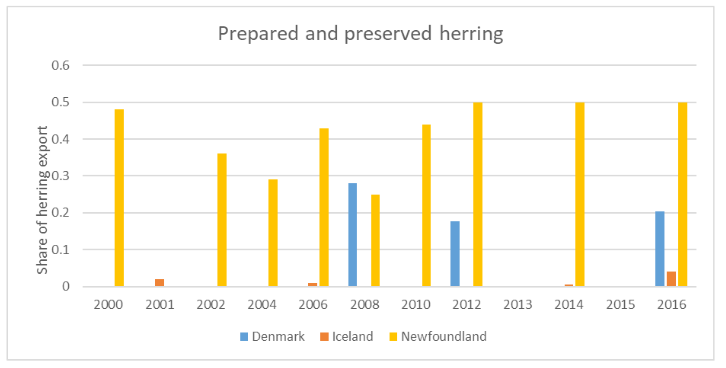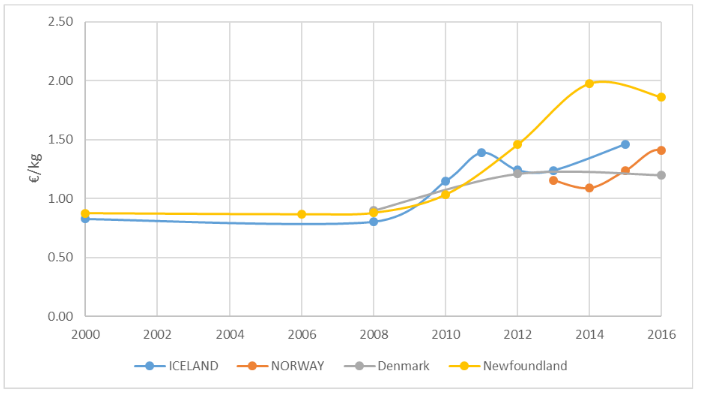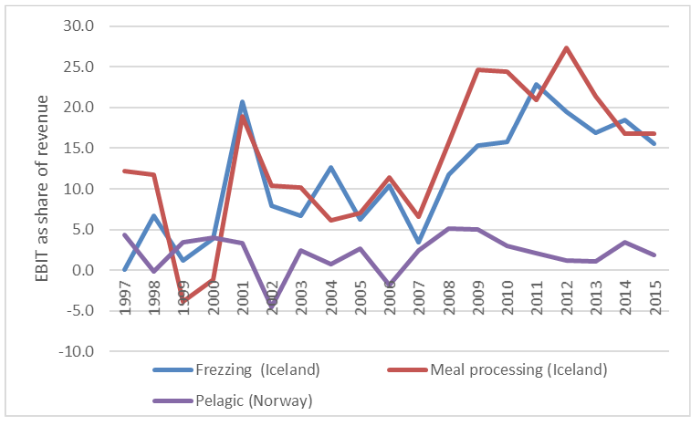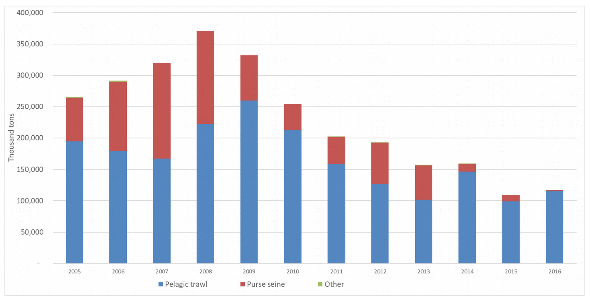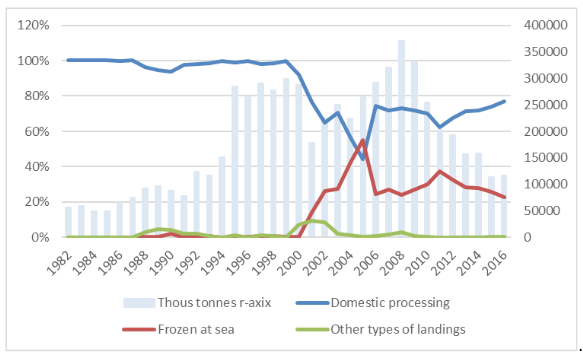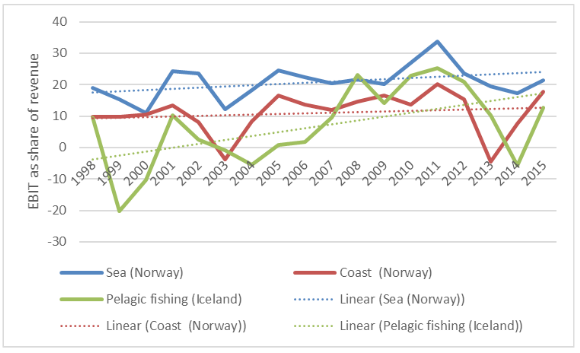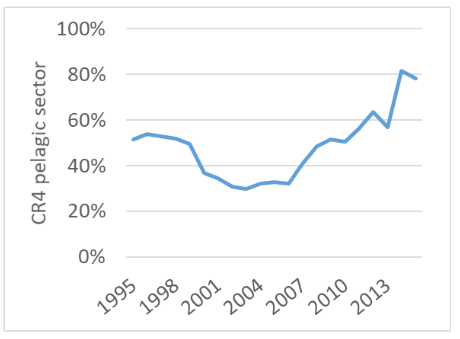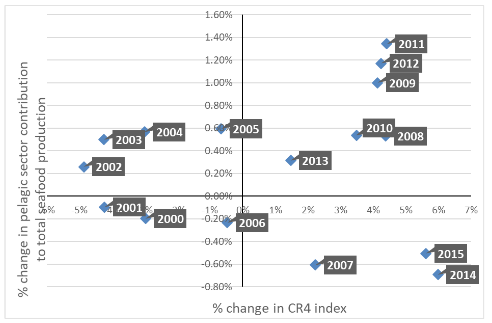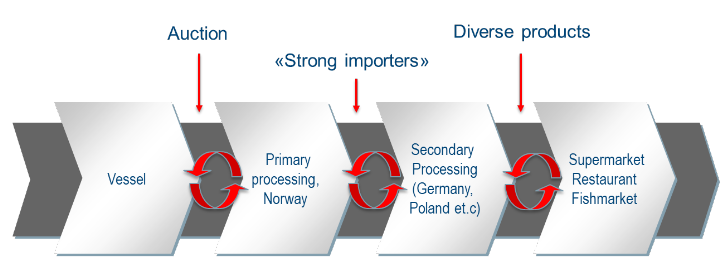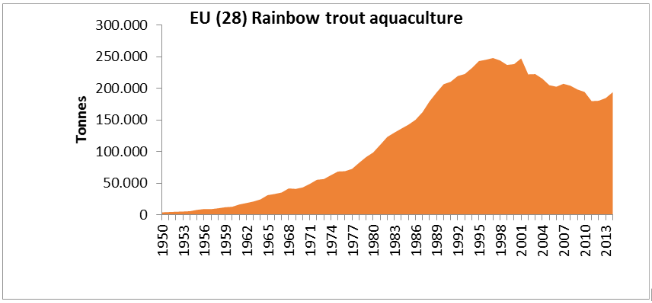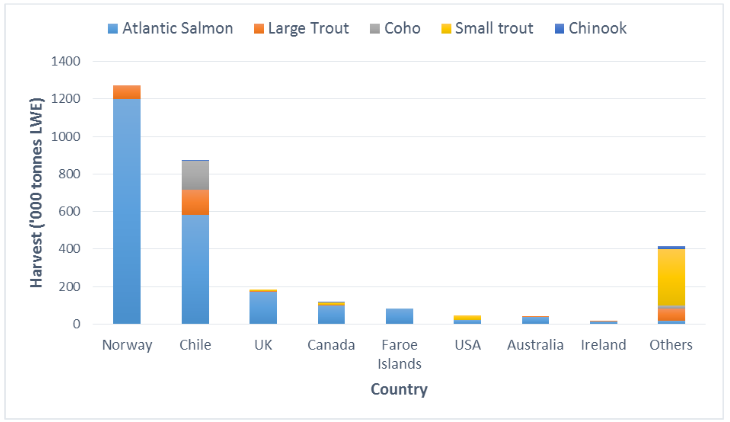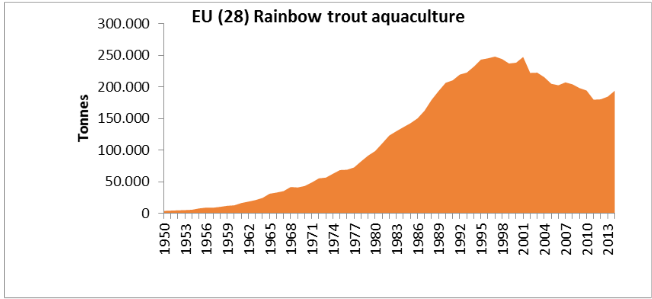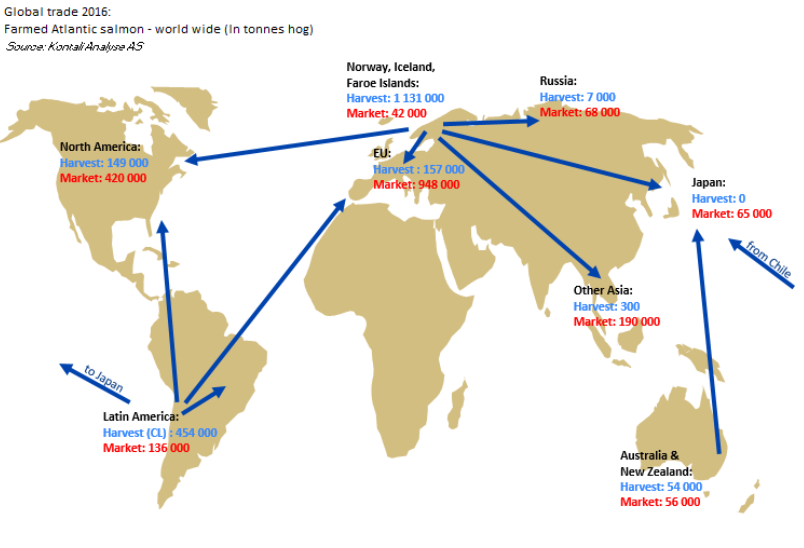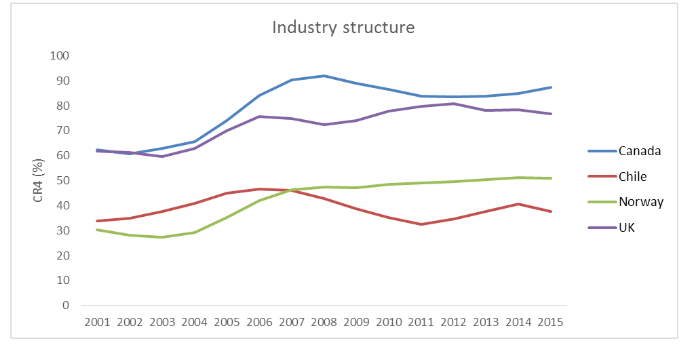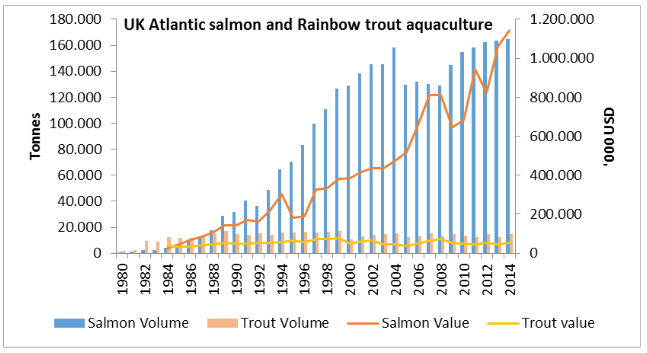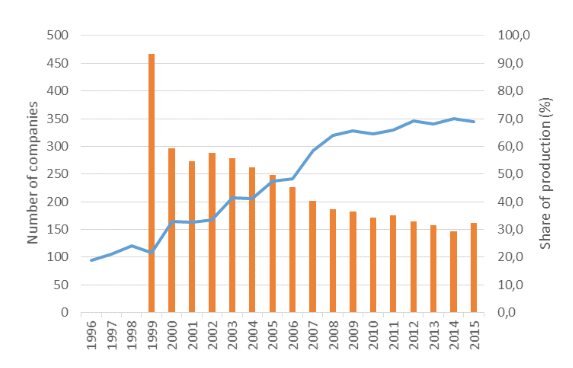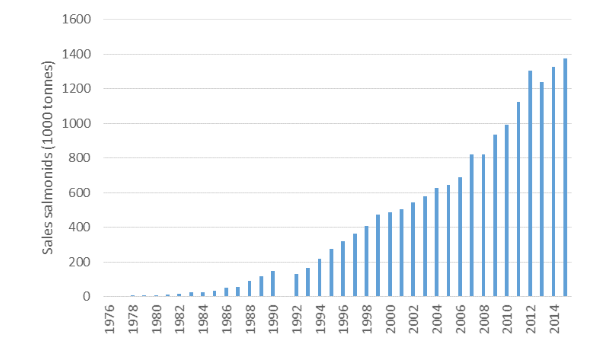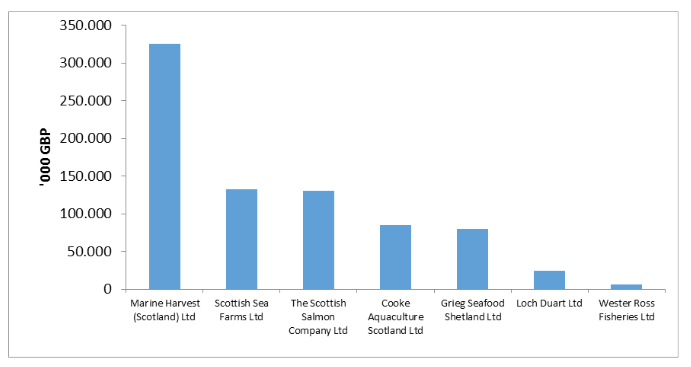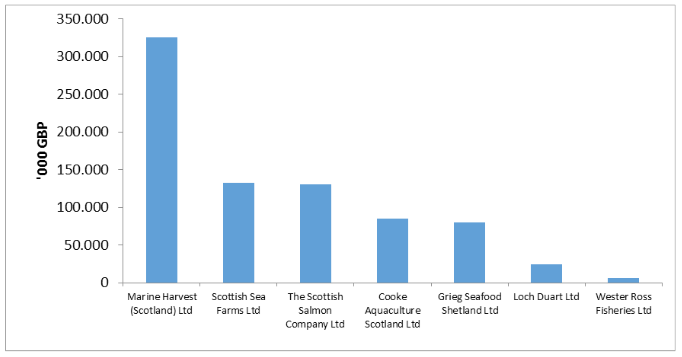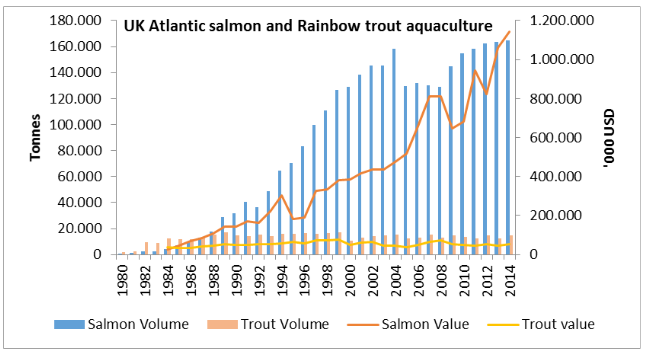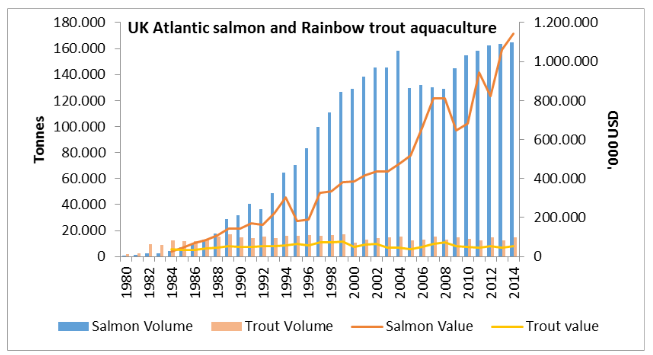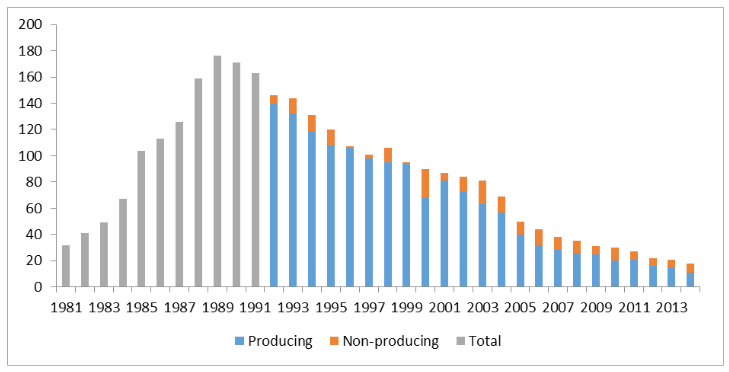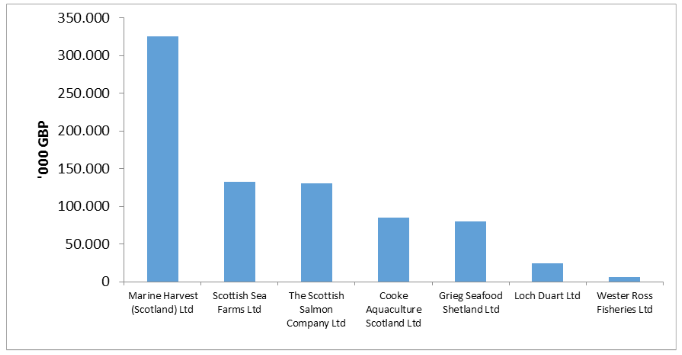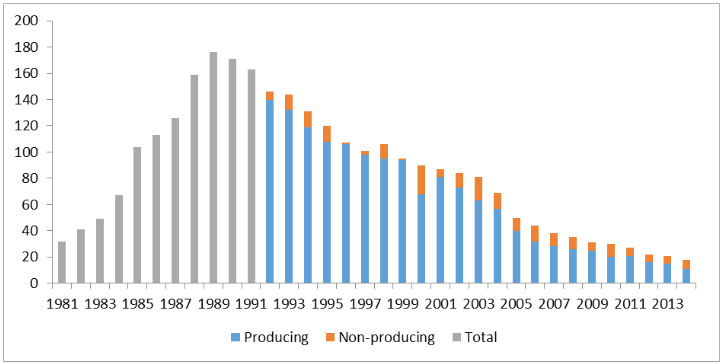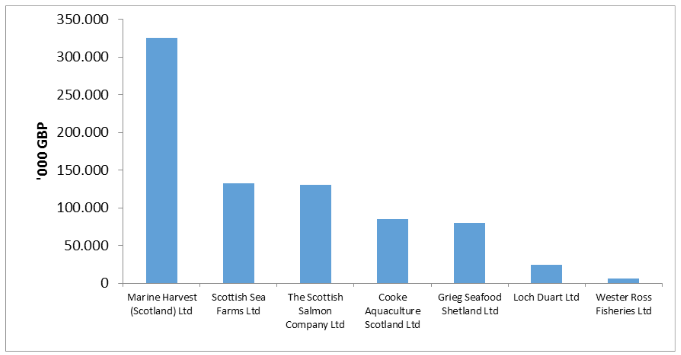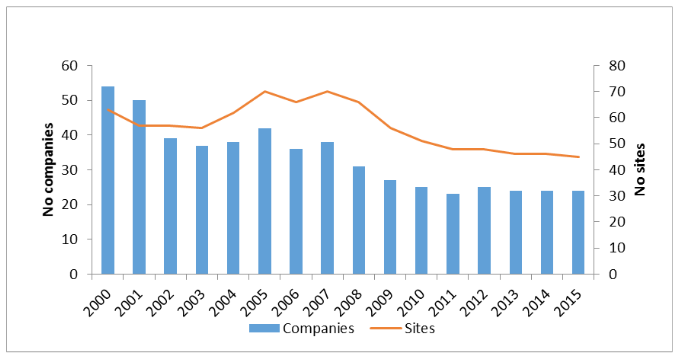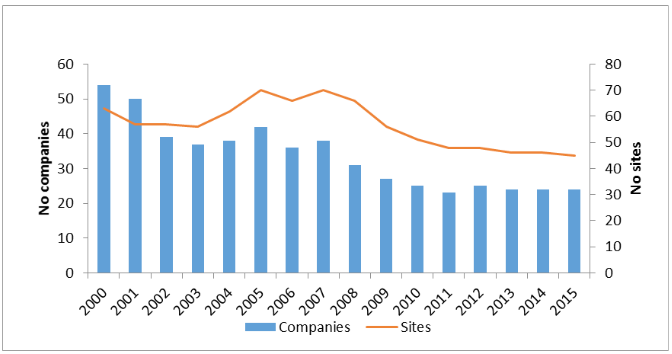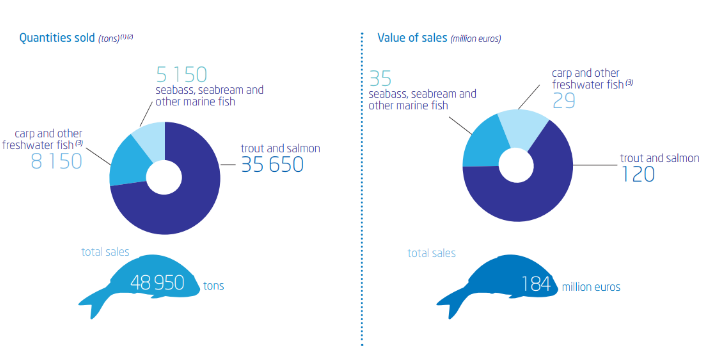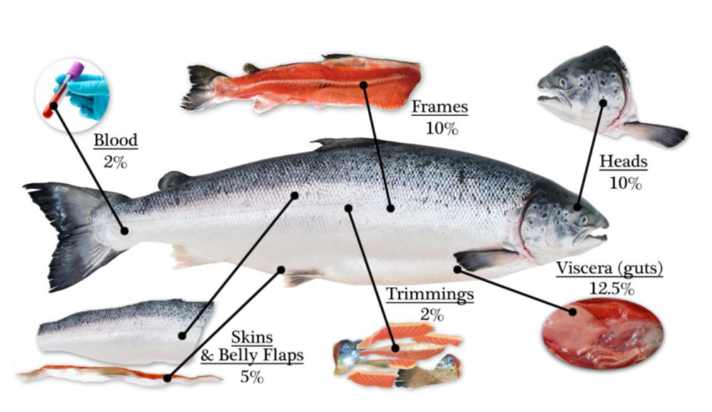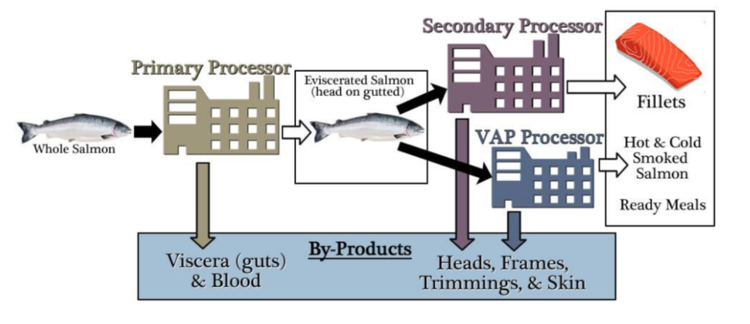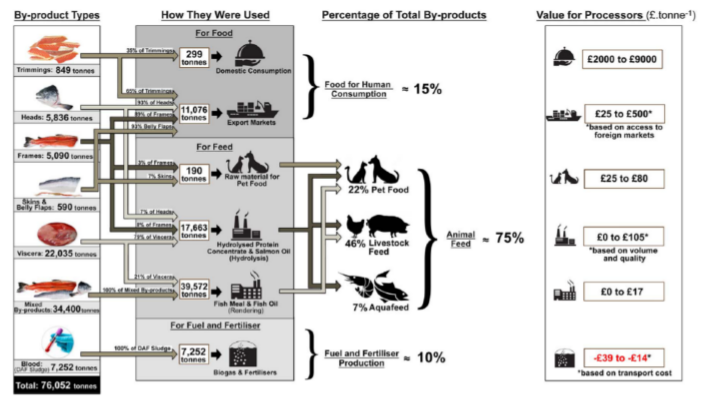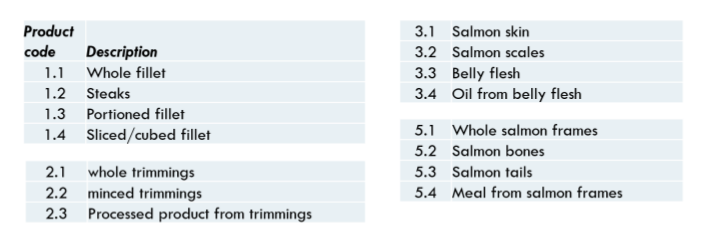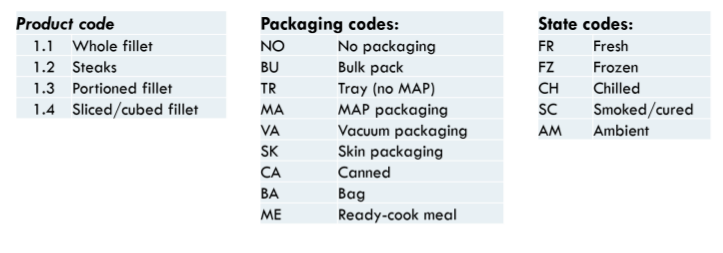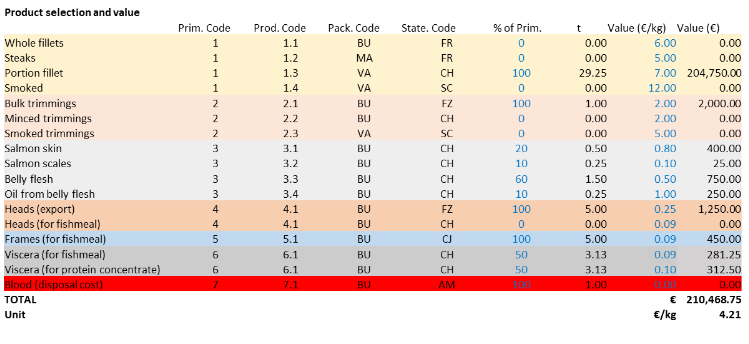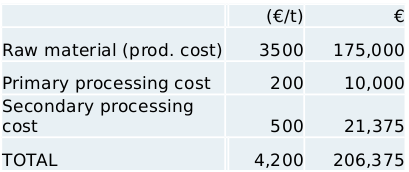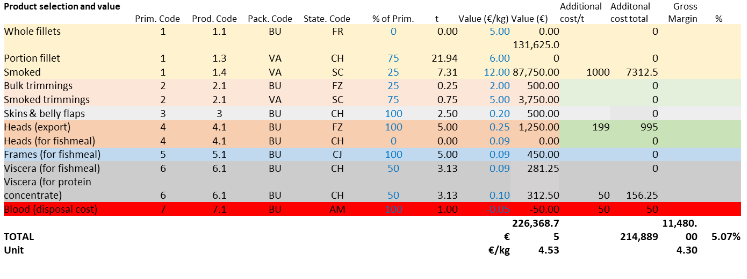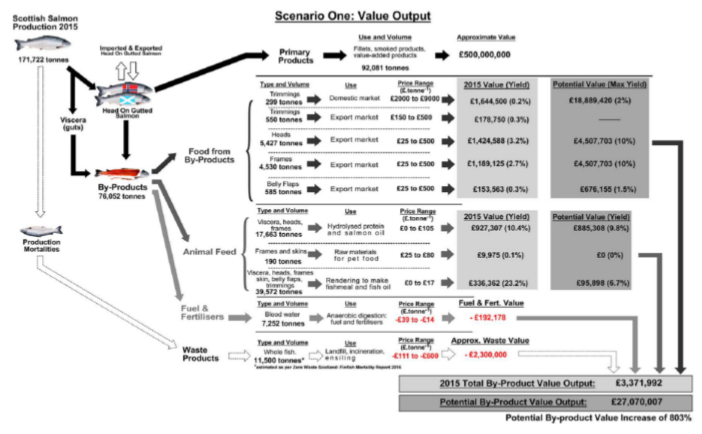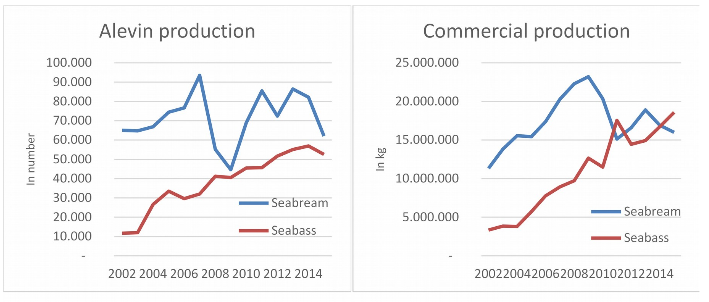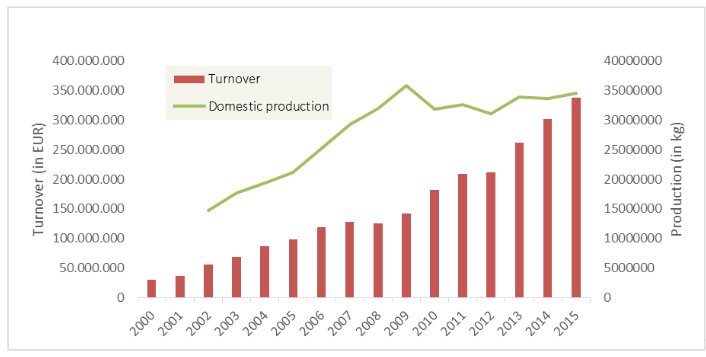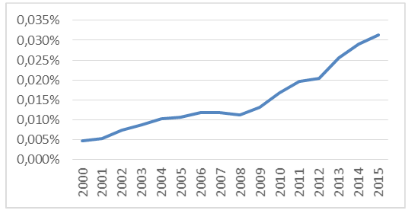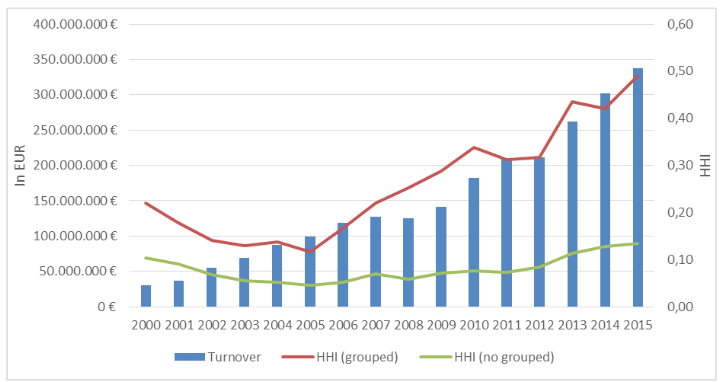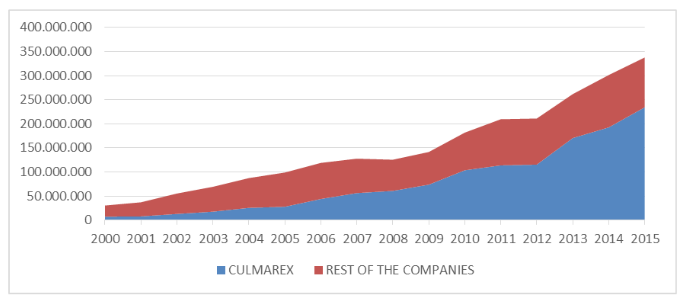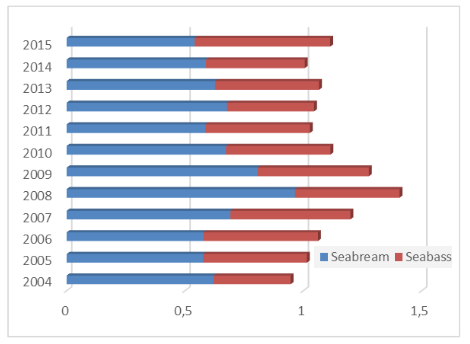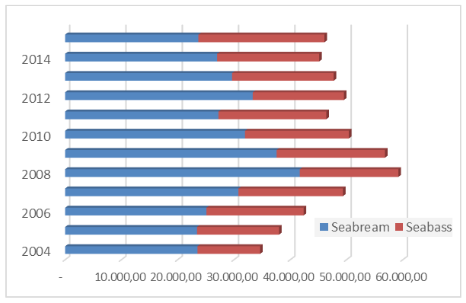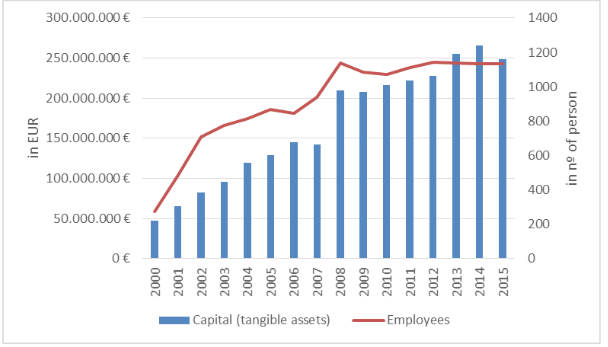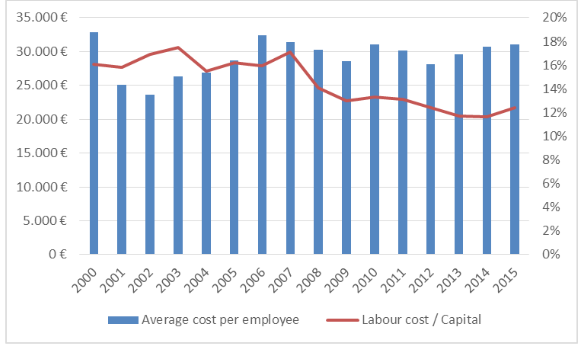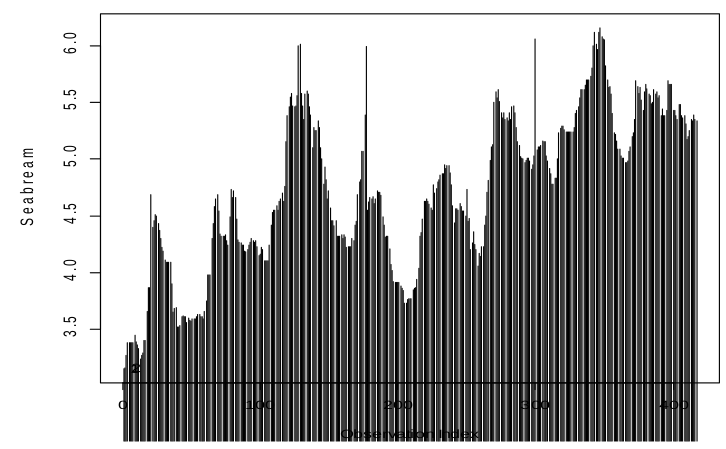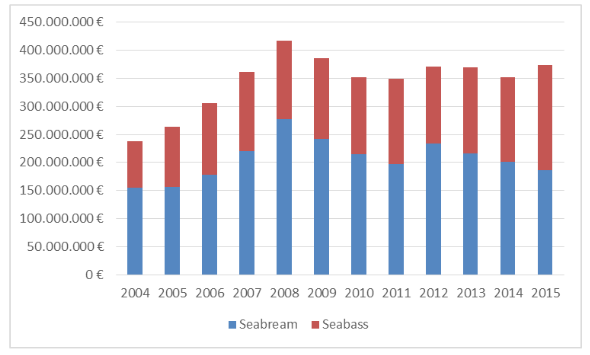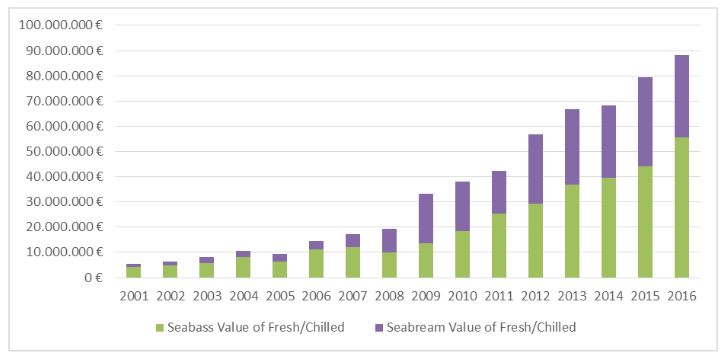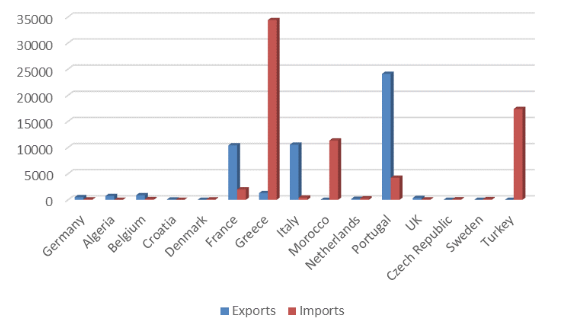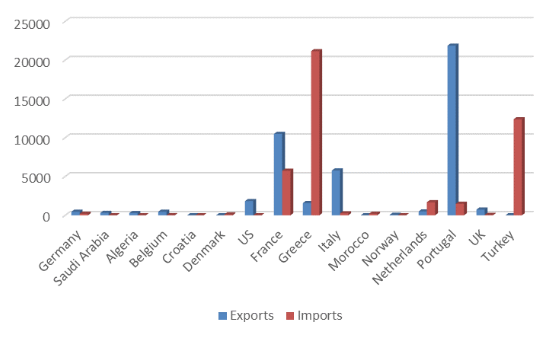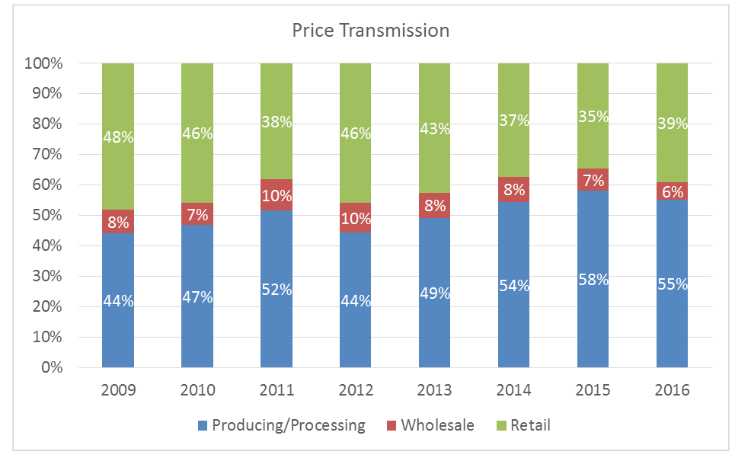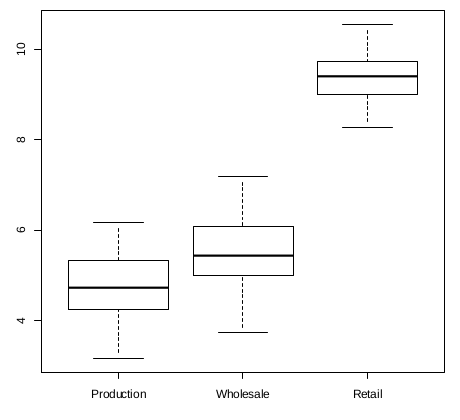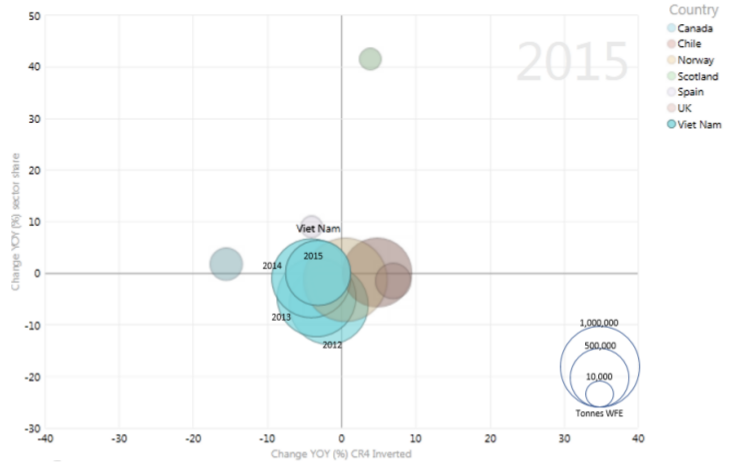Deliverable 3.4
Contents
- 1 Report on evaluation of industry dynamics opportunities and threats to industry
- 1.1 Executive Summary
- 1.2 Atlantic cod
- 1.2.1 Summary
- 1.2.2 Global Market review
- 1.2.3 Fisheries Management System in Norway, Iceland and Newfoundland
- 1.2.4 Market approach
- 1.2.5 Processing
- 1.2.6 Price settling mechanism
- 1.2.7 Fishing
- 1.2.8 Consolidation in the sector
- 1.2.9 Overall economic performance and competitiveness of the fisheries value chain
- 1.2.10 Strategic Positioning Briefing
- 1.3 Atlantic Herring
- 1.3.1 Executive summary
- 1.3.2 National comparison
- 1.3.2.1 Introduction
- 1.3.2.2 Fisheries Management System
- 1.3.2.3 Markets- and production development
- 1.3.2.4 Price settling mechanism
- 1.3.2.5 Fishing
- 1.3.2.6 Consolidation
- 1.3.2.7 Overall economic performance and competitiveness of the fisheries value chain
- 1.3.2.8 Strategic Position Briefing
- 1.4 Salmon
- 1.5 Sea bass & bream
- 1.6 Pangasius
Report on evaluation of industry dynamics opportunities and threats to industry
Executive Summary
In this report, evaluation of industry dynamics opportunities and threats to industry, we are focusing on value chain dynamic for certain industries and species. The framework used is a bit different for caught species (cod and herring) and farmed species (salmonoids, sea bream & bass and pangasius). The industry dynamics is more value chain focused for the caught species, while individual companies are also the focus for the farmed species. The main results for the caught species reviled very interesting structural difference and functionality of the value chains for cod between Norway, Iceland and Newfoundland. Previous studies have argued that the superior harvesting and marketing strategies of the Icelandic industry may be rooted in factor conditions that are difficult to duplicate and a rigid institutional framework in Norway and partly the social resource structure of the Newfoundland industry, where market conditions have very limited consideration in terms of the structure or management of the industry.
The vertically integrated companies in Iceland where the processor owns its own fishing vessels. Unlike the push supply chain system followed by the Norwegian and partly the Newfoundland companies where they must process the fish that they receive, the Icelandic processors places orders to its fishing vessels based on the customer orders and quota status, thus following a pull supply chain system. The Icelandic processors are able to sends orders to the vessels for how much fish of each main spices is wanted, where to catch and to land so they have the desired size and quality of raw material needed for fulfilling customer orders. This structural difference is also affecting the product mix that the countries are going for.
It is also very interesting to see the difference in structure and functionality of the value chains between Norway, Iceland, Denmark and Newfoundland for herring. The structure of the industries is different as seen in the degree of vertical integration and the limits that government’s put on the industries. It is though surprising how homogeneous the industry is between those nations. The nature of pelagic species that is, seasonality and high catch volumes in short periods, makes the product global commodity for further processing from one season to the next. The main markets are Business to Business (B2B)
The first noticeable difference observed, apart from the structure, is the price settling mechanism. On one hand it is the Norwegian system that builds on minimum price and auction market which is the same that is used to determine the Danish price. In Iceland the price is decided by the Official Bureau of Ex- Vessel Fish Prices. he Norwegian price is in many cases double that of the price in Iceland. The price obviously affects the profitability of the industry as the Norwegian fishing is benefiting from high price but the processing sector is suffering from low profitability. On the other hand, the processing sector in Iceland is doing well as well as the profitability of the fishing is healthy. It can be claimed that the overall profitability is higher in Iceland due to the freedom of strategically positioning yourself in the value chain and being vertical integrated or not, without external limitation as those that can been seen in Norway, Denmark and Newfoundland
Aquaculture is the primary source of salmonid supply globally. The different salmonid species available on the market are substitutable to a considerable extent due to their pink flesh colour and similar properties. However, different dynamics in the broader competitive environment, and in the particular circumstances of national sectors, in which the businesses comprising these industries are embedded, have determined different developmental trajectories for the very same industries. These dynamics include the changing nature of consumer demand characteristics, production technology, national regulatory regimes, international trade, industry structure, availability of natural resources. Discussed in this chapter are the cases of farmed Atlantic salmon and rainbow trout in major producer countries and the role key external influences have played in shaping different developmental outcomes. The interaction of selected salmonid producer firms with their distinct competitive environments is illustrated through firm-level case studies of strategic positioning.
The output of most salmonid aquaculture, and Atlantic salmon in particular, is highly commoditised i.e. there is little differentiation between farms and competition is based purely on price. These products, mostly head-on gutted fresh fish, serve as raw material for further processing. In that situation, large enterprises which can reduce costs of production economies of scale and offer the lowest price, would have competitive advantage.
Seabass and seabream are the most important species for the aquaculture of fish in Spain, being one of the most important markets in Europe. The production and the market is highly concentrated and economies of scale may improve the competitiveness of the sector. The integration of production and the stable international trade allows to increase the share of the price value. The pangasius industry in Viet Nam has grown quickly over the last two decades to become one of the main food exports from the country and a major contributor to the Vietnamese economy. Pangasius products, mainly frozen fillets, are currently exported all over the world, with the largest markets being the EU, the USA, and more recently China. The success in market penetration of pangasius products can be attributed to their mild taste, lack of bones, and most importantly their low price compared to other, more traditional whitefish products, for which it acts as a low-cost substitute.
The production node in the pangasius’s value chain was initially highly fragmented, composed of many small-scale family owned enterprises and middle-scale processor-exporters. However, the industry is undergoing a rapid a rapid consolidation and increasingly being served by large-scale vertically integrated enterprises, encompassing all stages of the value chain. The reasons for that can be found in the improvement in seed production methods, control of fish health and disease problems, feed and nutrition and market requirements.
Atlantic cod
Summary
It is very interesting to see the difference in structure and functionality of the value chains between Norway, Iceland and Newfoundland. Previous studies have argued that the superior harvesting and marketing strategies of the Icelandic industry may be rooted in factor conditions that are difficult to duplicate and a rigid institutional framework in Norway and partly the social resource structure of the Newfoundland industry, where market conditions have very limited consideration in terms of the structure or management of the industry.
The vertically integrated companies in Iceland where the processor owns its own fishing vessels. Unlike the push supply chain system followed by the Norwegian and partly the Newfoundland companies where they must process the fish that they receive, the Icelandic processors places orders to its fishing vessels based on the customer orders and quota status, thus following a pull supply chain system. The Icelandic processors are able to sends orders to the vessels for how much fish of each main spices is wanted, where to catch and to land so they have the desired size and quality of raw material needed for fulfilling customer orders.
This structural difference is also affecting the product mix that the countries are going for. Iceland is therefore placing more and more emphasis on fresh fillets and pieces, while the other countries are going for more traditional products, like salted, dried and frozen products. Due to the vertical integration in Iceland, the production plans are developed based on customer orders and then a plan is made for fishing, while in Norway and Newfoundland, the production plans is usually developed after receiving the fish at the processing plant as the information about volumes of specifies caught and quality is not available beforehand.
Global Market review
According to a book by Mark Kurlansky; ”Cod - A Biography of the Fish that Changed the World”. Cod was the reason Europeans set sail across the Atlantic, and it is the only reason they could. What did the Vikings eat in icy Greenland and on the five expeditions to America recorded in the Icelandic sagas? Cod, dried in the frosty air. What was the staple of the medieval diet? Cod again, sold salted by the Basques. As it turns out, cod has sparked wars, shaped international political discourse, impacted diverse cultures, markets, and the environment.
Cod importance has dwindled, but it is still of major importance to Iceland and Norway and growing importance in Newfoundland and therefore it is important to look at industry and market dynamics, opportunities and threats in the value chain of cod for these countries.
Main producers
Atlantic cod is only one of many species entering the global supply chain for whitefish, which can be viewed as substitutes. Amongst them, we find Alaska pollock, hake, saithe, Pacific cod, haddock, hoki and Atlantic redfish. Altogether, the global supply of these species in 2015 was about 6,937 million tonnes, according to FAO. The largest species by far is Alaska Pollock, for which the catch in 2015 added up to 3.3 billion tonnes – 48 per cent of the total whitefish supply – for which US and Russia are the largest actors.
Atlantic cod was the second largest species in the global whitefish supply in 2015, responsible for 1,304 million tonnes, or 19 per cent of the total. The main actors in this catch of Atlantic cod in 2015 was Norway, Russia, Iceland and the EU with 11% of the catches as can been seen in figure 1. The main actors among the EU countries are Denmark, UK, Germany and Poland. The main suppliers since the turn of the century are shown in Figure 2.
Figure 1. Main actors catching Atlantic cod in 2015 according to FAO Figure 2. Supply of Atlantic cod from the North Atlantic waters, by country, 1000 tonnes, 2000–2018. Source: FAO and (*) Groundfish Forum
Figure 2 shows a relatively stable distribution of cod catches until the increase in the quotas for Northeast Atlantic cod about 2009, where Norway and Russia increased their share. Moreover, it shows that the catch of US/CAN fell until the end of this period, when it rose again, and that Greenland catches have increased over the period. As can been seen in Figure 2, The International Council for the Exploration of the Sea (ICES) has recommended a 20 percent cut in the Barents Sea cod quota for 2018. However, the Joint Russian Federation- Norwegian Fisheries Commission in October 2017 agreed on the 2018 quotas, which include a 13 percent cut in the Barents Sea cod quota to 775.000 tonnes (FAO).
Main markets
The EU is by far the largest market for cod products in the world. Cod is processed in different format to fulfil the needs and customs of different markets. There is a big consumption of fresh and frozen product in EU, especially in UK and France. The tradition of drying fish to preserve it dates back to Viking times, but the process of salting fish began in the 15th century, when the Iberian fishermen were sailing to and from Newfoundland. Cod that had been preserved in salt would last the length of the journey. Clipfish/saltfish or bacalao is also popular in Catholic countries, thanks to a tradition that dates back to the middle ages when the pope ordered Catholics to eat fish instead of meat during Lent. Therefore have Iceland and Norway exported bacalao for centuries to Catholics around the world, especially to Spain and Portugal. There are also number of other traditional markets, like Nigeria for dried fish parts and heads. USA was also a big market for cod products, and it has been growing again in recent years, especially for fresh cod.
Cod producers from Norway have been taking putting effort in emerging market like China, where there is great potential but no custom of consuming cod products.
Figure 3. Trade of cod in the EU, Import of cod products in the EU, both extra and intra EU trade. Raw data from EUMOFA.The total import in the EU was 761 thousand tons in 2016 and the imports in total have been on the rise in recent years. That don’t mean that this came all from outside of EU. Part of the imports (42.1%) came from Intra EU trade while the larger part (57.9%) came into the EU from countries outside the EU, like Norway and Iceland. Largest part of the EU export figures of 421 thousand tons are Intra EU trade or 94.1%, therefore there are only around 25 thousand tons of cod exported out of the EU to non EU countries.
Frozen cod is by far the most common preservation form of traded cod in the EU as can been seen in Error: Reference source not found. The import of dried, salted and smoked cod products have been relatively stable in recent years but the main growth has been in the import of frozen and fresh cod products. The imports of fresh cod has been on the rice since 2008, but 2015 the volume went down but gained momentum again in 2016. The imports of prepared or preserved products is low but relatively stable between years.
Fisheries Management System in Norway, Iceland and Newfoundland
General
Norway
“The main objective for the industrial and fisheries policy is the highest possible value creation in Norwegian economy, within sustainable limits. The Ministry of Trade, Industry and Fisheries work is to obtain this main objective builds on the following sub- objectives: efficient use of society’s resources, increased innovation and adaptation ability, and companies who succeed in international market. The sub-objectives and prioritised areas to achieve these are just as important for the seafood industry as other activities in Norway. A purposeful superior effort to stimulate to increased innovation and adaptation ability in Norwegian economy is of great importance also for the seafood industry.”
Iceland
Iceland seafood sector is modern and competitive, based on sustainable harvest and protection of the marine ecosystem. Marine products have historically been the country’s leading export items and the seafood industry remains the backbone of the economy. The fisheries management in Iceland is primarily based on extensive research on the fish stocks and the marine ecosystem and biodiversity, and decisions on allowable catches are made on the basis of scientific advice from the Icelandic Marine Research Institute and catches are monitored and enforced by the Directorate of Fisheries.
Newfoundland
Fisheries and Oceans (DFO) is responsible for management of the Canadian fisheries stocks in accordance with the roles and responsibilities outlined in Canada’s Fisheries Act. The major objectives and priorities of the DFO’s fisheries management policies include ensuring environmental sustainability and conversation of the resource, ensuring access based on adjacency or proximity to the resources, consideration of the relative dependence of coastal communities and the dependence of various fleet sectors, as well as factors such as economic efficiency and fleet mobility. Inclusion of stakeholders in the decision-making process is regarded as a key priority for fisheries management in Canada (Fisheries Management Decisions, 2017; Sustainable Fisheries Framework, 2017).
Quota system: Individually Transferable Access
Norway
- Rule of thumb: Off-shore vessels governed by licenses, and coastal vessels by annual participation rights (off-shore conventional vessels excepted).
- In order to get a fishing quota you have to buy a vessel (a pre- requisite is loosened up in later years, where one nowadays can get hold of structured quotas, without factual vessel transactions). Transferability has increased, buts still with great imperfections compared with an ITQ-regime.
- Quota distribution to vessel groups (coastal vs. off-shore, and different size classes within the coastal vessel group) based on allocation formulas agreed within the Norwegian Fishermen Association, upon historical rights. Still with some autonomy for the authorities to allocate certain shares of quotas to special schemes (youth, recruitment, R&D, etc.) before allocation to vessels.
- Regional distribution safeguarded by fleet composition, and limited transferability between regions for some licenses/participation rights.
- Quota year is the same as the almanac year.
Iceland
The ownership of quotas involves the right to catch the fish but does not entail ownership of the fish stock. Thus, it is claimed that the quota does not mean the ownership of the fish but rather the right to catch the fish. Since 2001 small boats has been allocated TAC (Total allowable catches) and all effort based system abolished until 2009 when coastal fisheries was introduced. As can be seen in figure the share of small boats of the TAC was 14.2% in 1992 and is 22.3% in 2016. It peaked in 2001 when it was 24.1% of the TAC in cod. Part of this increase can be explained with changes in classification of small boats as in 2013 when small boat definition went from 15 gross registered tonnes (GRT) to 30 GRT.
- The emphasis of the fisheries management system since 2001 has been to simplify the system and bring all into the quota system of ITQ and TAC system. Against this, open access fishing was introduced in 2009 when new system was introduced for small boat called costal fishing (isl. strandveiði).
- By the 1990 Act the fishing year was set from 1. September to 31. August in the following year but previously it had been based on the calendar year. This was an effort to channel fishing of the groundfish stocks away from the summer months, when quality suffers more quickly and many regular factory workers are on vacation.
Newfoundland
Generally, DFO allocates quotas for each stock/species (or group of species) in accordance with a specific fishing season and within a specified fisheries management division. The key regions or fisheries management divisions for cod quota or allocation in NL are:
- 3K (including 2J3KL)
- 3Ps
- 4R (including 4R3Pn)
Information included in a fisheries decision may include:
- opening and closing dates for the season,
- total allowable catches (TAC),
- and management plans (Fisheries Management Plans, 2017) with certain fisheries managed through multi-year Integrated Fisheries
Management Plans (Integrated Fisheries Management Plans, 2017). In Newfoundland, Atlantic cod are managed through a series of strategies. Pending the NAFO region, the cod fishery can be a set quota, a weekly allowance or allocation, or may be an experimental fishery. Based on principles of adjacency and the numbers of vessels /harvesters participating in the fishery, the coastal fleet (<65 feet) has a strong position within the NL fisheries sector.
Entry barriers into the system:
Norway
The activity demand in the Participation Act states that in order to own a fishing vessel one have to be an active fisher.
- Many exceptions have been granted. Firstly, on the same footing as active fishers are administrative fishing vessel owners – caretaking the daily operation of vessels from land. Also, as the filleting industry in the north of Norway was built up and prioritised as whole year employers, many filleting firms were granted cod trawl licenses, which today are held by two big processing concerns (Lerøy and Nergård)
- To become a registered fisher, you have to live in Norway and work on a registered Norwegian fishing vessel
- To get a vessel registered a as a fishing vessels, demands have to be met regarding size class and operating areas.
Like in other western society fisheries, the closure of the commons have increased the capital intensity, and labour is to a large degree substituted by capital intensive production equipment. Foreigners can buy vessels below 15 meters in Norway and control no more than 40 per cent for boats above 15 metres. Processing industry - no nationality limitations exists
Iceland
All professional fishing in Iceland has to have licences for fishing.
- Capital intensive due to high price of quota
- Entry for foreign investments very limited (or closed).
- Economics of size Costal fisheries
- In 2016 total 9790 thousand tones are allocated for coastal fishing one open access base from May to August.
- Open access
- Low profitability (returning loss for all years of operation)
- Coastal fishing is limited to small boats with maximum two handlines per person and maximum two person on the boat. The maximum 650 kg catch per day and fishing is limited to four days a week.
- There are also limits of TAC for each area for the small boats.
Newfoundland
No new licences being issued by DFO
- Entry into fishery is based on acquisition of existing licences
- Requires a professional fish harvester certification
- Significant investment in terms of education and training and at-sea experience
- Cost of entry into the fishery is prohibitive due to the high cost of capital investment (vessels,
gear, etc.) and the cost of licences
- Uncertainty over future allocation/quotas and if there will be return on investment
Exit barriers from the industry
Norway
- Exit barriers are fewer Vessel owners are unable to recover the full vessel value as they exit the industry.
- However, the increase in quota prices over the years should cover for such discrepancies.
- Limited transferability between regions in some vessel groups.
Iceland
- Low exit barriers quota easily sold and market open
- No tax limitation for selling the fishing rights and ITQ.
- Unlimited transferability between regions
Newfoundland
- Low exit barriers licenses are easily sold; open market for licence
- No regulations governing the sales
- Exit not linked to potential resource re-allocation for new entrants; i.e. portion of share or allocation is not reinvested back into the fishery
- No financial reinvestment (e.g.no tax or fee) required to be paid by harvester upon sale of licence and exit from the system
Quota ownership and quota prices
Norway
There is in Norway a consolidation limit for cod for both conventional off-shore vessels (auto-liners) and cod trawlers, but not for coastal vessels.
- Firms owning conventional off-shore vessels cannot, directly or indirectly, own vessels that
control more than 15 per cent of the group quota for any of the species included.
- For cod trawler, firms cannot control more vessels exceeding more than the number that
controls 12 quota factors. With today’s quota ceiling (maximum four quota factors per vessel), it means 3 full structured vessels and about 13 per cent of the group quota for cod trawlers.
- However, there are specific rules for ship owners that also own
processing facilities, which is the reason that the two before mentioned cod trawler ship owners have more vessels than the limit of the Act. Quotas can be transferred among vessels in a vessel owning company, but only upon authorities’ approval. Also, other eases of transferability exist (renting quotas, ship wrecking, replacement permit – in awaiting of new vessel, and others) A quota flexibility between years is also possible, but within the cod fishery, this is only possible on group level – not for individual vessels. An overfishing of the vessel groups’ cod quota one year will be claimed against next year’s quota, and vice versa if the full quota is not taken. For the vessel groups with a limited number of vessels, this individual vessel quota flexibility between years will be effectuated over the turn of the year from 2017 to 2018. Coastal vessels will have to wait longer until this can be effectuated, since so many extraordinary schemes exists for these vessels Quotas within Norwegian fisheries are transferable, but there exists no central brokerage system where quota prices are noted.
Iceland
Limitation on consolidation of quota ownership – max 12% ownership of TAC for each species.
- Quota is bound to fishing vessel but companies with number of vessels can transfer quota between vessels.
- 15% of TAC can be transferred between years by companies
- 5% can be overfished in the fishing year and will then be withdraw from the companies next year TAC
TAC cannot be transferred between systems, example from the hook system to the general TAC system
- There is regional restriction to fishing in the coastal fisheries
- The fishing ground is split into 4 areas
Newfoundland
Transferability allocation of quota/weekly
- Limit on combining (maximum set at 2:1 or 3:1) shares or allocation for inshore fleet
- Transfer of shares/allocation between vessels is permanent (inshore fleet);
- Larger offshore vessels can transfer quota between vessels annually- it is not permanent
- Opportunity to buddy-up is limited or restricted based on region and season
Possibilities to upgrade in the system
Norway
Upgrading is possible, but is capital intensive. Opposite to the fishing industry, no license is needed to erect processing capacity. Upstream vertical integration (towards the fishing fleet) is prohibited, while downstream (from fleet to processing) allowed. Less cod in onboard processed in the off-shore over time, but more is sold as frozen HG.
Iceland
Limitation to move between systems
- hook system is looked in there but can be transferred inside that system
- Small boats can enter the costal fisheries even if they are operating in other systems.
- only requirement’s is during that time they only operate in costal fisheries.
Newfoundland
- Limited opportunity for vertical integration based on PIICAF and allocation of first 115,000
tonnes to inshore sector
- Upgrading is based on number of licences purchased
Management measurements
Norway
Landing obligations are not a subject in Norwegian fisheries, since it is mandatory to land all caught fish. Delivery obligations have nevertheless been put on about half the cod trawlers in order to see to it that fish is landed where it was supposed to, in the cases where processing firms were granted cod trawler licenses but where ownership to trawlers have been dissolve during the years. No limits exists to how much a vessel can land on a daily basis.
- safety limits to how much cargo a vessel can hold, and
- also a general rule that “a vessel should not carry more than it can take care of in a reasonable manner”,
- but no limits exist as to what is the limit for daily catches in order to enable a best possible raw material quality.
Iceland
Landing obligation
- None, except in coastal fisheries the fish has to be landed before 16:00 and in harbours in the fishing zone
- Delivery obligations are not in place in Iceland and no processing requirements
Fishing days – regulations/number of days
- Coastal fisheries have limitation (4 days pr. week/4 months)
- Gear restriction in the hook system
Quantity
- In the coastal fisheries system
- Max 650 kg pr. day/14 hours pr day
- TAC for each area
Closures
- Marine Institute has licences to introduce closures fishing areas if for example share of small fish
is too high according to landing or historical landing data Discard ban
- There are measurement’s in place to avoid discard
- Limited withdraw on unwanted catch form TAC
- Up to 5% of fish that is damage can be landed as VS fish special weighted and not withdraw from TAC
Newfoundland
Landing obligation
- must land all catch unless a species exemption is received from DFO
Minimum processing requirement
- cannot process at sea
Fishing season
- determined annually; reportedly based on ease of access to the fishery and not linked to market conditions
Gear restriction
- in place (e.g. fixed versus mobile gear)
Market approach
Differences in exports
It is interesting to look at the nature of the export from each of the value chains; that is whole fish, fillets, salted products and dried fish.
Figure 4. Export of whole unprocessed fish from Norway and Iceland as share of total exports.- Export of whole fish from Norway has rather been increasing in the recent
years. Part of that could be the increase in catch in Norway or from around 215.000 thousand tons in 2008 to 422 thousand tons in 2015. This export is both frozen H/G (headed and gutted) and fresh.
- Norwegian have focused a lot the last year of marketing their H/G fresh
fish as Skrei where they select the best fish for export under the brand name Skrei and receive premium for that export.
- Export from Iceland has been increasing slightly and is mainly fresh with
head on and is up to 9.7% in 2016 from 4.1% in 2011.
- Newfoundland export of whole fish fluctuates a lot between years;
somewhat determined by the fluctuating TAC and weekly allocation/permissible catch rates. Another way to look at the processing stage of the value chain is to look at the share of fillets in the export from those countries. In figure 3, all fillets export is summarized. This takes into account whole fillets, fillets portions and fillets from different processing; fresh, frozen and dried.
Figure 5. Total share of volume of fillets in export from Norway, Iceland and Newfoundland.- Fillets production is very limited in Norway and accounts for less than 10%
of the export in 2016 and the share has been decreasing. The fillets production is mainly frozen in Norway.
- Iceland Fillet production is stable from around 55% to almost 60% of the
total export. The 12.1 % of the export are fresh fillets or fillet parts, 21% is frozen and 10.3% are salted both frozen lightly salted and as salted fillets.
- Newfoundland export of fillets fluctuates between years.
The most valuable fillets production is the fresh fillets or fillet portions. In Figure 6 the fresh fish fillet export is expressed with export value per kg of fillets exported
Figure 6. Share of export for fresh fillets by volume and average export price.
- The volume of fresh fillets as a share of the total export in Norway has
been decreasing in share although the real quantity has not been reduced as the share as quantity of landed cod has increased considerable in this period. It is interesting that the price per kg of exported fillets are lower than for Icelandic fillets, which could suggest more export of whole fillets instead of fillet portions (loin cut) export from Iceland or lower price in the market.
- The export of fresh fillets has been increasing it share in Iceland as well as
price per kg which can mainly be traced to higher degree of portioning in Iceland today due to water jet cutting in the processing part of the value chain.
- The share of fresh fillets in Newfoundland was decreasing from 2011 when
it was 10.1% to 2015 when it was 1.5%. Then in 2016 it was up to 22% of the total export. Price of the export is in most cases (except 2014) much lower than fresh fillets from Norway and Iceland.
Figure 7. Share of export for frozen fillets by volume and average export price.- The share of the Norwegian frozen fillets export is decreasing or from
around 6% in 2011 to 2.9% in 2016. What is interesting is that the Norwegian receive higher price per kg of fillet than Iceland. One reason for this could the focus of fresh fillet portions (loin cut) in Iceland leaving the tail and belly flap behind less valuable part of the fillet.
- Newfoundland have just under 30% of their export in frozen fillet and the
price is in between Iceland and Norway except for 2013 when they receive the highest price of the three nations. The traditional markets of cod from all the three countries is the salted fish markets mainly in the Mediterranean countries.
Figure 8. Total share of volume of salted fish in export from Norway, Iceland and Newfoundland- Salt fish export form Iceland is divided between fillets and split fish. The
share of export of split fish has been decreasing and the share of fillets increasing.
- The Norwegian export is mainly spited fish or clipfish dried salted that is
counted as dried fish.
- The NL export consists of cod fillets dried and salted in brine (with/out
smoking) and wet salted
The export of dried fish is also important for Norway and Iceland but not for the Newfoundland cod. The total share of salted and/or dried fish for NL has decreased over time. Between the years 2005-2010, NL salt fish exports ranged from 8-37% of total exports. This decreased from 2011-2016 where exports varied from 0% to 8.5%
Figure 9. Total share of volume of dried fish in export from Norway and Iceland- The export of dried fish from Iceland is mostly dried head and frames.
- The Norwegian export is stock fish. The main markets is Italy, which
Norwegian have overtaken almost completely.
To summarise the marketing and production part together, it is interesting to look at how much value each of the value chains are returning for per kilo of cod. From Figure 10 it can been seen that from 2010, Iceland has in most cases been returning highest value per kg of cod.
Figure 10 Total value of export per kg of cod landed- This method of calculating value creation does not take into account stock
in the beginning of the year or at the end of the year. So that could affect the numbers especially in Newfoundland that focuses on frozen products.
Summary of main influencing factors regarding market approach
| Factor | Iceland | Norway | Newfoundland |
|---|---|---|---|
| Degree of processing | Focus on:
|
Raw material exporters.
Focus on:
|
Focus on:
|
| Marketing | Limited mainly based on individual companies | Medium, based on central focus of Norges rafisklag and individual companies.
Producers and fisherman pays fee for marketing of Norwegian seafood |
Limited or based on individual companies |
| Risk in marketing | Rather high. Depend on rather few countries. 94% of the export goes to 10 counties | Medium. Emphasis on marketing and selling to many countries. 86% of exports go the 10 countries | High, Depend on few countries |
Processing
Profitability and performance
Looking at the profitability of the processing sector as a whole as net profit as a share of revenue it is clear that the Norwegian industry is behind the Icelandic processing sector regarding these criteria. The trend line for profit for the processing sector is but much steeper in for the Icelandic sector than for the Norwegian one. The Norwegian processing sector has been suffering from low profitability in recent years. Information about profitability is not available from Newfoundland.
Figure 11. Net profit as share of revenue (Profitability) for the processing sectors in Norway and Iceland 1997-2015.It is interesting to look at the difference in performance for the salting and drying sectors between Iceland and Norway.
Figure 12 Net profit as share of revenue in salting and drying processing sectors in Norway and Iceland 1997-2015Main issues:
- The best profit in Norway is in dried stockfish and clipfish, that is dried
salted fish. Salting and drying in Iceland is mainly salt fish. Light salted and even light salted and frozen. Profitability is much higher than in salted production in Norway, where production is mainly traditionally salted fish.
- Stockfish production in Norway is returning healthy EBIT for most year. The
stockfish production is aimed for high end niche markets in Italy and lower value markets in Nigeria.
- Drying of whole fish is very limited, the main product of the drying sector
in Iceland are heads and bone frames.
Figure 13. Net profit as share of revenue in filleting processing in Norway and frozen production in Iceland 1997-2015- Compering export and profitability on fillets production it is possible to
compare the frozen production in Iceland with the filleting production in Norway. The frozen products from Iceland are mainly fillets or fillets portions. It is obvious that there is great difference in profitability although the profitability in Norway has been improving since 2008. One of the influencing factor on the performance of the processing industry is the flow of fish to the processing part. It is interesting to see the distribution of catches for Norway and Iceland as is done in Figure 14, were the flow is shown as monthly share of total catches for the year vs. export price of fresh fillets for these countries in 2014.
Figure 14. Monthly catches of cod as share of total catches for 2014 and export price in Euro per kg for fresh fillets.
- Norway has around 62.1% of the total catch landed in the first four months
of the year while in Iceland the 39.2% of the total catch is caught during that period.
- During the first four months the price is lower than in the rest of the year
and Iceland receives higher prices every month, except in December.
By-products
Product export statistic from the countries are not comparable making it difficult to estimate the utilisation of the cod. However, the availability and the critical mass needed for creative usage of by-products is always facilitated by the size of processing facilities and level of automation.5.3 Summary of main influencing factors regarding processing
Summary of main influencing factors regarding processing
| Factor | Iceland | Norway | Newfoundland |
|---|---|---|---|
| Profitability | High | Low | Undetermined |
| Degree of processing | Medium/fillets | Low | Medium/fillets/frozen |
| Flow of raw material | Stable controlled by the processing marketing needs | Seasonal controlled by the catch and seasons | Seasonal controlled by catch limits (weekly limits may vary within
the same season) and fisherman’s willingness to sell to processing companies |
| Structure of the industry | Vertical integrations | Ban or limits to vertical integrations | Limited vertical integration; Regulations in place to limit
increase in vertical integration |
| Vertical integrations | High | Low | Low |
| Flow of raw material | Stable controlled by the processing marketing needs | Seasonal controlled by the catch and seasons | Undetermined |
Price settling mechanism
One of the factors determine the dynamic in the value chain is the first gate price that the industry is capable of paying for the raw material and the form of selling. It is also interesting to study how effective the price settling mechanism is in rewarding for attributes of the raw material, like quality and fishing gear used. In Figure 15 development of the first gate price is expressed as weighted average price.
Figure 15. First sale price as weighted average price for cod in Norway and Iceland 2000-2016.Iceland has three ways of exchanging fish:
- Auction markets sells around 16% of the total landed cod,
- The VICs are responsible for around 70% of the landed catch and process
most of the catches in own processing facilities. The price to the VIC ́s is connected to the auction price in Iceland.
- Contracts between individual boat owners and producers is responsible
for 14% of the first sales. In Norway there are two main form of trade of fish from fisherman to producers:
- Fresh fish is traded upon direct agreements between seller and buyer, but
with minimise price settling according to Act of the Fish Sales organizations (Fiskesalgslagsloven), which gives sales organizations owned by the fishers monopoly in the first hand trade of fish. In the case of cod, two of those organization are responsible for nearly 99 % of all cod landed by Norwegian fishers (in 2016). The sales organizations are responsible for setting minimum prices for fish which is in most cases the price in the transaction.
- Frozen fish is sold on auction or by own acquisition, where the vessel
owner upon landing himself takes care the sale of fish. In general, frozen cod either goes to clipfish production or is exported unprocessed abroad, while fresh cod to a greater degree is processed where it is landed. In Newfoundland first hand price is negated before the start of the respective fishing season.
- This is done by The Fish, Food and Allied Workers Union (FFAW) and the
processing companies convene as a price settling panel to negotiate the first gate prices paid to harvesters.
- The grade or quality of the product constitutes the price received with cod
graded as either Grade A, B, C, or reject. The negotiated price is considered the minimum price and it is often augmented by the processing companies.
Price according to fishing gear
It is important to understand if the price settling mechanism is rewarding fisherman for attribute that could affect the value creation in later stages in the value chain. These attributes are for example quality, timing, size of fish, fishing gear and temperature of the fish. It is impossible to evaluate all those factors, but it is possible to evaluate the ability of the price settling mechanism to pay different price according to fishing gear.
Figure 16. Norway, price according to fishing gear Euros/kg 2010 to 2016It is clear that the price is different in Norway after according to the fishing gear.
- Longline and trawl receive the highest price but it is interesting that hand
line usually gets the lowest price which is in contrast with the general believe that hook and line fish have the best quality. The price difference is quite high or up to 0.58 euro in 2015 between the highest and the lowest. Which means that the lowest price in 33% lower than the highest.
Figure 17. Iceland, price according to fishing gear Euros/kg 2012 to 2016Price varies according to fishing gear in Iceland.
- The same trends can be detected as in Norway that the longline and trawl
receive usually the highest price. Gillnets receive the lowest price but hand line receive the highest price in 2012, although the share of the total landed cod is rather low.
- The price difference between the highest and lowest price range between
0.25 to 0.51 euros per kilo and is biggest in 2013 when the difference is 27%.
- It is interesting to see the difference in price between hand line in Norway
and Iceland that races questions about quality and the how active the price settling mechanism is in identifying and rewarding for quality.
Figure 18 Newfoundland, price according to fishing gear Euros/kg 2000 to 2016In Newfoundland there is no difference according to fishing gear indicating there is no efficiency in the price settling mechanism to identify quality and pay incentives for that. There are recent examples were processing companies are engaged in collaborative relationships with harvesters and are paying higher premiums to those using fishing gear that produce a premium product.
Summary of main influencing factors on value chain dynamic
| Factor | Iceland | Norway | Newfoundland |
|---|---|---|---|
| Price settling | Auction markets Price settling committee but the auction price is
used as benchmark for other prices calculations in vertically integrated companies (VIC). |
Minimize price decided by sales organizations owned by the fishers for fresh
fish Frozen fish is put up to auction |
Minimize price negotiated in the beginning of the season |
| Market activities | Active | Limited | Low |
| Transparency in price settling | High Transparency in price formation – online auctions.
Equal access to auctions. Price to harvester has increased. |
Low | Low |
| Dynamic of the price settling mechanism | They play important role in returning marketing signal to the harvesting sector
making price formation transparent and market based Provided necessary quality incentives Facilitate the utilization of by-products |
The price settling mechanism has been effective in avoiding “noise” or sharp changes
on fish price to fishermen. Less part goes through auction markets of the offshore fish. |
None or limited |
| Different price according to fishing gear | Active | Active | Limited |
| Quality | Not possible to evaluate | Not possible to evaluate | Not possible to evaluate |
| Role of Auction markets regarding Specialisation | The auction markets have support specialisation in processing. Transforming heterogenetic raw
material into standardise lots for processing (spices, size,quality) |
Limited | Limited |
| Role of Auction markets regarding flow of raw material | They provide a stable flow of raw material to many small processors, creating a lower entry barrier for
entrepreneurs in fish processing. Helps maintaining competition in the processing. Foreign companies are on the market. Even out short run catch variations. Pressed for new product mix. Create channel for by-catch species and undersized fish. Creates critical mass in small species/economic of scale Supported more efficient logistic |
Seasonal flow of material | Auction markets non-existent. Seasonal flow of material |
Fishing
Fishing gear
Figure 19. Newfoundland, Icelandic and Norwegian cod catch by fishing gear as share of total catch for the years 2016 and 2006.Use of gillnets in Newfoundland had been dominated fishing gear accounting for around 80% of the total catch in 2016. In 1998 use of gillnet was around 62% and longline was around 28% but since then use of longline has been decreasing and in 2016 it counts for 3.9%. Use of hand line has been increasing or from 6.4% in 1998 to 14.9% in 2016. The reasons are:
- No active auction markets
- Very limited price difference between fishing gear
- Very limited marketing effect in the relationships between producers and
fisherman’s.
- The use of gillnets and lack of markets connection suggest that most
fisherman focus on minimising the cost of fishing and low cost strategy. Trawl is the most important fishing gear in Iceland with around 43% of the total catch in 2016. The main change in development of fishing gear is that the share of gillnets has steadily been decreasing from around 33% in 1982 to 13% in 2006 down to 8.8% in 2016. Longline has been increasing it share or from 11% in 1982 to 37% in 2006 and is around 33.5% in 2016. Use of hand line has increased mainly due to the introduction of coastal fishing in 2008. The share of hand line is around 6% and has double from 2006 when it was around 3% which is similar as in 1982. The reasons are:
- The auction market in Iceland is active
- Price varies between fishing gear is creating incentives for better quality
- The strategy is in most cases on quality and maximising the revenue
In Norway, trawl is the most important fishing gear and accounts for 33% in 2016 which is increase of 1% since 2006. The use of gillnets has been going down from 2006 when the share was 28% to 23% in 2016. The biggest increase is in use of Danish seine has been increasing from 17% in 2006 to 22% in 2016. The reasons are:
- Clear difference in price between fishing gear
- Suggesting quality incentives in the relationship between producers
and fisherman
- Seasonal fishing and use of gillnet and Danish seine suggest that the focus
in fishing is mainly on minimizing cost of fishing
Performance and profitability
Profitability in fishing in Norway and Iceland have been rather low during the past. In figure 20 all the demersal vessel from small boats to processing trawlers are expressed. This is net profit of the operation as share of revenue (EBIT = Earnings Before Interest & Tax).
Figure 20. Profitability for the demersal fishing sector, based on EBIT as share of revenue.- The profitability in Norway and Iceland varies a lot but the profitability in
Iceland is considerable higher than in Norway. The EBIT in Norwegian demersal fisheries has been rather low or in most cases below 10% with few exceptions.
- There is difference in the fleet groups as in Norway cod trawler are
returning highest profitability in the last years and the coastal fleet or smaller vessels are less profitable. The same trend is in Iceland as small boat fleet is returning lower profitability than fresh fish trawler and bigger vessels.
Performance
Fishing per vessel have increase a lot last years both in Iceland and Norway while it has rather decreased in Newfoundland.
- Trawler in Norway is fishing 43.8% more in 2016 than 2008
- Coastal boat 15-21 m Norway are fishing 145.7% more in 2016 than 2008
- Trawler in Iceland is fishing 36,0% more in 2016 than 2008
- From 1998 the increase is 136%
- Medium vessel is fishing 24.1% more in 2016 than 2008.
- From 1998 the increase is 367 %
- The change in Newfoundland depend on the size class.
- Average vessel is fishing 3.0% less in 2016 than 2008.
- Looking further back the or from 1998 this development has been
the same except for the class size 45 to 54 feet
| Factor | Iceland | Norway | Newfoundland |
|---|---|---|---|
| Fisheries management system | ITQ system pushed for consolidation increased efficiency more catches pr. boat
fewer boats catching more fish fresh fish trawlers have been the most profitable reduction on processing trawlers Costal fisheries struggling financially |
Quota system have supported increased efficiency and catch per vessel has increased.
Profitability has been increasing |
Restriction and limited catch per vessel. Catch level have been decreasing Lack of flexibility
and transferability |
| Profitability | Medium/High | Low/Medium | Undetermined |
| Productivity | Productivity has increased because of more automation, both in fishing and
processing of seafood. More catches pr. boat |
Productivity has increased because of more automation, both in fishing and
processing of seafood. More catches pr. boat |
Limitation of catch per week and lack of transferability of licences limits the productivity |
| Processing | Fish is more processed in Iceland instead of exporting HG (headed and gutted) fish for
further processing abroad. Changes from processing on sea to processing on land, where utilization is better (better filleting) |
Emphasis on minimum processing that is H/G frozen at sea
or export of Skei H/G fresh fish. Fillet production has been decreasing |
Emphasis on frozen fillet production. |
Consolidation in the sector
One way of expressing consolidation in the seafood sector in different countries is to calculate HHI or Herfindahl, Hirschman index which for the seafood sector can be calculated by summing up the squared quota shares of the firms in question. The index value is found by the sum of the squared market shares of all firms (N): and can be expressed as a normalized figure (0 ≤ HHI ≤ 1), or taking numbers between 5 and 10,000, for whether market shares are expressed in percentages or rates. For a company with 100 per cent market share the value will be 10,000 (or corresponding 1), while for a market with 10 firms and 10 per cent market share each the value will be 1,000 or 0.1.
Iceland
Concentration ratios are calculated by simply adding together the quota shares of a pre-determined number of firms. A five firm concentration ratio will thus show the combined quota share of the five largest firms, but will not consider how the quota is shared within this group of firms. The HHI values obtained in the Icelandic study indicated that the market for quota shares is competitive. This is hardly surprising, given that there are quota ceilings in place for both fleet segments. However, although relatively small, the HHI values have increased over the period under study; by two thirds for the larger vessels and more than three times for the hook-and-line boats. Some further consolidation has occurred since the fishing year 2014/2015 with individual boats or trawlers with quota or just quota being bought by VICs, however, the HHI is probably still far less than 1000, indicating low market concentration.
Norway
The Norwegian whitefish sector is a heterogeneous branch consisting of very different units in all links of the value chain – from small independent coastal vessels, fishing and delivering fresh whitefish (mainly cod), to smaller or larger seafood processors in rural areas, to large (concentrated or diversified) concerns of firms with a fleet of integrated (freezing) trawlers. Our choice of case study firms show intendedly only sparse examples of businesses found in this sector, since there is practically no “typical” firm in this industry. They are however, examples of firms that we find in this sector.
For the sellers of cod/whitefish in the first hand market in the Norwegian seafood value chain (fisheries) it is obvious that the first hand market of fish is the relevant market. However, the products sold on in this market are not necessarily homogeneous, and therefore substitutes to such a degree that they all should be weighed together.
The largest company has a 15 per cent market share in 2010, while 17 per cent in 2015. Increased concentration was seen in this market from 2010 to 2015, but still at modest level. Hence, the first hand market for frozen fish should also be deemed “un-concentrated” when following the rule of thumb, where the “cut-off” to becoming moderately concentrated, was 0.15.
Newfoundland
HHI index was not calculated for Newfoundland due to low concentration in the cod fishing in Newfoundland. The NL cod fishery is a relatively homogenous industry with the majority of landings (~95%) coming from predominately small, independently owned and operated vessels <45 feet (13.7m) in length. Comparatively, there are much fewer larger companies with fully integrated systems in operation. There are approximately 73 primary and 2 secondary processing facilities, the majority of which compete for available cod catches. The current fisheries management structure in NL, in particular the allocations of quota or weekly catch limits, caps the number of licenses an enterprise can acquire. Similarly, the fleet separation policy is also having an impact on the level of concentration, the competitiveness and consolidation by harvesters and processing companies.
Summary of main influencing factors regarding concentration
- According to HHI index calculated for Iceland and Norway there is no real
danger of too high consolidation in the value chains. The HHI index was not calculated for Newfoundland fisheries due lack of data and it was obvious that the degree of consolidation is very low.
- It is though question if calculating the HHI index is the right way of
measure the danger of too much consolidation in the fishing sector as it is mainly meant for calculating market domination rather than consolidation in the fishing sector.
- Too calculate and identify consolidation and the danger of lack of
competition in the fishing sector it would be necessary to study the different subgroups in the fishing sector, that is quota classes or size groups in those different countries.
| Factor | Iceland | Norway | Newfoundland |
|---|---|---|---|
| Restriction on consolidation | Quota celling For vessels operating under the regular quota
system, the combined share in all fisheries may not exceed 12% in cod equivalents, The corresponding maximum for hook-and-line boats is 5%. |
Limits to quota consolidation both in offshore vessels 15% and cod trawler,12
quota factors accounting for around 13% of the share. For coastal vessels there are not quota limits. |
Limits of stacking of licences, maximise three licences |
| HHI index | Low consolidation | Low consolidation | Not calculated but very low consolidation |
Overall economic performance and competitiveness of the fisheries value chain
Value chain dynamics depends heavily on the governmental form of the vale chain and the relationship within the value chain and the governance form. Geraffi claims that in many chains are characteristic of dominate party/parties who determine overall character of the chain. In the same way the lead firm(s) becomes then responsible for upgrading activities within individual links and coordinating interaction between links in the value chain. Hence, the role of governance in the value chain is important and Geraffi[ CITATION Ger94 \l 1039 ] makes distinction between two types of governance in value chain, first where buyers is undertaken coordination in the value chain (buyer drive commodity chains) and those which producers play key role of coordination (producer-driven commodity chains). In fisheries that builds on natural resource, it is interesting to analyse the different forces in the value chains and how activities are impacting the results of the value chain.
Iceland
Governmental form of the value chain
Links between fishery and producers
- One of the most important changes of the domestic value chain dynamic was the establishment of the auction markets.
- Before that the most common form of the governmental of the domestic part of the value chain was either hierarchy through VIC or relational through landing agreements between individual boat owners and producers.
- In some cases, there are market relationships where individual boat owner based their relationship with the producers on just the highest available price.
- By the establishment of the auction markets more and more of the individual boat owners moved their business to the auction markets increasing the emphasis of the market form.
- Then after the implementing the ITQ system more of the TAC moved to the VIC as can be seen that only around 15% of cod is sold through the auction markets and around 70% thought he VICs.
- There are mainly two form of governmental structure in the domestic part of the value chain of cod that is markets based on supply and demand of the auction markets and hierarchy relationship through vertical integrated companies. Other form as relational can still be identified but in limited cases.
Producers export links
- During the period before 1994 when the limited export licences were still
active the governmental structure of the value chain of cod from fishing to markets was Captive form as the sale organisation in key position in the value chain where producers had duty of handing inn all their product for selling thought the SMOs.
- The export part of the value chain has as changed a lot for the last 30
years. The bigger VIC have in many cases established their own marketing division or even their own marketing companies abroad depending on hierarchy form of governance.
- In most cases Icelandic companies are selling to middleman abroad as
distributers or wholesalers, although some are selling directly to retail chain as in the fresh fish markets. In most cases companies have contract with buyers that that could be regarded as relational from of governance.
Dependency
- The dependency in the value chain varies a lot depending degree of long
term contracts in their business instead of ad hoc sale. In interview with mangers in the Icelandic fish industry it is clear that more and more of the TAC is sold before it is caught. This indicates long term relationship and relational governance form in the export part of the value chain term relationship
Power structure/balance
- It is in the nature of quota system that the quota holder has the power in
the value chain. Hence it is in the hands of the quota holders when where and how the fish is caught and then for others to try to make the most out of the raw material that is brought onshore. Due to high degree of VICs (70%) in the value chain in Iceland, the negative effects of this power is not real. Auction markets are as well important for power balance as they send markets signal to the independent fisherman about quality, fishing gear and even timing. The power balance between links in the value chain are in good balance in the Icelandic value chain
Drive force in the value chain
The drive force in the value chain have changed a lot the last 30 years from having:
- harvesting/production driven value chain to becoming more and more marketing driven value chain. The main reasons for this changes can be trace to:
- Introduction of auction markets in 1987
- Introduction of the ITQ system in 1991
- Abolishment of strict and limited export licences opening up for more marketing connection of producers.
- The drive force for changes in the dynamic of the value chain of Icelandic cod areo FMS (ITQ) system that allows companies to maximize their returns and plan according to market condition
- Direct marketing connection and understanding of market situation
- Coordination in the value chain mainly done through the hierarchy in the VIC
- Auction markets support coordination and specialisation in production
- Power balance. In quota system it is clear that the formal power lies with the quota holder or the individual that has the TAC. Due to the fact that around 70% of the TAC is hold by the VIC companies so it is clear that they are the most powerful players in the value chain. Due to limits to the consolidation that is 12% in the demersal spices there are limits to how individual company can dominate the industry.
- Vertical integration support power balance in the value chain
Norway
Governmental Form
- In modern times (after WWII), up until the new seafood export legislation
in the 1990’ies, all branches in the cod sector was subject to the trade conditions dictated by the sectoral export commissions. These commissions was leading actors in the centralised export, where they lead negotiations and entered into common agreements for most all important seafood products. They were, like in Iceland at that time, a captive lead firm that explicitly coordinated the export, and by that had great influence on the business environment.
- After the new Export Act in 1992, these export commissions were
dissolved, and new liberal rules granted practically anyone paying an export fee could to start export of seafood. With this many processors above a certain side (or even just processors that have found it opportunistic) have started their own export. There are of course cooperation between exporters, processors and both, where some quantities/products/species are sold by standalone exporters, while some have caretaker in-house, but in general the structure and governance form in the marketing sector is atomistic. Some large exporters exists within some products, and also some major processing firms dominate the export of other products, but in general a market to modular form of this trade is the usual. This is our impression of the chain as a whole, and we cannot see a big development towards one governmental form or the other throughout the latest 10 to 20 years.
- The power between purchasers and suppliers is balanced in the way that
terms of trade is governed by the price, even though relations play a role together with trust and esteem/reputation.
Power balance/structure
- The consolidation in the fleet might have had an effect on the power
balance, and some would maintain that the fishing industry have increased their power on expense of the processing industry.
- Others again, would maintain that the processing industry, by ways of
consolidation in this link of the chain, have ascertained increased power over the fishing/selling side of the transaction.
- However, the heterogeneity of the fishing sector makes it impossible to
conclude unanimously on this matter. In some areas for some vessel groups consolidation might have increased the fishing side’s power towards the processing sector, whereas in other areas the opposite might be the case. The power balance might also depend on the aggregated demand and supply situation, and as such depend on the cod quota available for the industry.
Drive force in the value chain
- The development of the Norwegian seafood industry has over time
followed a trend of liberalization, where the emphasis has changed from protection and subsidies (pre-1990’ies) to international competitiveness and environmental and economic sustainability. It is not easy to set a clear division in time where this policy change occurs, but over time the emphasis has gone in that direction.
- From early 1970’ies as a process where resources and resource allocations
becomes the main theme in the fisheries policy, while negotiations on subsidies and its distributions becomes secondary.
- In the mid-1990’ies, Norway has left a period with free conduct on the
ocean and regulated market behaviour, to one with regulated conduct on sea and free competition in the market. Earlier (pre-1990’ies), the seafood export was organised in trade unions, dependent on product (dried fish, salt fish, fresh fish, frozen fish and clipfish) whereas a deregulation of the seafood export act in early 1990’ies open up for anyone – satisfying a set of objective criteria, to export seafood.
- In the first hand market, the abolishment of subsidies involved that the
price wedge between supply and demand was removed, enabling price movements in the market to be directly transferred to fishers.
- Sales organisations’ right to set minimum prices still meant a
share of market power on behalf of fishers, but also here the development towards a dynamic minimum price – dependent on objective and observable factors on the market place – have reduced the shielding of fishermen from market signals.
- The reduction of both fishing vessels and purchasers along the coast, has
consolidated and professionalised the industry on both sides of the transaction in the first hand market.9.3
Newfoundland
Governmental Form
- In Newfoundland it is possible to separate the fishing industry into two
sectors. First is the offshore sector that is vertical integrated in fishing, processing and marketing and then inshore fleet, which is based up on individual boat owners where vertical integration is banned.
- Today TAC in cod is only allocated to the inshore sector (TAC will need to
exceed 115.000 thousand tons before it is reallocated to the offshore sector).
- The links between boat owner and producers is based on negotiated price
between FFAW (The Fish, Food and Allied Workers Union) and associations of producers. There are no auction markets and more or less the negotiated price is used in the transaction.
- The relationship is in some way captive due to lack of active markets in
the relationship but in some cases it could be regarded relational where boat owner and producers have some contract about landing of cod and other spices.
- Stakeholders seems to play more active role in governing the value chain
and its structure than in other countries as allocation of quota and limits on transferability seems to depend on the stakeholders as FFAW.
Power balance/structure
- Due to the structure of the fisheries management system that is individual
vessel do not have TAC (have to follow the weekly limits of catch) and very limited possibility of transferring fishing licenses (stacking up) the power in the value chain lies in the hands of the stakeholders that decides on the system.
- The stakeholders are the policymakers that is the politicians and the
parliament that decide on the system. Secondly it is the FFAW that plays big role in influencing the system and deciding of how it is conducted.
- FFAW and negotiated agreements are having significant influence on the
free markets; the agreements preventing markets relationship and market influence in the value chain.
Drive force in the value chain
- Due to low quota in Newfoundland and more important species as lobster
and crab, cod have been looked up as filling and not major species in fishing. With foreseeable increase in quota this can become problematic.
- The fishing of cod in gillnet during August points out that the drive force is
minimising the cost of fishing rather than anything else.
- Longer season and strict rules about transferring quota (stacking up)
points out that the fishing is looked at as a social aspect rather than building up economic sustainable business. The influence of stakeholders seams to affect the economical sustainability of the industry.
Summary of main influencing factors regarding concentration
- The structure and the governance of the value chain, Vertical integration is
creating more value per kg of raw material and returning higher profit
-
- The profitability is higher than in other system
- The market responsive is better
- The flow and stability is better
- In value chain where vertical integration is banned or limited the strategy
of fishing is more or less to minimise the cost of fishing.
-
- Seasonal fishing
- Use of gillnets is common
- The auction markets in Iceland has created new source of dynamic in the
value chain that is specialisation in production
-
- Companies selling of species and sizes that do not fit their
production mix
- Iceland has freedom on decide on its structure that is vertical integration
or not
- Norway has limits on vertical integration in the coastal fishing
- Newfoundland ban vertical integration in inshore fleet.
- Source of competitiveness of the value chains
| Factor | Iceland | Norway | Newfoundland |
|---|---|---|---|
| Structure of the industry | Vertical integrations Hierarchy Market through auction markets | Limits to vertical integrations Individual boat owner and producers | Ban on vertical integration’s in the inshore fleet. Offshore fleet has no cod quota |
| Vertical integrations | High | Low | Low/none in inshore fleet |
| Flow of raw material | Stable controlled by the processing marketing needs | Seasonal controlled by the catch and seasons | Seasonal controlled by catch limits and fisherman’s effort |
| Governance | Mainly through hierarchy of VICs or use of auction markets
Market relationship, based on auction markets |
The role of minimum price affect the dynamic in the value chain | Significant stakeholder involvement such as FFAW |
| Coordination | High in the VICs and based on buyers need in some sense.
In the auction markets coordination is limited |
Low in coastal fleet In the offshore fleet it could be high due to
vertical integration |
Very low in inshore fleet; some in the offshore sector and cooperatives |
| Dependency | High in the hierarchy low in the market based | High in the hierarchy low in the market based | Low but minimum processing requirements can create dependency
between fishing and production |
| Power structure/balance | Twofold Hierarchy with high dependency by sectors and power balance Markets based on
power of quota holders. Low dependency |
Twofold Hierarchy with high dependency by sectors and power balance Markets based on
power of quota holders. Lowdependency |
Unbalanced power lies in the hands of stakeholders mainly FFAW |
| Drive force | Buyer driven value chain based on coordination of fishing and production through
VICs and auction markets |
Harvesting (product) driven value chain. Based on minimising cost strategy of fisherman’s | Harvesting (product) driven value chain, Stakeholders driven (FFAW) Based on minimising cost
strategy of fisherman |
| Lead firm | VICs | Owner of the off shore fleet. | None/FFAW on behalf of small boat owners |
| Specialisation | Rather high ITQ in in fishing Auction markets for processing, spices, sizes etc. | Rather low or limited | Very low seasonal industry |
Strategic Positioning Briefing
Norway
Norway’s main advantage within the cod sector is the proximity to a productive Barents Sea and a cod stock in good shape. A disadvantage market wise is the seasonality in landings, following the spawning and feeding pattern of the cod. This is also a cost effective advantage, since great volumes can be caught close to the coast as the cod find its way to the spawning grounds of Lofoten. Within the fishing industry, structuring combined with large quotas (at a reasonable first hand price) has increased the profitability in the last decade.
For the processing industry, the high Norwegian labour cost is a disadvantage. Moreover, sectors emphasising a continuous production throughout the year to meet pull market demands, meet great barriers in the seasonal supply of cod. Conventional production (saltfish, clipfish and stockfish) are used to and have adapted to these supply variabilities. Clipfish is also the sector that to the greatest degree have adapted to the relatively new raw material source of frozen cod, which have insulated them from the seasonal supply. The interest from investors stemming from aquaculture can revive the supply chain by ways of competence, financial muscles and the utilization of already established markets, logistics and marketing channels.
| Description | Share cod quota | Access barriers | Opportunities and upgrade possibilities | Threats | Value chain relationship | Dynamic in the value chain | |
|---|---|---|---|---|---|---|---|
| Open vessel group | 2000 vessels <11m, max. vessel quota 15-24t (length dep.) guaranteed 11-18t | 6.8 % | Low | Pressure due to high uptake and stop. Opportunities in other fisheries than cod, and quota purchase. | Lower cod quotas. Regional differences in availability and landing opportunities.
New safety regulations will increase capital demands. |
Direct agreement with buyers, little influence on price. | Open fishery with entry under profitable circumstances |
| Coastal vessels under 11m | 1200 vessels, with vessel quota of 25- 50t | 14.1 % | Relatively low. Higher quota prices up to 350kEUR | Differentiation through quality, opportunities in other fisheries (king crab, haddock) and co-fishing | Uncertainty regarding future fisheries management system, (structuring and vessel length
limits). Structural development in landing sites. |
Direct agreements with buyers. Often close ties with local purchaser. | Maximize first hand value, often with low cost focus (seasonality). |
| Coastal vessels, 11m and above | 560 vessels, with
structuring, vessel quotas of 50-166t |
37.1 % | High - capital intensive, due quota price | Better handling. Sale contracts with producers. Many generalists with rights in pelagic sector also. | Uncertainty regarding fisheries management system, potential introduction of resource rent tax, affecting profitability. | Direct agreements, high mobility and in greater (volume) demand. | Maximize first hand value, low cost focus (seasonality). On board freezing incr. |
| Off shore vessels (auto-line and trawl) | 26 conventional vessels (autoline), vessel quota >274t 36 cod trawlers, vessel quota >1,096t | 8 %
30.8 % |
Very high | On board processing potential exploited by few. High quality on hook catch, with price
premium. Tendencies towards own sale. Structuring potential exploited. |
Currency and quota fluctuations. Uncertainty regarding future management options and resource rent tax. | Auction sale of frozen fish, tendency towards contracts and own takeover of catch | Maximize value from catch. Full capacity utilisation with later years’ quotas. |
| White fish processing firms | Companies with processing facilities, some with vessel ownership, some
with export licence. Great heterogeneity. |
0 | Low to medium, dependent of capital intensity of production. | Choice of product mix. Increasingly capital intensive processing have led to big fresh fish export under high
quotas and seasonality. Falling quotas can counter this dev. |
Favourable but unstable currency fluctuations. Seasonality in supply. Much fish surpass traditional supply
channels, to an increasing degree. Thawing have reduced comp. power of fresh. High Norw. salary level. |
Tough competition up- and downstream the value chain, but close ties and trust | Small margins and low profitability on average. Liquidity challenges in production of conventional prod. |
| Export and marketing companies | Many exporters of varying size, markets and product portfolio.
In-house, stand alone and preferred traders. |
0 | Low | Small degree of own brands in international seafood trade, especially with raw material and semi-finished products.
Supported by the generic marketing of seafood from the Norw. Seafood council. |
Currency fluctuation. Lack of branding. Seasonal landings complicates continuous supply of fresh fish. | Demanding retail chains and spot markets. Price signals most important but also relational customer ties. | Monitor markets needs and preferences and share market signals to producers. Multiple and regional
sourcing eases supply continuity |
Iceland
In general the main strength of the Icelandic system is the distribution of catches around the whole year, strengthen by the start of the quota year on 1. September each year. The industry is putting more emphasis on production of fresh fish instead of frozen or salted product with huge investment in new fresh fish trawlers. The processing companies have also been investing in new equipment, especially regarding water cutting and super-chilling. With super- chilling and good control of temperature in containers, more emphasis has been put in transportation on sea rather than by plane. This is related to cost but also to carbon footprint. There is also more emphasis on markets in N-Amerika and the industry in closely monitoring developments in Asia. VICs are extremely strong as they control more than 2/3 of the cod quota and therefore limited amount is going through the auction markets.
| Description | Share cod quota | Access barriers | Opportunities and upgrade possibilities | Threats | Value chain relationship | Dynamic in the value chain | |
|---|---|---|---|---|---|---|---|
| Independent small boat owners in costal fisheries | <30 tons, number of fishing days limitation. | 3.2% | Low | Better handling, buy quota. | Unstable currency, uncertainty of number of fishing days resulting in poor profitability. | Almost all goes through auction markets. | Lack of dynamic |
| Independent small boat owners with quota | <30 tons, TAC | 19.4% | High - capital intensive quota price | Can participate in costal fisheries without using their TAC. Better handling. Sale contracts with producers. | Unstable currency, Uncertainty regarding fisheries management system, uncertainty regarding resource rent that
could affect profitability. |
Auction market around 70%. Rest sold by contract relationships. | Maximize first sale price. |
| Independent big boat owners | >30 tons with TAC | 7.6% | High - capital intensive quota price | Better handling. Sale contracts with producers. | Unstable currency, Uncertainty regarding fisheries management system, uncertainty
regarding resource rent that could affect profitability. Reduction in number of independent big boat owners. |
Mixture of auction market and contract relationship. | Maximize first sale price. |
| Individual producer | Supplies fish by contracts and from auction markets. Medium and small size producers with often low
degree of automatization, mainly focusing on fresh niece markets. |
0 | Medium - depends on markets needs and level of automatization required. | Market relationships, product mix, long time source and sales contracts | Unstable currency, Access to supply do to quota system and high degree of VICs. Lack of branding | Sourcing form auction market and by contracts with boat owners and other producers. | Maximize value from bycatches and serving niece markets |
| Vertical integrated company in fishing, production and marketing (VICs) | Companies with own boats, processing facilities and marketing office. High degree of atomisation in
processing and fishing. Producing fresh, frozen and salted products. |
70.8% | Very high - quota price, capital intensive fishing and production. | Branding, product mix, market relationships, usage of by-products, increase quota share up to limit. | Unstable currency, Uncertainty regarding fisheries management system, uncertainty regarding resource rent that
could affect profitability. Reduction in number of independent big boat owners. Refresh fish. Lack of branding. |
Internal sourcing and auction market when there is shortage of own catches. | Coordination of fishing and processing according to market needs, current sales and quota limitations. |
| Export and marketing companies with no own production | One big sales company and number of small companies selling fish products from VICs and smaller producers
by long term contracts and adhoc trade. Sourcing fish from Iceland and other countries. |
0 | Low - depends of market and supply relationships | Branding, market relationship, long time contracts | Unstable currency, Lack of branding, unstable supply. | Mixture contract relationship ad hoc trade | Monitor markets needs and preferences and share market signals to
producers. Risk reduction through network of suppliers. |
Newfoundland and Labrador
In general, the main strengths of the Newfoundland and Labrador system is the proximity of the resource to the landing sites and the proximity to the North American markets. The industry is putting more emphasis on the quality of the product and efforts are being made to expand into the fresh fillet markets. Labour costs when compared to European costs are cheaper however the industry is currently very labour dependent as most of processing sector is still manually driven with limited automation. The export market to the US continues to remain strong as the market has shifted to higher value product forms. The resource (harvestable biomass) has remained stable and is expected to grow over the coming years. In recent years, government has been providing financial support for technology enhancement initiatives within the harvesting and processing sectors.
From an economic or value chain perspective the NL cod fishery (and Canadian fisheries in general) is a social resource where market conditions have limited consideration in terms of the structure or management of the industry. Compared to the European market the challenges for the NL market are based on economies of scale as the NL biomass or landed volume is a fraction of that produced by Iceland, Norway and Russia. Some of the challenges with the fishery include the number of vessels and harvesters competing for the limited resource. The current industry structure limits the transferability of quota between vessels thus impacting the self-rationalization within the industry. The current fishery has a seasonality that is not linked to market demand or prices. The fishery does however have the potential to extend its current season so that it operates longer throughout the year and efforts are being made to move in this direction. Strict regulation on enterprise combining and owner operator fleet separation has influenced vertical integration within the industry. The lack of exit barriers has resulted in licenses being sold at extremely high value which is negatively impacting new entrants into the industry as the costs are prohibitive. Demographics are challenging both the harvesting and processing sectors as the average age of participants is >50 years+ and recruitment of people <30 years has been declining. To combat pending labour losses, the fishery (harvesting/processing) will have to move towards more automated systems. For the limited harvestable resource, the number of landing ports (>400) and potentially processing facilities adds a level of complexity to the logistics component of the value chain. Many processing facilities have aging and outdated equipment based on current markets.
| Description | Share cod quota | Access barriers | Opportunities and upgrade possibilities | Threats | Value chain relationship | Dynamic in the value chain | |
|---|---|---|---|---|---|---|---|
| Independent small boat owners in inshore/coastal fisheries | <65 feet (or 19.8 metre), fishery can be based on a weekly allocation or quota based (e.g. certain NAFO
regions such as 3Ps); number of fishing days/season determined by union and government |
75+% | High cost for vessels and licences; no new licence being issued must buy existing licences | Can improve on board handling/holding technology; can buy additional licences (2:1 or 3:1). | Weekly catch allocation is variable and overall stock/quota is uncertain; Negotiated price;
fishing season not necessarily linked to market |
Most goes to independent processing companies; portion of catch is processed and sold directly (micro-
vertical integration model) |
Maximize first sale price |
| Independent boat owners (inshore/mid-shore range) | 65 feet (19.8 m) – 90 feet (27.4m); fishery can be based on a weekly allocation or
quota based (e.g. certain NAFO regions such as 3Ps); number of fishing days/season determined by union and government |
20+% | High cost for vessels and licences; no new licence being issued must buy existing licences | Can improve on board handling/holding technology; can buy additional licences (2:1 or 3:1). | Weekly catch allocation is variable and overall stock/quota is uncertain; Negotiated price;
fishing season not necessarily linked to market |
Most goes to independent processing companies | Maximize first sale price. |
| Vertical integrated company in fishing, production and marketing (VICs) | Companies with own boats, processing facilities and marketing office. Medium degree of automation
processing and fishing. Producing a variety of products frozen, portions, block, fresh |
~1% | Very high - quota price, capital intensive fishing and production. | Improved technology in processing facilities and vessels; building relationships with
smaller vessels for secure product |
Unstable currency, Uncertainty regarding access to quota; regulations preventing growth of
vertically integrated sector |
Internal sourcing | Coordination of fishing and processing according to market needs, current sales and quota limitations. |
| Export and marketing companies with no own production | One big sales company and number of small companies selling fish products from VICs and smaller producers
by long term contracts and adhoc trade. Sourcing fish from Iceland and other countries. |
0 | Low - depends of market and supply relationships | Branding, market relationship, long time contracts | Unstable currency, Lack of branding, unstable supply. | Variable, based on relationships and access to resources | Variable, constrained by the seasonality and availability of product; Monitor markets needs and
preferences and share market signals to producers |
Summary of Strategic Positioning
It is very interesting to see the huge difference in structure and functionality of the value chains between Norway, Iceland and Newfoundland. Previous studies have argued that the superior harvesting and marketing strategies of the Icelandic industry may be rooted in factor conditions that are difficult to duplicate and a rigid institutional framework in Norway and partly the social resource structure of the Newfoundland industry, where market conditions have very limited consideration in terms of the structure or management of the industry. Both in Norway and Newfoundland, this structure or rigid framework is hampering the industry to organise the value chain, to be more market competitive by methods like vertical integration.
The vertically integrated companies in Iceland where the processor owns its own fishing vessels. Unlike the push supply chain system followed by the Norwegian and partly the Newfoundland companies where they must process the fish that they receive, the Icelandic processors places orders to its fishing vessels based on the customer orders and quota status, thus following a pull supply chain system. The Icelandic processors are able to sends orders to the vessels for how much fish of each main spices is wanted, where to catch and to land so they have the desired size and quality of raw material needed for fulfilling customer orders. This structural difference is also affecting the product mix that the countries are going for. Iceland is therefore placing more and more emphasis on fresh fillets and pieces, while the other countries are going for more traditional products, like salted, dried and frozen products. Due to the vertical integration in Iceland, the production plans are developed based on customer orders and then a plan is made for fishing, while in Norway and Newfoundland, the production plans is usually developed after receiving the fish at the processing plant as the information about volumes of specifies caught and quality is not available beforehand.
However, the socioeconomic effects of VICs in Iceland and aforementioned consolidation where not addressed in this report.
Atlantic Herring
Executive summary
It is very interesting to see the difference in structure and functionality of the value chains between Norway, Iceland, Denmark and Newfoundland. The structure of the industries is different as seen in the degree of vertical integration and the limits that government’s put on the industries. It is though surprising how homogeneous the industry is between those nations. The nature of pelagic species that is, seasonality and high catch volumes in short periods, makes the product global commodity for further processing from one season to the next. The main markets are Business to Business (B2B)
The first noticeable difference observed, apart from the structure, is the price settling mechanism. On one hand it is the Norwegian system that builds on minimum price and auction market which is the same that is used to determine the Danish price. In Iceland the price is decided by the Official Bureau of Ex- Vessel Fish Prices. The Norwegian price is in many cases double that of the price in Iceland. The price obviously affects the profitability of the industry as the Norwegian fishing is benefiting from high price but the processing sector is suffering from low profitability. On the other hand, the processing sector in Iceland is doing well as well as the profitability of the fishing is healthy. It can be claimed that the overall profitability is higher in Iceland due to the freedom of strategically positioning yourself in the value chain and being vertical integrated or not, without external limitation as those that can been seen in Norway, Denmark and Newfoundland. There are certain signs that the price settling mechanism in Iceland could be more efficient like, paying for quality of the raw material. Herring is caught almost completely in pelagic trawl compared with purse seining of virtually all the catch in Norway, that is believed to return better quality than the trawl.
The vertically integrated system where one company owns its own fishing vessels and production has the opportunity to control the flow of the raw material to its production like in Iceland. Instead, in Norway and Denmark this coordination has to been done through auction markets and informal coordination between the owner of fishing vessels and producers. Due to the short fishing season this seems to have less influence on the value chain e.g. compared with cod where the push system is clearly returning less value creation and profitability. In such seasonal value chain as seen in the herring fishing is it is difficult to enter the industry due to high capital cost and the competitiveness builds on economics of scale. The competitiveness of the value chains also depends heavily on other pelagic spices as capelin, mackerel and blue whiting in most of the countries. All this makes upgrading in the value chain difficult. Opportunities to upgrade the value chains in the case of Norway and Iceland are in increasing the production stage of the herring at least part of it into consumer’s value added products instead of B2B commodity. Evidence from Newfoundland and partly Denmark show that more value can be created by focusing more on consumer’s markets. Tariffs, distances from consumer markets and limited seasons can limit this option. The option to increase the processing stage has as well to be 61economically sustainable in competition with countries with lower salary cost and better access to the main markets as for example Poland and other former eastern European countries have, being part of EU.
National comparison
Introduction
Global market review - herring
Herring has been an important food for humans since ancient times; 5,000-7,000- year-old herring bones from the stone age have been found in Denmark, both indicating catching and consumption of the fish (Albala, 2011).
Herring played an important role in the economic development of Iceland during the last century. Herring revenues built up whole villages, ensured renewal of the fishing fleet and allowed thousands of young Icelanders to educate themselves. (Sigurdsson et al., 2007). Herring still plays a large role in the economy of Iceland with about 4-12% of the total value in fish export (Statistics Iceland, 2018). In Canada, the herring fishery has supported major commercial fisheries on both its Pacific and Atlantic coasts. The development of an almost unlimited world market for herring meal and oil, plus major advances in fishing technology led to overfishing both stocks during the 1950 through to the early 1970’s. Since then, both fisheries have been strictly regulated and the herring fishery is still contributing to the Canadian economy (valued at ~€28 million in 2015.
The Atlantic herring is one of the most important pelagic fish species in the world with historic catches ranging from about 4 million tons (1965) to about 880 thousand tons (1979). The catches in 2014 were about 1.631 tons (FAO, 2017). Other (true) herrings are the pacific herring, found in the north Pacific and the Araucanian herring found off the cost of Chile. These latter herrings will not be covered in this report.
According to the FAO (2016), fishery production varies greatly among species with the ten most productive species accounting for ~27% of the world’s marine capture fishery production in 2013. Some stocks are regarded as overfished, while most are considered fully fished without potential for further increase in production. The Atlantic herring stocks on both the northeast and the northwest Atlantic are considered fully fished.
Figure 21. Catches of herring from 1950-2014 (FAO, 2017).Main producers
The main producers of Atlantic herring have traditionally been Norway, Iceland, Russia (previously the Soviet Union) and Canada with on average 60% of the herring catch during the last 20 years (1994-2014) (FAO, 2017). The main herring producer within EU are Denmark, Finland, UK, The Netherlands, Germany, France, Poland and Ireland with about 650 thousand tons on average during the period 2012-2014 (FAO, 2017).
Figure 22. Main producers of herring (FAO, 2017).Main markets
The great majority of landings across countries was destined for human consumption and this share has been growing over time. Still parts of the Atlantic herring catch e.g. the Baltic herring is mainly used for feed production (Anon, 2018).
The main food markets for herring have traditionally been Eastern Europe and Russia. Herring has been stable food in these regions both as a good source of relatively cheap fish and as a protein source. In former times much of the herring was salted in the countries catching the herring before export. However, after the collapse of the Soviet Union at the end of 1991 the market for the primary goods has switched largely from salted herring in barrels to frozen herring (whole, headless and gutted, butterfly fillets and single fillets, with or without skin). The frozen herring is both eaten as is, but a large part of the import is used for further processing e.g. for salting and marinating (salting or vinegar curing), smoking or canning. The market in Russia has recently become less important due to political reasons and the frozen herring has been exported mainly to other markets in Eastern Europe.
There are traditional markets in Scandinavia (Sweden, Finland, Denmark and Norway) and in Germany for herring and a (small) part of the Atlantic herring catch is salted (mainly in Norway but also in Denmark, Sweden and Iceland). A large part of the Atlantic herring catch in Newfoundland is also salted for markets in USA. The herring is salted or vinegar cured using traditional recipes into large plastic barrels which serve as the raw material for the final marinated products in glass, plastic or metal containers.
There is also a market for herring in various European countries e.g. for matjes in Holland and smoked in France and UK (as kippers) and some other European countries.
Herring rest materials (bone, head, and intestines) and the part of the catch not intended for processing is used for meal and oil processing. The main market for these products is Norway as feed for farmed salmon.
Value chains flow
In Figure 3a, a visualization of the European herring value chain is given, showing the different stages, and with arrows suggesting the most important flows through the chain. This is by no means a complete rendering of the many value chains for herring, but it illustrates some important features. The most important is probably that herring finds various ways from catch to consumption. Likewise, Figure 3b, provides a visualization of the Canadian (predominantly NL) value chain, illustrating some of the important relationships or channels within the value chain.
Figure 3a. The European value chain for herring Figure 3b. The Canadian/NL value chain for herringAs can be seen in Figure 3a much of the caught herring is landed in another country. Iceland is the exception as all the herring caught is landed in the country. In Canada (Figure 3b) herring is landed in and typically processed, at least at the primary level.
Fisheries Management System
| Norway | Iceland | Denmark | Newfoundland | |
|---|---|---|---|---|
| General | Fisheries restrictions in 1971, fisheries ban from 1972. Cooperation between Norway, Iceland and Russia. Licences for purse seiners
introduced in 1973 |
Quota system was first introduced in Iceland on herring fisheries in 1975 and for most all other spices in 1983. | Herring fishery in NL is managed through TAC and sharing arrangements; in the maritime region (e.g. 4WX) the fishery is management through
an Integrated Fisheries Management Plans; which sets quota allocations, fishing seasons and areas; no new licenses are available for either fixed gear or purse seine; harvesters may only hold a license for one gear type; fixed gear licenses are permitted to fish in their Fishing area or port of residence; mobile gear fishers can fish in specified Fishing Areas/zones. | |
| Quota system: Individually Transferable Access | 850 base tonnes limit | ITQ implemented in 1991 20% quota ceiling for companies | Changed in 2003 from ratio allocation to ITQ | Seasonal quotas vary by fishing zone or region; recipient of a license must have a homeport based in, or be resident of the fishing area of the license
Regulations governing enterprise/license combining- up to two individual quotas; buddy-up provisions are authorized for the herring fishery (Area 14) |
| Entry barriers into the system: | Capital intensive - High price of quota (compared with value of products)
|
Capital intensive
Icelandic or controlled by Icelanders – foreigners can only own 25% in fishing or fish processing companies All professional fishing in Iceland requires a licence Seasonality of the fishing Small boat access
|
Capital intensive
Has to be active fisherman that hold quota „slipper skippers“ A status as fisherman with one year as commercial fisherman and 60% of income from fisheries Very high price of the vessels and especially the quotas Limitation of quota concentration Requirement of at least 2/3-ownership of active fishers with a- status. |
Requires a professional fish harvester certification
Significant investment in terms of education and training and at-sea experience Cost of entry into the fishery is prohibitive due to the high cost of capital investment (vessels, gear, etc.) and the cost of licences Uncertainty over future allocation/quotas and if there will be return on investment |
| Exit barriers from the industry | Quotas and vessels easily sold | Quotas easily sold and markets available – in Iceland
Vessels and equipment can be sold on the open market |
Low exit barriers licenses are easily sold; open market for licence No regulations governing the sales
Exit not linked to potential resource re- allocation for new entrants; i.e. portion of share or allocation is not reinvested back into the fishery No financial reinvestment (e.g.no tax or fee) required to be paid by harvester upon sale of licence and exit from the system | |
| Transferability of quota/regional regulations | No regional restrictions on transferability | Quota ownership - Limitation on consolidation of quota ownership – max 20% ownership of TAC for herring
|
The regulation of limitation of concentration has been changed over the years with the present
interpretation for the pelagics of a limit of 10% of all pelagic quota, and 2% of the total pelagic quota if the vessel also owns demersal quota | Limit on combining (2:1) shares or allocation Transfer of shares/allocation between vessels is permanent Opportunity to buddy-up is limited to NAFO division 4R trap gear | |
| Possibilitiesto upgradein thesystem | There is no restriction on upgrade or move from species but due to the specialisation
of pelagic fishing and processing the vessels/processing are simply too specialized to easily allow a move from pelagic to other species e.g. demersal. This also applies for the processing or freezer trawlers Small boats there are limits, except when going into the coastal or quota system |
Limited opportunity for vertical integration based on PIIFCAF; Upgrading is limited to 2 purchased licensed; no new licenses are issued for the fishery | ||
| Management measurements | Most of the herring quota is caught by large purse seiners.
This is a group of vessels that historically has seen a strong reduction. In later years, though, the number of large purse seiners has stabilised just below 80 vessels. Quota for herring may not be sold without a vessel, but there is still room for expanding the quota for most vessels (only two vessels are at the new limit of 850 base- tonnes (increased from 650 tonnes)). |
Landing obligation
Min processing requirements
Fishing days – regulations /number of days
Quantity
Closures
too high according to landing or historical landing data Discard ban
TAC. 20% goes to the vessel and 80% to the fund
|
Landing obligation
Minimum processing requirement; cannot process at sea Fishing season is determined annually; Gear restriction in place (e.g. fixed versus mobile gear) |
Markets- and production development
The aim of this section is to demonstrate what the different value chains are providing to markets in product mix, value and share of export as well as the overall value creation within individual countries. This approach demonstrates how responsive/dynamic the value chain is in serving the markets with products and value. It has to be kept in mind however that there is great difference in quantity of raw material within the different value chains. Norway’s total catch in 2015 was 422 thousand tons, Iceland received 244 thousand tons, Denmark about 140 thousand tons and Newfoundland was just over 12 thousand tons.
Differences in exports/productions
Products
Figure 23. Export of whole herring (frozen and fresh) from Denmark, Iceland, Norway and Newfoundland as share of total export volume (fish meal and oil excluded).- Whole herring is a large part of the herring export for all the countries
except for Canada. The whole herring is exported mainly as frozen but both Norway and Denmark export as well fresh herring.
- NL market decreasing from 42% in 2000 to 0% in 2016
Denmark, Iceland, Norway and Newfoundland as share of total export volume (fish meal and oil excluded).
- Herring fillets, both single and butterfly fillets frozen at sea or on land, are
the most important export category in Iceland indicating the growing importance placed on processing
- Fillets are also of growing importance in Norway, reflecting on the
investment made in both Iceland and Norway on investment in processing and automatization of the process. Both countries focus on processing the fish into fillets and using the rest raw materials (offal, bones and heads) for fish meal and oil.
- All the large pelagic processers in Iceland have included in their integrated
operation a fish meal plant(s). Figure 25 shows the value of herring fish meal and oil during the last few years for Iceland as share of total herring products export value.
- Fillets are not a large item of the exports from Denmark
- NL market decreasing from 33% in 2008 to 0% in 2016
- Salted and vinegar cured products are important as raw materials for the
Scandinavian herring market as well as for the German market.
- Denmark and Norway produce for this market and approximately 3-4% of
the herring products are export as salted
- Iceland has virtually stopped salted – 1% or less of the herring is exported as salted
- This is a growing market for NL,- increased from 6% in 2000 to 50% in 2016
- Denmark and NL both focus on this market. Denmark exports between 15-
25% of the herring as value added products to EU28 countries. Denmark does not have to pay tariffs for the products being a member of EU whereas both Iceland and Norway must pay 10% tariff on prepared and preserved herring products to EU as EEA countries.
- Due to tariffs there is virtually no production of consumer herring goods for
export in Iceland and Norway. There is some bulk production in Norway of herring products (in brine or vinegar cured) which form the main ingredient in the consumer goods (mainly jars) which are produced in EU (mostly Sweden) to avoid import taxes
- Newfoundland export a large part of their herring products (>40%) to the
US as preserved and prepared goods. No import tariffs are on the products.
Customers
Both Norway and Iceland are outside EU and must pay tariffs on value added products and even on some salted herring raw materials into EU. The main markets, though, are eastern European countries, with a long history of eating herring.
Table 1. Main buyers of Icelandic herring products (as share of herring export volume and value, excluding meal and oil)
| Volume | Value | |||||
|---|---|---|---|---|---|---|
| Country | 2010 | 2014 | 2016 | 2010 | 2014 | 2016 |
| Poland | 33% | 9% | 30% | 36% | 9% | 32% |
| Ukraine | 5% | 2% | 18% | 5% | 2% | 20% |
| Belarus | 0% | 2% | 15% | 0% | 2% | 16% |
| Lithuania | 28% | 15% | 14% | 25% | 14% | 15% |
| Russia | 22% | 64% | 9% | 20% | 68% | 9% |
| Holland | 0% | 2% | 0% | 0% | 3% | 0% |
| EU28 | 65% | 30% | 52% | 67% | 31% | 57% |
| EEA | 65% | 30% | 52% | 68% | 31% | 57% |
- Main markets for the products are in Eastern Europe
- The focus is on commodities or raw material (fillets or whole fish) that can
be used to produce the final consumer goods. Virtually nothing is produced of the prepared or preserved ready to eat products.
- There is considerable variability of main buyers (as countries) between
years; it depends on market conditions and prices to whom the products are sold. Often uncertain market conditions e.g. closure of the Russian market recently, but also lack of loyalty between buyers and supplier
- EU purchases between 30-65% of the products (mainly Poland)
Table 2. Main buyers of Norwegian herring products (as share of herring export volume, excluding meal and oil)
| Country | 2013 | 2014 | 2015 |
|---|---|---|---|
| Denmark | 10% | 15% | 18% |
| Germany | 10% | 14% | 15% |
| Lithuania | 15% | 16% | 15% |
| Ukraine | 12% | 15% | 15% |
| Poland | 7% | 9% | 12% |
| Netherlands | 6% | 8% | 11% |
| Egypt | 4% | 1% | 7% |
| Belarus | 2% | 6% | 6% |
| Russia | 32% | 17% | 0% |
| EU28 | 43% | 53% | 61% |
| EEA | 43% | 53% | 61% |
- Main markets are in Eastern Europe
- The focus is on commodities or raw material (fillets or whole fish) that can
be used to produce the final consumer goods. Virtually nothing is produced of the prepared or preserved ready to eat products.
- EU purchases between 43-61% of the products (mainly Denmark, Germany
and Lithuania)
- More stability in customer base than seen for Iceland – possibly due to
more loyalty between buyers and supplier. Easier logistic routes to markets also help
Table 3. Main buyers of Danish herring products (as share of herring export volume and value, excluding meal and oil)
- Main markets are in Eastern Europe
- The focus is on commodities or raw material (fillets or whole fish) that can
be used to produce the final consumer goods. Virtually nothing is produced of the prepared or preserved ready to eat products.
- EU purchases between 43-61% of the products (mainly Denmark, Germany and Lithuania)
| Country | Volume | Value | ||||
|---|---|---|---|---|---|---|
| Country | 2008 | 2012 | 2016 | 2008 | 2012 | 2016 |
| Germany | 61% | 61% | 59% | 49% | 55% | 51% |
| Poland | 16% | 6% | 10% | 24% | 13% | 16% |
| Holland | 8% | 7% | 8% | 13% | 11% | 12% |
| Norway | 2% | 6% | 5% | 2% | 5% | 4% |
| UK | 2% | 13% | 5% | 1% | 8% | 3% |
| Sweden | 6% | 3% | 4% | 3% | 3% | 3% |
| EU28 | 97% | 94% | 90% | 97% | 94% | 91% |
| EEA | 100% | 100% | 95% | 99% | 99% | 95% |
- EU is the main market for the products purchasing 90-97% of the products.
The access to the common market is a key (no tariffs) as well as short logistic routes.
- High stability in customer base indicating loyalty between supplier and
buyer. Germany is by far the biggest market not only for the commodities but also taking the largest share of the value-added products
Table 4. Top buyers (based on value) each year for Newfoundland herring products (as share of herring export value, excluding meal and oil)
| Country | 2011 | 2012 | 2013 | 2014 | 2015 | 2016 |
|---|---|---|---|---|---|---|
| United States | 83% | 53% | 82% | 53% | 64% | 64% |
| Poland | 2% | 16% | 15% | 15% | ||
| Lithuania | 5% | 2% | ||||
| C´ote d´Ivory | 3% | |||||
| Germany | 6% | |||||
| Ukraine | 6% | |||||
| Japan | 2% | 13% | 2% | 3% | ||
| South Africa | 4% | 2% | ||||
| China | 3% | |||||
| Nigeria | 3% | 13% | 3% | |||
| Georgia | 5% | 3% | ||||
| Russian Federation | 6% | 18% | ||||
| Egypt | 3% |
- USA purchases almost 80% of the products. Easy access routes favour
products from Canada
- Most of the remainder of the products are exported to East Europe.
Value creation
The below figure shows the value creation within each country based on the total export value for all the herring food products. As it was difficult to obtain accurate information on the total quantity and value of herring meal and oil produced within each country, feed products (meal and oil) are excluded in this comparison and the focus is on exported goods for food purposes.
Figure 28. Value creation in euro/kg of export value of herring products from Iceland, Norway, Denmark and Newfoundland- Value creation has increased with time mainly due to price increases of
herring products as herring quotas have been in steep decline from 2009 until 2017.
- Similar value creation is observed in all the countries
- The value creation within Newfoundland seems to be increasing in the last
few years, possibly because of their focus on final consumer goods
Processing
Profitability and performance
Profitability figures for the processing sector are just available for Norway and Iceland. The figure for Norway is for the pelagic processing mainly herring and mackerel. The only separation in Iceland is the meal production of pelagic species as whole. The production of frozen herring is included in the profitability figure for the whole freezing sector, both demersal and pelagic. Hence, the profitability comparison is limited. Below is comparison of profitability in the processing industry in Iceland and Norway based on EBIT (Earnings Before Interest and Taxes) as share of revenue.
Figure 29. EBIT as share of revenue in Iceland and Norway 1997 to 2015- The profitability in processing is higher in Iceland than Norway in most
cases.
- The profitability as EBIT in Norwegian processing is very low or below 5% in
most years while the EBIT in Iceland has been over 15% from about 2008.
- Profitability for meal and oil production yield an EBIT of around 10 % in
Norway. This industry bases its production on capelin, blue whiting and rest raw material from herring. The amount of whole herring used for meal and oil is negligible.
Summary of main influencing factors regarding markets- and production development
| Factor | Iceland | Norway | Denmark | Newfoundland |
|---|---|---|---|---|
| Strategy | Vertical integrated companies focusing on value creation and control of raw material
flow (inside the seasons) |
Auction markets limits vertical integration.
Strong focus on large-scale efficient production. |
Auction markets limits vertical integration.
Strong focus on large-scale efficient production. |
Small degree of vertical integration;
recent year increasing focus on secondary processing and higher valued product forms instead of bait or zoo feed |
| Marketing | Main countries that buy herring from Iceland vary a lot between years.
Indicating spot markets and always going for highest price? |
Stable markets. Mostly intermediate products for further processing in market countries | Mixture of B2B raw material commodity and consumers packing | Stable markets as US is largest buyer; marketing done directly by processing companies/retailers; main
countries relatively consistent over time |
| Risk in
marketing |
Medium and in many cases, could be improved | Relatively short catch seasons, with sales over a longer period, makes the
industry vulnerable for exchange-rate risk |
Relatively well distributed by selecting numbers of buyers to spread the risk | Relatively short season; annual quotas decisions unpredictable; focused primarily on existing markets |
| Degree of processing | High degree of automation
|
High degree of automation
for the last five years. |
The production seems to in two main sections that is Whole unprocessed herring and the end markets with
prepared or preserved products. The biggest share or around 70% of the volume is whole frozen. Fillets counts for around 9% of the volume
|
Low level of automation;
Value of the product is increasing as Canadian quotas decrease Fish are processed more in Canada instead of exporting fish for further processing abroad Minimum processing requirement makes processing on sea impossible |
| Flow of raw material | Fishing and processing done in harmony by VICs based on
|
Raw material flow governed through first-hand auction. Vessels may have to travel
2 days extra to reach the highest bidder |
Through the auction markets and some degree of coordination with buyers | Depending on size of boats and fishing grounds. Off shore vessels
are not as bound to location Landing obligation and minimum processing requirements make location of production important to be close to landing stations |
| Structure of the industry | Almost completely vertical integrated industry.
Small share of catch done by independent small boats Limited competition within the pelagic (herring) sector due to consolidation
|
No vertical integration.
High capacity in processing and strong competition between processors. |
No vertical integration.
High capacity in processing and strong competition between processors. |
The industry is split into two main sector inshore fleet and offshore fleet.
Approximately 50-60% of landed volume and value is by the inshore fleet <19.8m |
| Location | Economics of scale and scope
|
Economics of scale and scope
|
Economics of scale and scope
|
Inshore fleet has limits of fishing ground depending on boat size |
| Employment | Seasonality and fluctuation in catches between years affects required employees
- emphasis on automation |
Highly seasonal production Highly automated production with fewer employees Mainly
seasonal, foreign labour |
Highly seasonal fishing | Rather low degree of automation production
For the majority of labour force in the NL fishery the industry is regarded as highly seasonal and is augmented by secondary income. Labour for the harvesting vessels and processing facilities are required for short periods of time with individuals either relying on employment assistance programs or having to find alternative employment when the fishing season is closed |
Price settling mechanism
- Price of herring in Iceland is decided by the Official Bureau of Ex-Vessel Fish Prices (Verðlagstofu Skiptaverðs).
- The price is decided monthly, where the set-price is changed
according to changes in the market price, sometimes with a considerable delay.
-
- This price is not used in any transactions other than calculating the
vessel crews ́ wages (based on a share system).
-
- Historically the price was determined by the market price for fish oil
and meal.
-
- As the importance of herring to human consumptions has grown,
this has changed and the Bureau of Ex Vessel Fish Price now also decides the price for whole herring for freezing.
-
- The quantity behind the price is however very limited so the
price for fish meal and oil is still the price that is used by the industry
- Norwegian herring is sold through the Norwegian pelagic auction, Europe’s
largest pelagic fish auction, with an annual turnover of approximately 1.5 million tonnes at a value of almost NOK 9 billion (€ 966 million).
-
- The auction is an electronic auction without physical inspections of
products and is based on the first-price sealed-bid method
-
- There is a minimum price in the auction, set at 80 % of the average
for all sales of the species for the last two weeks
-
- The first-hand sale of fish in Norway is legally protected through the
raw fish act and organized through sales organizations with exclusive rights for co-ordinating the first-hand sale of fish
-
- The Norwegian pelagic auction was established in the 1970s and is
owned and operated by Norges Sildesalgslag (NSS), the current sales organization for pelagic fishermen in Norway.
-
- There are some firms owning both fleet and processing capacity in
the herring sector, but the auction limits any real vertical integration
-
- There are two main prices in Norway for consumption, and for meal
and oil as shown in Figure 30. The quantity in meal and oil is very limited so the consumption price will be used in the comparison.
Figure 30. Herring price and volume in Norway 2001 to 2017- Danish herring is also offered at the auction of “Norges Sildesalgslag.” The
Norwegian processors as well as Danish processors buy directly via this auction.
-
- Around 90% of the herring goes through the auction of “Norges
Sildesalgslag.”
-
- The rest or 10% is sold through the Danish fish auctions (Ministry of
Environment and Food.
-
- In many cases there are some agreement or coordination between
the vessel and a processer about deliverance of a certain amount at a certain time.
-
- Even when coordination takes place, the current price at the
auction of Norges Sildesalgslag is the basis for negotiations about possible bonus for deliverance.
-
- The market is not fully reflecting the highest quality of herring. In
general, the quality of purse seine caught herring is higher than trawl caught herring, as the quality of herring caught by trawl depends of trawl time, and there are pressure risks.
- In Newfoundland first hand price is negotiated annually between the
harvesters and the processors with an average price per kilogram determined in advance of the season; the negotiated price is subjected to change throughout the season. Unlike other fisheries, the FFAW (the union representing the harvesters and processors) are not actively engaged in the price negotiations for herring.
Price development in the comparisons countries is expressed in Fig 12. Price was just available from Canada from 2006 to 2008 and from 2014 to 2017.
Figure 31. Price development in Norway, Iceland and Denmark 2001 to 2017; Canada 2006-2008 and 2014-2017.- There is a huge difference between the price paid in Iceland and the
consumption price in Norway and Denmark.
- The price in Canada is always the lowest (for the comparison years).
- Price varies between region in Canada and the herring receive the
lowest price of the region in Newfoundland.
- There is not much evidence of the role of the auction markets to pay for
quality, or according to the fishing gear as all herring in Norway is caught in purse seine
-
- According to unconfirmed personal communication the auction
market is not fully reflecting the highest quality of herring.
Summary of main influencing factors regarding the price settling mechanism
| Factor | Iceland | Norway | Denmark | Newfoundland |
|---|---|---|---|---|
| Price settling | Price settling committee deciding price.
Less than 1% goes through auction markets |
Auction market | Auction market | Negotiated annually and subject to change within a season |
| Market activities | Limited | High | High | Limited |
| Transparency in price settling | Limited | High (Auction market) | Auction market | Limited |
| Dynamic of the
price settling mechanism |
Limited | High | High | Low |
| Different price according to fishing gear | None | Yes (but almost everything is caught by purse seine) | Undetermined | Undetermined |
| Quality | Good, and has improved with time due to higher RSW-capacity of vessels | Very good, minimal variation.
Quality has increased with time by better catch handling and higher RSW-capacity |
Good, and have improved with time by higher RSW-capacity | Dependent on the quality of the flesh and the fat content; seasonal variance |
| Timing | Strong seasonal variation | Strong seasonal variation | Strong seasonal variation | Strong seasonal variation |
Fishing
Fishing gear
Norwegian catch all the herring in purse seine that is believed to deliver better quality of raw material than the pelagic trawl.
- Icelandic pelagic vessel are increasingly using pelagic trawl in catching the
herring as can be seen from below figure where the trawl used for 90% of the catch during the last 3 years.
- The NL/Canadian herring fishery are using a combination of fixed and
mobile gear (purse seine) to capture herring; regulations governing the use of each gear type and the region where they can be used.
Figure 32. Use of purse seine and pelagic trawl in Fishing herring in Iceland 2005 to 2016- The biggest change in the fishing of herring is the improved cooling system
in the vessel by the introduction of fresh chilled (RSW) on board the vessel.
-
- In Iceland this changed the industry in the sense that more of the
herring is processed on land instead of frozen at sea as can been seen in Figure 33.
Figure 33. Herring landings 1982 to 2016 – frozen at sea or domestic processingPerformance and profitability
In Figure 34 the profit before interest rates and tax (EBIT) is shown for pelagic fishing in Iceland and two vessel groups from Norway, deep sea and costal fishing of pelagic species
Figure 34. EBIT as share of revenue for pelagic fishing in Norway and Iceland 1998 to 2015.- The profit is similar between the fishing methods but slightly higher in
Norway. The trend line show that the profit has been increasing faster in Iceland in recent years than Norway.
- The highest profit is in deep sea fishing in Norway, which varies between
10 to 20% of revenue.
- There is no available information about profitability in the industry in
Newfoundland.
- In Denmark information about profitability is at company level and not
comparable with the sectoral analysis in Iceland and Norway
Summary of main influencing factors regarding fishing
| Factor | Iceland | Norway | Denmark | Newfoundland |
|---|---|---|---|---|
| Profitability | Medium | High | ? | ? |
| Productivity | Productivity has increased because of more automation,
both in fishing and especially on-land processing of seafood |
Productivity has increased because of more automation, both in
fishing and especially on-land processing of seafood |
Productivity has increasedbecause of more automation, both in
fishing and especially on-land processing of seafood |
Rather low degree of automation production
For the majority of labour force in the NL fishery the industry is regarded as highly seasonal and is augmented by secondary income. |
| Processing | Changes from processing on sea to processing on land, where utilization is
better (better filleting yield) and promotes better use of by-products creating more value from each fish. Cooling - Longer fishing trips – you can catch good fish further out at sea; seasonality |
Increased share to human consumption (reached 100 % around 2000) Share of processing now stable at around 40 % | Mixture of whole export for further processing abroad or as prepared and preserved
that is more in consumer packing. |
All landed processedMajority of Atlantic herring is exported Small volume is sold or used
within Canada as bait or for fishmeal. Food exports are typically in the form of primary or secondary processed products (e.g. whole fresh/chilled/frozen, frozen fillets, smoked, salted or in brine [not dried or smoked], prepared or preserved whole or in pieces). Some of these products (e.g. first stage marinades) are further processed in the United States and then re-imported back into Canada |
Consolidation
One way of expressing consolidation in the seafood sector in different countries is to calculate HHI or Herfindahl, Hirschman index which for the seafood sector can be calculated by summing up the squared quota shares of the firms in question. The index value is found by the sum of the squared market shares of all firms (N): and can be expressed as a normalized figure (0 ≤ HHI ≤ 1), or taking numbers between 5 and 10,000, for whether market shares are expressed in percentages or rates.
For a company with 100 per cent market share the value will be 10,000 (or corresponding 1), while for a market with 10 firms and 10 per cent market share each the value will be 1,000 or 0.1.
- An H below 0.01 (or 100) indicates a highly competitive industry.
- An H below 0.15 (or 1,500) indicates a concentrated industry.
- An H above an H between 0.15 to 0.25 (or 1,500 to 2,500) indicates
moderate concentration.
- 0.25 (above 2,500) indicates high concentration.
Other way to express this consolidation is to calculate the concentration ratio for the biggest companies. For Iceland this is done for the biggest (CR1), the five biggest (CR5) and the ten biggest (CR10).
Iceland
Table 5. Concentration calculation for Iceland the years 2000 and 2017
| 2000 | 2000 | ||||||
|---|---|---|---|---|---|---|---|
| Herring | Capelin | Blue Whiting | Herring | Capelin | Blue Whiting | Mackerel | |
| Number of vessels | 36 | 41 | 19 | 14 | 12 | 15 | 67 |
| Concentration Ratios | |||||||
| CR1 | 9.2% | 9.6% | 21.7% | 19.3% | 19.7% | 18.6% | 14.0% |
| CR4 | 28.9% | 32.6% | 56.7% | 62.3% | 58.3% | 60.7% | 47.5% |
| CR5 | 34.1% | 38.3% | 63.7% | 70.1% | 68.6% | 69.0% | 26.9% |
| CR10 | 54.1% | 55.2% | 92.6% | 97.3% | 97.2% | 96.5% | 89.1% |
| HHI | 0.0421 | 0.0459 | 0.1205 | 0.1232 | 0.1190 | 0.1221 | 0.0902 |
Data for the calculation is from the Directorate of Fisheries in Iceland. Calculations based on catches by all vessels reporting pelagic catches in 2000 and 2017. Concentration calculated by vessel operators; if an operator has many vessels catches of them all are combined.
- It is clear that consolidation has been taking place in Iceland looking at the
CR index and biggest company CR1 is close to the quota celling of 20%
- The CR10 points toward great consolidation where the 10 biggest have
well over 95 % share of most pelagic species.
- The HHI index express that the industry has moved from being a
competitive industry to being an almost totally concentrated industry in 2017.
Norway
Concentration in the pelagic fisheries is very low, with 78 large purse seiner taking part in the fisheries, and with no quota owner owning more than 2 % of the quota.
Concentration in processing is much higher, as shown below. There was a decrease in concentration from the mid 90ies till around 2005, where more companies established processing plants for pelagic species.
Figure 35. Concentration in the Norwegian pelagic industry.The steepest increases in concentration was seen from 2006 to 2008, with the merger that shaped Norway Pelagic, with 16 processing facilities included. The last steep increase is the result of the merger into Pelagia, also resulting in a strong concentration of herring for both human consumption and oil and meal.
There is a certain tendency of an increased importance of this sector to the economy, as demonstrated in Fig 17 below. The increased contribution to the economy coincides with an increased concentration (without any causal relation).
Figure 36. Change in concentration and importance of the sector.The pelagic industry does not seem to be occupying a larger share of the seafood sector.
Denmark
Table 1 Atlanto-Scandic herring – Danish ITQ quotas. No vessels, no of vessels with different owners/owner company* and HHI index.
| 2008 | 2016 | |
|---|---|---|
| Danish TAC (tons) | 44.535 | 20.919 |
| No vessels with quota (ITQ) | 23 | 13 |
| No individual owners* | 22 | 12 |
| HHI-index | 0,065 | 0,113 |
*The specific ownership is not clear. The quotas are allocated to vessels, which can have different owner structure. Reduction only if same company owns two vessels.
- The concentration rate for Danish Atlanto Scandic herring fisheries has increased – almost doubled. But it is still below a HHI-index of 0,15 and istherefore regarded as un-concentrated.
Table 2. North Sea herring– Danish ITQ quotas. No vessels, no of vessels with different owners/owner company* and HHI index.
| 2008 | 2016 | |
|---|---|---|
| Danish TAC (tons) | 31.243 | 98.830 |
| No vessels with quota (ITQ) | 8 | 7 |
| No individual owners* | 7 | 7 |
| HHI-index | 0,146 | 0,182 |
*The specific ownership is not clear. The quotas are allocated to vessels, which can have different owner structure. Reduction only if same company owns two vessels.
- The concentration of the Danish fisheries of North Sea herring has
increased. It had the top level to be characterised as an un- concentrated market in 2008, but will be regarded as moderately concentrated by 2017.
- A strong consolidation has taken place in the primary processing of
herring over the last 10-15 years. Unfortunately, there is no data available on volumes of purchasing of herring by the Danish fish processors to document this process in HHI-terms. At present (2017) we have assessments from industry informants and managers that the documented structure of high concentration of primary processor in the herring with two large processors and a few minor processors probably would give a score at the HHI-index around 0,40, which document a high concentration of production in the Danish processing. As will be argued later, this is not problematic from a competition point of view, as the regional (Norway, Germany) competition is high.
Newfoundland
The current fisheries management structure in NL, caps the number of licenses an enterprise can acquire. Similarly, the fleet separation policy is also having an impact on the level of concentration, the competitiveness and consolidation by harvesters and processing companies. It is clear that there is no danger that consolidation is high in Newfoundland and therefore the HHI index was not calculated for Newfoundland
Summary of main influencing factors regarding concentration
- According to CR4 it is clear that Norway had more concentration sector
than Iceland in the year 2000 where the Norwegian pelagic sector had CR4 49,1% while the Icelandic herring sector 28,9%.
- In 2017 the CR4 is up to 62,3% in herring for Iceland while it is 67,6% in
the pelagic sector in Norway. The difference is getting smaller and it is clear that concentration within the sector in Iceland has been increasing fast
- Although concentration has been increasing a lot in all the countries it is
argued that this is not problematic from a competition point of view, as the pelagic products are mainly B2B commodity and the global/Nordic competition is high as well as regional.
| Factor | Iceland | Norway | Denmark | Newfoundland |
|---|---|---|---|---|
| Restriction on consolidation | 20% quota celling. The largest company is almost up to that limit. | Very low consolidation in the fishing fleet (largest vessel owner at 2 %)
Increasing concentration in processing and exports |
Limits of stacking of licences | |
| HHI index | 0,1232 | Quota
0,113 Fishing 0,182 |
Not calculated but very low consolidation | |
| CR4 | 28.9% (2000)
62.3% (2017) |
49.1% (2000)
67.6% (2015) |
Overall economic performance and competitiveness of the fisheries value chain
Value chain dynamics depend heavily on the governmental form of the value chain and the relationship within the value chain and the governance form. Gereffi claims that many chains are characterised by a dominant party/parties who determines the overall character of the chain. In the same way the lead firm(s) becomes then responsible for upgrading activities within individual links and coordinating interaction between links in the value chain. Hence, the role of governance in the value chain is important and Gereffi (1994) makes a distinction between two types of governance in value chain. In the first buyers undertake coordination in the value chain (buyer driven commodity chains) and the second are those in which producers play the key role of coordination (producer-driven commodity chains). In fisheries that builds on using natural resource it is interesting to analyse the different drive forces in the value chains and the ways of coordinating activities in the value and how this is impacting the results of the value chain.
Iceland
Governmental form of the value chain
- The herring sector was until 1991 based on many individual boat owners
that had the licences to catch herring. During that time the governmental form was based on individual contracts and where the herring was caught.
- The period during 1991 to 2000 a lot of consolidation occurred as other
pelagic boats, mainly capelin boats were allowed to buy herring quota.
-
- In 2016 the real number of companies that hold herring quota is
only 11.
-
- One of them is not vertically integrated and operates only one
pelagic vessel.
-
- Value chain is governed through high power asymmetry as
hierarchy.
- The export part of the value chain has as well changed a lot during the last
30 years.
-
- The dependency in the value chain varies a lot depending degree of
long term contract in their business instead of ad hoc sale.
-
- Frequent changes in export from Iceland suggest market relationship
based on price. Closing of markets in Russia affect this in the last years.
- The degree of coordination in the value chain of herring is not as great as
the supplies can be stored for a long time as well being global b2b commodities.
- The vertical integration has maintained a certain power balance in the
industry preventing the fishing sector from becoming too powerful.
Drive force in the value chain
- It is clear that the VICs companies holding majority of the quota are the
leading firm in the value chain of herring in Iceland.
- The driving force is economics of scale in fishing and production
- Synchronising fishing and production through the VICs.
- Consolidation brings in the danger of lack of internal competition in the
value chain.
-
- More or less all companies are focusing on the same strategy of
automation in production and focus on frozen fillets and butterflied herring.
-
- Only one company focuses on salted herring
- Market price
Norway
Governmental Form
The value chain for pelagic fish from Norway
Figure 37. The value chain for Norwegian herring, with three intermediate marketsHerring from Norway is sold in three intermediate markets, with quite different characteristics:
- The Auction Market. Market relationship mainly based on price on the auction
- Many sellers (more than hundred), but one sales point
- Around 25 buyers, huge landing and processing capacity
- First-price, sealed-bid auction
- Strong seasonal peaks
- Quality is variable and hard to control, but generally good
- Efficient auction and high capacity in processing: leads to high
profitability in the fleet, low profitability in processing
- Export of whole frozen or fillets. Relational form of governance, but still
strong competition.
- Few buyers in each market, fish resold to many small producers in
some markets
- Contract or spot sales
- Relations are important, necessary for obtaining a sale, but not sufficient
to gain a contract. Relations are not unique relations. All buyers will have relations with several exporters, leaving price to determine the contract.
- Processed products. Relational form of governance.
- Supermarket chains: Strong buyers in consolidated retail markets
- Huge diversity of products
Driving force in the value chain
- Main traits/implications:
- Efficient auction leads to highest possible sustainable (sustainable
price: the price that brings down profitability to just above zero in processing) prices: high profitability in the fleet, low in processing
-
- Very efficient primary processing in Norway, highly automated, with
large quantities produced at high, even and predictable quality
-
- This is an industry not very well suited to differentiated products, as
production is based on scale and standardisation, therefore unlikely to move into highly diversified and small-scale retail markets
- The power in the value chain seems to be at both extremes in the value
chain. The fleet has a very strong position, as it holds a raw material in high demand, and has an auction system able to command the highest possible price for the herring.
-
- On the other extreme, supermarket chains act as very strong buyers
from processing firms, leaving processors and traders in the value chain in a weak intermediate position.
- In Norway we have seen several mergers in an attempt to weaken the
competitive pressure, and thus to gain a higher margin, only to find that other producers strengthen their position in the wake of the dominant firm.
- With almost all of the herring sales going through the first-hand auction,
the degree of vertical coordination is very low, even though some boat- owners are major stakeholders in processing firms.
Denmark
Governmental Form
- Herring industry has been consolidated over the last 15 years.
- Implementation of ITQ in 2003.
- Processing followed some year later but has reached a high level of
concentration today, which the assessed HHI-index around 0,4 illustrates.
- In general, the relation between the fleet and the primary processors has
been characterized by a market relation,
-
- with some degree of negotiation and coordination.
- Today the relation is formally market based – the vessels sell and land
where the price and income is best
-
- there is some coordination between the vessel and the processor.
- the relation thus can be characterized as modular, or in some cases
even relational, in the cases of strong coordination between the processor and one or a few vessels.
- Regarding the processing and export market, the consolidation the last 15
and especially 10 years has influenced the governance structure as well.
- Earlier, the Danish herring-processing sector was characterised by a
relative few high number of primary processors.
-
- The relation was highly competitive at a market basis, while also
personal relations and personal knowledge of quality were of importance.
- The relation between primary and secondary processor apparently has
characteristics from a modular or even relational coordination. Still the relation is highly competitive and market based.
- Apparently, every link in the value chain are aware the risk of being
dependent of a supplier or customer.
-
- limit input or sales of products to 20-25 % for each customer.
- customers have a range of suppliers and can maintain the price
competition between these.
-
- This is also a market based limit for consolidation in the Danish
industry.
Driving force in the value chain
- Driving force is economics of scale in fishing and production
- Market price in the relationship of fishing and production
- Certain level of synchronising fishing and production through
relationship between the two sectors.
- Towards less emphasis on prepared and preserved products towards lower
processing stage as whole herring
-
- Lack of competition?
- Too much consolidation?
- Lack of synchronisation of fishing and production?
Newfoundland
Governmental Form
- In Newfoundland it is possible to separate the fishing industry into two
sectors. First is the offshore sector that is vertical integrated in fishing, processing and marketing and then inshore fleet, which is based up on individual boat owners where vertical integration is banned.
- The boat owners and producers negotiate a price at the beginning of the
season which is subjected to change; unlike other fisheries the price is not negotiated by the FFAW (The Fish, Food and Allied Workers Union) and associations of producers. There are no auction markets and more or less the negotiated price is used in the transaction.
- The relationship is in some way captive due to lack of active markets in
the relationship but in some cases, it could be regarded relational where boat owner and producers have some contract about landing of cod and other spices.
Power balance/structure
- Due to the structure of the fisheries management system that is individual
vessel has a TAC but has limited possibility of transferring fishing licenses (stacking up) the power in the value chain lies in the hands of the stakeholders that decides on the system.
- The stakeholders are the policymakers that is the politicians and the
parliament that decide on the system.
- Due to low quota in Newfoundland and more important species as lobster
and crab, cod have been looked up as filling and not major species in fishing. With foreseeable increase in quota this can become problematic.
Summary of main influencing factors regarding concentration
| Factor | Iceland | Norway | Denmark | Newfoundland |
|---|---|---|---|---|
| Structure of the industry | Vertical integrated rather large companies | Two sectors: inshore smaller boats, but majority larger companies but not vertically integrated | Two sectors Inshore with ban on vertical integration Offshore sector which is more or less verticalintegrated | |
| Vertical integrations | High | None | None | Low |
| Flow of raw material | Through VICs | Auction markets | Auction markets and some degree of coordination | |
| Governance | Hierarchy | Market based | Market based | Captive or relationship in inshore sector Hierarchy in the off-shore sector |
| Coordination | High in the VICs and based on buyers need in some sense | Market based | Market based and some direct coordination | Low in inshore fleet; some in the offshore sector |
| Dependency | High in the hierarchy | Low | Low | Low but minimum processing requirements can create dependency between fishing and production |
| Power structure/balance | Hierarchy with high dependency by sectors and power balance | The auction system leaves the fishing fleet with most of the profitability in the industry | ||
| Driving force | Product and seasonal driven value chain based on coordination of fishing and production through VICs | Scale and productivity increase | Harvesting (product) driven value chain, Based on minimising cost strategy of fisherman | |
| Lead firm | VICs | Pelagia in processing, no identifiable lead firms in fishing | None | |
| Core competitiveness | Economic of scale and synchronising of activities through the VICs | Economics of scale | Economic of scale | |
| Specialisation | Rather high Vessels mainly in pelagic spices Producers have special pelagic processing facilities | Large purse seiners are specialised in pelagic species (but less specialisation within the
pelagic species, all vessels catch herring and mackerel, some also catch capelin, blue whiting etc.) |
Very low seasonal industry |
Strategic Position Briefing
- The pelagic/herring industry in Norway, Iceland and Denmark build their
competitive strength on economics of scale both in fishing and processing.
-
- consolidation and automatization of their production.
- the production is mainly B2B commodities for further processing
abroad
-
- Danish herring has though bigger part of their production in
prepared and preserved packing due to access to the common market (without tariffs)
- The Canadian industry focus more on prepared herring and is more labour
intensive maybe due to limited quantity.
- Due to the economics of scale it is not easy to enter the industry
- In all countries herring fishing is seasonal so competitiveness of the
industry is based on other pelagic species and quantity.
- Upgrading in the value chain can be difficult and will in the case of Norway
and Iceland be based on increasing the production stage of the herring, at least part of it, in more consumer’s product instead of B2B commodities.
-
- Tariffs in the main markets like EU can in many cases be difficult
barriers to overcome. This could be an advantage for Denmark being part of EU and is making countries like Poland and other EU countries more competitive and attractive for further processing.
Iceland
| Description | Share of Herring fishing | Access barriers | Opportunities and upgrade possibilities | Threats | Value chain relationship | Dynamic in the value chain | |
|---|---|---|---|---|---|---|---|
| Independent small boat owners | <30 tons, number of fishing days limitation and TAC | 0.2-.4% | Low | Limited | Low valued fish; profitability low or non-existent due to low volume. Uncertainty
regarding fisheries management system, uncertainty regarding resource rent that could affect profitability |
Part in direct sales and part through auction markets. | Lack of dynamic |
| Independent big boat owners | >30 tons with TAC | 12% of Icelandic herring | High - capital intensive quota price | Sell to highest bidding land processing | Unstable currency, Uncertainty regarding fisheries management system, uncertainty regarding resource rent
that could affect profitability. Reduction in number of independent big boat owners. |
Mixture of auction market and contract relationship. | Maximize first sale price. |
| Individual producer, ORA, Egilssíl, Marhólmar | Supplies fish by contracts and from auction markets. Medium
and small size producers with often low degree of automatization, mainly focusing on niece markets. |
0 | Medium - depends on markets needs and level of automatization required | Market relationships, product mix, long time source and sales contracts, | Unstable currency, Access to supply do to quota system and high degree of VICs. Lack of branding, | Sourcing form auction market and by contracts with boat owners and other producers. | Maximize value from bycatches and serving niece markets |
| Vertical integrated company in fishing, production and marketing (VICs) | Companies with own boats, processing facilities and marketing office. High degree of atomisation in
processing and fishing. Producing fresh, frozen and salted products. |
86,4% of Icelandic herring | Very high - quota price, capital intensive fishing and production. | Branding, product mix, market relationships, usage of by-products, increase quota share up to limit. | Unstable currency, Uncertainty regarding fisheries management system, uncertainty regarding resource rent
that could affect profitability. Reduction in number of independent big boat owners. Refresh fish. Lack of branding. |
Internal sourcing and auction market when there is shortage of own catches. | Coordination of fishing and processing according to market needs, current sales and quota limitations. |
| Export and marketing companies with no own production | One big sales company and number of small companies selling fish products from VICs and smaller
producers by long term contracts and ad-hoc trade. Sourcing fish from Iceland and other countries. |
0 | Low - depends of market and supply relationships | Branding, market relationship, long time contracts | Unstable currency, Lack of branding, unstable supply. | Mixture contract relationship ad hoc trade | Monitor markets needs and preferences and share market signals to producers.
Risk reduction through network of suppliers. |
Norway
| Description | Share of Herring fishing | Access barriers | Opportunities and upgrade possibilities | Threats | Value chain relationship | Dynamic in the value chain | |
|---|---|---|---|---|---|---|---|
| Coastal seiners 11 – 21m | Close to shore, small-scale fisheries, often off-season | 9% | Medium - capital intensive quota price | Better handling, buy quota. | Quota reduction, price reduction | Almost all goes through auction markets. | Lack of dynamic |
| Coastal seiners > 21m | Seasonal fisheries of herring and mackerel (and demersal fisheries in other seasons) | 18 % | Medium - capital intensive quota price | Better handling. Sale contracts with producers. | Quota reduction, price reduction | Auction markets | Maximize first sale price. |
| Purse seiners | Large, modern fleet, RSW and good handling > both high efficiency and high quality. Catching in short seasons
for herring (and in particular mackerel) |
55% | High - capital intensive quota price | Sale contracts with producers. Buy quota. | Quota reduction, price reduction | Auction market | Maximize first sale price. |
| Large company in production and marketing | Companies with processing facilities and sales office. High degree of marketing automation in processing.
Producing frozen whole and filleted products. |
Low/medium/high. Low investment for small/medium- scale simple operations (existing, idle plants), high
investment for large, automated factory |
Branding, more processed products, market relationships, usage of by-products. | Unstable currency | Auction towards the fleet, highly competitive markets for products, | hard to increase value creation. | |
| Small company in production and marketing, specialising in semi-processed products | Companies with processing facilities and sales office. High degree of automation in
primary processing, smaller scale secondary processing. Producing frozen whole and filleted products, as well as marinated smaller pieces. |
Medium - depends of market relationships | Branding, market relationship, long time contracts | Auction towards the fleet, highly competitive markets for products | |||
| Export and marketing companies with no own production | Sales company selling fish products from VICs and smaller producers by long term contracts and
adhoc trade. Sourcing fish from Iceland and other countries. |
0 | Low, requires capital to finance ownership of a few hundred tons. Based on market knowledge and relationships | Branding, market relationship, long term contracts | Unstable currency, Lack of branding, unstable supply | Relationships are a pre-requisite, but not sufficient, actual trade based on spot price | Monitor markets needs and preferences and share market signals to producers.
Risk reduction through network of suppliers. |
- Independent Small boats owners
- Small boat owners operate a bit differently than the larger purse seiners. They mostly fish close to the coast,
often inshore, and through a larger portion of the year than the larger fleet
-
- They often sell outside of the auction, to smaller firms, and often to much higher prices than in the high season
- The larger coastal fleet has much of the same pattern as the purse seiners. A share of their catch is sold on
contract, sometimes at a lower price than purse seiners. The lower price might stem from both the inability to travel long distances with the herring and the fact that some struggle to achieve the high quality delivered by the most modern purse seiners
- Independent big boat owners
- All boat owners might be characterised as independent. The sector is dominated by a large and homogeneous
fleet of purse seiners (78 boats), where a few boat owners own 2-3 boats, but where no firm catch more than 2 % of the catch value.
- Individual producer
- Most major processors have a very high degree of automation
- A few producers producing more processed products, but still only semi-processed, have a slightly higher
proportion of manual operations
- Vertical integrated company in fishing, production and marketing.
- With almost all of the herring sales going through the first-hand auction, the degree of vertical coordination is
very low, even though some boat-owners are major stakeholders in processing firms.
-
- Even though some of the boat owners also have ownership in processing companies, all of the fish is sold on
auction, leaving very little room for vertical coordination.
Denmark
- Independent Small boats owners
- The nature of the herring/pelagic stocks and the industrial processing
are that the catches is best done by large modern vessels which can catch large schools and store them under high quality conditions. Therefore I don’t see any upgrading strategies for the small or minor boat owners. Catches of herring here is more like bycatch or for limited local markets, which seems to be quite limited.
-
- There are no forceable “alternative” markets or distribution for herring,
which could be upgrading strategy for small vessels.
- Independent big boat owners
- The fleet seems to be close to the limit of consolidation, also given the
recent political debate of “quota-kings”. The dominant process has been construction of larger vessels with top-class handling equipment for deliverance of top quality. This process of modernisation will probably continue, as long as the economy in the sector is as profitable as at present.
- Individual producer
- The consolidation process has increased the automation among the
primary processors. The turnover is up to 580.000 €/employee. A driver for the consolidation has been the necessity of volume in the processing industry, following the still larger pelagic vessels. It turned out to be impossible/expensive not to be able to take a full load from a vessel. Therefore, the minor primary processors could choose to increase capacity with the larger vessels or sell to the larger processors with sufficient capacity to take and handle full loads.
-
- The dominant upgrading process for the producers has been
consolidation in larger entities and higher value adding of the product for secondary processing.
-
- There seems to be barriers for upgrading to be secondary producer of
consumer products. This will lead to a double position with direct competition against the customers.
- Vertical integrated company in fishing and production
- Vertical integration of primary processing and the fleet was given up 6-
7 years ago. The situation was opportune for getting a good price for vessels and especially quota, which was invested in consolidation in the processing industry. An argument used today is that maybe the dis- integration allowed the company to focus better.
-
- Clearly integration would secure the supply of resources, but the
company also in the period of integration bought from other vessels. It can be considered if the dis-integrated situation with informal relationsto a larger group of vessels/suppliers allow the company to plan to a higher degree than by being fully integrated.
- Vertical integrated company in fishing, production and marketing.
- No such companies have been identified in the sector
Newfoundland
- In general, the main strengths of the Newfoundland and Labrador system
is the proximity of the resource to the landing sites and the proximity to the North American markets.
-
- The industry is putting more emphasis on the quality of the product
and efforts are being made to expand into the fresh fillet markets. Labour costs when compared to European costs are cheaper however the industry is currently very labour dependent as most of processing sector is manually driven with limited automation.
-
- The export market to the US continues to remain strong as the
market has shifted to higher value product forms. The resource (harvestable biomass) has remained.
- From an economic or value chain perspective, the NL fishing industry is a
social resource where market conditions have limited consideration in terms of the structure or management of the industry.
- Compared to the European market the challenges for the NL market are
based on economies of scale as the NL biomass or landed volume is a fraction of that produced by Norway and Iceland. The current industry structure limits the transferability of quota between vessels thus impacting the self-rationalization within the industry. The current fishery has a seasonality that is not linked to market demand or prices.
- Strict regulation on enterprise combining and owner operator fleet
separation has influenced vertical integration within the industry. The lack of exit barriers has resulted in licenses being sold at extremely high value which is negatively impacting new entrants into the industry as the costs are prohibitive.
- Demographics are challenging both the harvesting and processing sectors
as the average age of participants is >50 years+ and recruitment of people <30 years has been declining. To combat pending labour losses, the fishery (harvesting/processing) will have to move towards more automated systems. For the limited harvestable resource, the number of landing ports (>400) and potentially processing facilities adds a level of complexity to the logistics component of the value chain. Many processing facilities have aging and outdated equipment based on current markets.
Summary of strategic positioning
It is very interesting to see the difference in structure and functionality of the value chains between Norway, Iceland, Denmark and Newfoundland. The structure of the industries is different as seen in the degree of vertical integration and the limits that government’s put on the industries. It is though surprising how homogeneous the industry is between those nations. The nature of pelagic species that is, seasonality and high catch volumes in short periods, makes the product global commodity for further processing from one season to the next. The main markets are Business to Business (B2B)
The first noticeable difference observed, apart from the structure, is the price settling mechanism. On one hand it is the Norwegian system that builds on minimum price and auction market which is the same that is used to determine the Danish price. In Iceland the price is decided by the Official Bureau of Ex- Vessel Fish Prices. The Norwegian price is in many cases double that of the price in Iceland. The price obviously affects the profitability of the industry as the Norwegian fishing is benefiting from high price but the processing sector is suffering from low profitability. On the other hand, the processing sector in Iceland is doing well as well as the profitability of the fishing is healthy. It can be claimed that the overall profitability is higher in Iceland due to the freedom of strategically positioning yourself in the value chain and being vertical integrated or not, without external limitation as those that can been seen in Norway, Denmark and Newfoundland. There are certain signs that the price settling mechanism in Iceland could be more efficient like, paying for quality of the raw material. Herring is caught almost completely in pelagic trawl compared with purse seining of virtually all the catch in Norway, that is believed to return better quality than the trawl.
The vertically integrated system where one company owns its own fishing vessels and production has the opportunity to control the flow of the raw material to its production like in Iceland. Instead, in Norway and Denmark this coordination has to been done through auction markets and informal coordination between the owner of fishing vessels and producers. Due to the short fishing season this seems to have less influence on the value chain e.g. compared with cod where the push system is clearly returning less value creation and profitability.
In such seasonal value chain as seen in the herring fishing is it is difficult to enter the industry due to high capital cost and the competitiveness builds on economics of scale. The competitiveness of the value chains also depends heavily on other pelagic spices as capelin, mackerel and blue whitin g in most of the countries.
All this makes upgrading in the value chain difficult. Opportunities to upgrade the value chains in the case of Norway and Iceland are in increasing the production stage of the herring at least part of it into consumers value added products instead of B2B commodity. Evidence from Newfoundland and partly Denmark show that more value can be created by focusing more on consumer’s markets. Tariffs, distances from consumer markets and limited seasons can limit this option. The option to increase the processing stage has as well to be economically sustainable in competition with countries with lower salary cost and better access to the main markets as for example Poland and other former eastern European countries have, being part of EU.
Salmon
Summary
Aquaculture is the primary source of salmonid supply globally. The different salmonid species available on the market are substitutable to a considerable extent due to their pink flesh colour and similar properties. However, different dynamics in the broader competitive environment, and in the particular circumstances of national sectors, in which the businesses comprising these industries are embedded, have determined different developmental trajectories for the very same industries. These dynamics include the changing nature of consumer demand characteristics, production technology, national regulatory regimes, international trade, industry structure, availability of natural resources. Discussed in this chapter are the cases of farmed Atlantic salmon and rainbow trout in major producer countries and the role key external influences have played in shaping different developmental outcomes. The interaction of selected salmonid producer firms with their distinct competitive environments is illustrated through firm-level case studies of strategic positioning. The output of most salmonid aquaculture, and Atlantic salmon in particular, is highly commoditised i.e. there is little differentiation between farms and competition is based purely on price. These products, mostly head-on gutted fresh fish, serve as raw material for further processing. In that situation, large enterprises which can reduce costs of production economies of scale and offer the lowest price, would have competitive advantage.
Several of the cases focus on the struggle of smaller-scale companies for market and the competitive strategies they employ to enhance their strategic position in an industry lead by large-scale multinational vertically integrated enterprises. The case of a small-scale independent family-owned salmon farmer in the UK – Wester Ross Salmon - underlines the importance of differentiation from commodities in order to survive in the long run. It has managed to achieve that through branding around unique attributes such as small-scale, rural, natural, hand-reared and by strongly emphasis on Scottish origin. Further, the selection of suitable distribution channels, in line with the resources and capabilities of the firm has helped strengthen the company’s strategic position and avoid cut-throat competition with larger rivals. It has shifted its customer base from low-end retail stores to high-end boutique retailers and restaurants, where it enjoys higher bargaining power.
The case for strategic differentiation is further illustrated by a small Atlantic salmon producer in France – Saumon de France. The French salmon market is the largest in the EU and almost completely supplied by imports from Norway, Scotland and Chile, where the farms are able to achieve much lower costs of production. Competition on price with commodities from these countries would be unsustainable in the long term, and the company differentiates itself through marketing messages around high quality, freshness, local origin and heath attributes. It also vertically integrated and processes its fish into high value smoked products. Similar to the UK salmon case, it chooses to distribute to high- end restaurants and boutique shops where consumers value its unique features and are ready to pay a premium.
The Norwegian salmon case illustrates a considerably larger independent company than the two previously discussed. Nevertheless, it is still considered a medium scale enterprise in comparison to the main players in Norway. With its volume of output, this producer can for the most part operates in the commodity market, where prices are based on spot markets. The firm does not claim any unique advantages compared to the rest of the industry. Products are of uniform quality and appearance, leaving the firm’s “way of doing business” as the only differentiator. Honesty, accountability, reliability, and a straightforward way of doing business, is the main sources of competitive advantage for the firm.
Owners are aware that buyers value the origin and independent nature of their company, but are not explicitly branding around it. A primary focus of the company’s long-term competitive strategy, however, is its vertically integrated structure incorporating farming and limited amount of value-added processing, which stands in contrast with the vast majority of the industry which only supplies raw material for further processing close to the market in importing countries. The firm realises that moving further down the value chain, producing more value-added products, requires the build-up of both a larger and a more advanced marketing competence, combined with a sales force closer knit to or located in the market countries. They are considering this as a long-term development, in adaption to an increasing consumer demand for value added products.
Differentiation as a strategy is not only pertinent to the smallest companies in an industry but can also be applied to entire national sectors. Broad differentiation is also the strategy followed by one of the largest Atlantic salmon producers in the world – Bakkafrost – which however operates in one of the smallest salmon aquaculture sectors – the Faroe Islands. Utilizing its unique geographical position and growing fish to a larger size, the company differentiates from the commodity market, on the basis of Faroese origin, quality, and size of fish, and is this able to supply a niche market with considerably higher prices achieved. By being by far the largest company in the sector it also influences the position of the entire national sector on the global market, namely as a source of boutique products. The company’s highly integrated value chain from fish meal and oil to value added products allow it to exert strict control over all activities to its best advantage, for example maintaining stable profitability even when prices fluctuate, through its ability to shift sales between whole fish and value-added products.
Although seen as a substitute to salmon, the overall competitive position of rainbow trout has not been nearly as successful in Europe as that of Atlantic salmon. The traditional ‘portion-size’ trout market is in long-term decline across Europe. This can be attributed to changing consumer preferences away from whole fish. The consumer today has access to a large variety of seafood products and chooses those which provide the most utility. Increasingly, these are the value-added products which save time and effort in preparation and cooking, and better complement a modern lifestyle. One of the primary reasons why small- size fish lose popularity is, thus, the limited amount of value that can be added to a plate-size fish. This is further complicated by the fragmented value chain that plate-size trout producers comprise and the limited ability of such enterprises to process fish into value added products.
The case of Aqualande (a vertically integrated trout farming cooperative in France) illustrates how an increase in scale and improved coordination along the value chain can improve the competitive position of an enterprise, even within an overall declining industry. The cooperative, which represents the leading trout farming operation in France, grows the majority of its trout to around 3 kg, which is considerably larger than portion-size. This allows larger fillets to be extracted which are more suitable for further value addition, predominantly into sliced smoked fillets. The larger resources available in the cooperative can be directed to processing, marketing and innovative activity. The company has developed several popular brands under which it produces various products of premium quality. It holds around 70% of the French smoked trout market. The majority of products are distributed through the retail network. The success of the products has increased the demand for otherwise declining trout. The company’s profit margin is considerably higher than the average for the portion-size trout industry. The success of this business has had a positive impact on the entire sector.
The rainbow trout case from the UK paints a similar picture. The business model of the currently leading trout producer in the country – Dawnfresh – underlines the idea that much more value can be derived from a large size fish by undergoing different levels of processing, ultimately resulting in an overall more competitive product of higher demand. Starting out as a seafood processor the company enters the trout industry through an acquisition of a bankrupt trout farmers’ cooperative. The strategy of the company borrows significantly from the much more successful nowadays salmon industry. The fish are grown in marine cages to large sizes of more than 4 kg, the majority of which then serve as raw material for value addition within its own processing factories, into mostly chilled products, closely resembling those based on salmon. As such, it gains access to a much larger and well-established market, but also enters a competitive environment in which its rivals become the much larger companies in the consolidated and integrated UK salmon sector. Unlike Aqualande most of its products, however do not carry the company’s brand, but the retailers’ own brands instead and thus rely on the retailer for most of the marketing effort.
Although the company strives to be a premium-product supplier, the general consumer’s perception of trout in the UK is that of inferior quality compared to salmon, thus potentially putting the product at a disadvantage within the salmon segment, with prices tending to be slightly lower than those of comparable salmon products. Considerably more marketing effort is needed to uplift the image of trout to set it as a premium product to salmon. Potential attributes include the fish’s better gustatory properties. Competing on the same basis as salmon, the company suffers from its smaller scale and much lower bargaining power than retailers.
One of the Danish rainbow trout cases – Aquapri has followed an approach similar to that of Dawnfresh in growing fish to a large size in marine cages, however, instead of focusing on the flesh of the fish, it has chosen to supply the niche market of trout eggs for human consumption. The company regard sale of small trout as unattractive due to low prices, with competition on cost reduction, while Aquapri has chosen to focus on Therefore, they focus on large trout roe where quality and marketing are the key determinants of success. The roe gives a more stable profitability, while the market for fish flesh follows the (apparently) more fluctuating salmon prices. Within the relatively more stable market for roe and caviar, prices mainly depend on product quality, which is within the area of control for Aquapri. The flesh of the trout is also sold, as filets or whole, but this product is highly dependent of the market for (especially) Norwegian salmon and thereby hard to control for the company.
In the case of the second Danish rainbow trout case – Danforel - who grow portion-size trout, the focus of value creation is on smoking whole filets and supplying the mass-market of retails and wholesalers, which is possible due to the large scale of the enterprise and thus its considerable bargaining power in this segment. Much like present-day Aqualande, Danforel was originally organized as a co-operative. However, it went bankrupt in the 1970s the co- operative concept eroded. After several re-organization and different owners, the present owner took over Danforel in 1998. During the crisis 2008 several of the supplying independent aquaculture producers went bankrupt and were acquired by Danforel. This movement of acquisition of bankrupt enterprises was seen also in the case of Dawnfresh and illuminates a strategy to improving competitiveness through consolidation in a stagnating low-profit sectors such as the portion-size trout industry. The current strategic position of the company also benefits from its vertical integration.
While most of the companies examined so far are vertically integrated enterprises, which is increasingly becoming a necessity in a quickly maturing salmonid sector, the case of ESCo reveals the competitive position of a company involved in a single activity in the salmonid value chain – processing – and the challenges associated with that. Compared to its suppliers – the large salmon farms in Scotland, and its buyers – major multiple retail chains in the UK, ESCo is a small enterprise with limited bargaining power which can at times result in unfavourable price terms from both sides and erosion of profitability. This vulnerable position, however, is ameliorated by the fact that that the company is currently part of a large multi-national corporation which can support it in times of difficulties.
Introduction
This section discusses the most important dynamics affecting the competitiveness of major salmonid aquaculture national sectors. It focuses primarily on Atlantic salmon (Salmo salar) and Rainbow trout (Oncorhynchus mykiss) which are the main species of the salmonid family, mass-produced in aquaculture, Figure 38. Rainbow trout has long presence in the history of European commercial aquaculture – it is one of the first species whose reproduction cycle was entirely replicated under farm condition. Salmon aquaculture was mastered only later, because of the more complex biological cycle spanning both marine and freshwater environments. Moreover, due to their pink flesh* and similar texture, rainbow trout and Atlantic salmon are commonly considered substitutes by consumers (Asche et al., 2005; Virtanen et al., 2014), particularly so when it comes to large-size sea water grown trout. Nevertheless, the performance of the rainbow trout aquaculture sector at the European level has not been nearly as impressive as that of Atlantic salmon. While salmon aquaculture has shown phenomenal growth rate since its emergence in the 1980s and is currently regarded as the most advanced form of large scale aquaculture, and represents a globally traded commodity (Asche et al., 2013), rainbow trout aquaculture has quickly reached a plateau and is currently in decline across all EU countries,
- The colour of flesh is dependent on the addition of pigments to the fish feed. Portion-
size rainbow trout is also available in white-flesh form, particularly on the Eastern European market, parts of Germany and Italy. As such, it competes with other white-flesh species, such as those supplied from capture fisheries, rather than with other salmonids (Nielsen et al., 2007).
Figure 38. In contrast, its production in Turkey has „exploded“ over the last decade and the country now serves as a major supplier of rainbow trout for the EU as well as a main competitor for domestic producers (Lasner et al., 2017). Figure 39. Total harvest weight of farmed salmonids in 2014 (000’s tonnes LWE - Source:Kontali Analyse AS)The following sections will uncover the mechanisms behind these contrasting developments of seemingly substitute products, by examining the key determinants of competitiveness on the global and national industry level. Firm- level case studies of trout and salmon aquaculture enterprises in major producing countries illustrate different competitive strategies specific to the context in which the firms operate.
Figure 40. Production of rainbow trout in the EU. Source: FAOSTAT 1193Key influencing factors
Consumer preferences
Generally, the drivers for fish and seafood consumption in developed countries, where incomes are high and basic dietary needs have long been more than satisfied, are mainly the need for dietary diversity and convenience and increasing health awareness (Birch et al., 2012; Carlucci et al., 2015) as well as increasing availability of products, marketing campaigns and declining prices. Due to factors such as time pressure, there is a strong rise in the demand for products that are ready to eat or require little preparation before serving (Brunner et al., 2010). And while whole fish has been widely considered inconvenient because of the time and skills required for preparation (Olsen et al., 2007), the current wide availability and expanding market of convenience seafood products acts as a driver for a shift away from whole fish.
However, in addition to increased availability of convenience products and improved presentation, promotional campaigns can stimulate consumption, too. Branding requires sufficient differentiation of products from competing products and is difficult when the products are fresh or have few added ingredients and low level of processing. Protection of patents and recipes is also difficult for this category of products. Differentiation at the consumer level can be also achieved through various labelling schemes (including sustainability certification), which is only possible when products are packaged, and the increasing number of processed and packages seafood as well as growing sales from retailers rather than traditional fish monger shops, provides a good opportunity for that. Products that are advertised most heavily are typically the most shelf-stable products e.g. frozen, smoked, canned. Importantly, branding however, is not likely to occur to a significant extent in an industry dominated by small scale companies, because of limited internal resources available for promotion directed at consumers. Large companies on the other hand, have advantage in brand promotion, because of better resources and higher product volumes, which are sufficiently visible to be recognised by consumers (Tveterås, 2007). For example, in Europe Youngs has focused on final consumers and has invested considerably in branding. A successful promotional campaign necessitates a consequent establishment of a reliable supply able to cater for the expected increased demand. Availability of fresh products is more difficult to be guaranteed, particularly in terms of fisheries. However, the transition of the salmon industry, for example, from numerous small-scale farms to several large- scale vertically integrated multinational enterprises, has enhanced the opportunities for branding and better control over the production process, logistics and requirements of retailers.
While the decline of whole fish is a clear trend, the dominance of other forms of processing exhibit regional variations. As noted by Carlucci et al (2015), over- processing and transformation can also result in reduced preference for fish products and in southern European countries such as Greece and Portugal, traditions in the consumption of fresh fish still play an important role as determinants for the preference of products (C. et al., 2013; I.S. et al., 2004). In fact, FAO (2008) mentions a trend of increasing importance of fresh fish in developed countries due to the favourable consumer attitude for this form of fish over highly processed forms. This is further reinforced by improvements in packaging, reduced air-freight priced, and more efficient and reliable transport, have helped overcome some of the long-standing barriers to international trade with fresh fish such as perishability and limited shelf-life (Asche et al., 2015). More stringent demands for assurance concerning safety is another high-profile issue that has emerged in recent years and shaping consumption patterns.
Consumers, largely mediated through retailers, are increasingly requesting product attributes that depend on the production process such as not being hazardous to their health, safeguarding the environment and addressing various other ethical and social concerns (FAO, 2008). As a result a variety of safety certifications have been developed which have become requirements by supermarket chains. European retailers for example increasingly expect supplies to comply with quality standards such as BRC and IFS, as well as traceability (CBI, 2014).
In addition, seafood buyers are increasingly concerned about the sustainability and risk of depletion of marine stocks (FAO, 2008). While the range of fish and seafood products labelled as sustainably sourced is expanding and the demand for sustainable seafood products is rising, there is debate whether this is due to genuine consumer demand or it is due to pressure by lobby groups and a strategy of retailers to gain market share (Gutierrez and Thornton, 2014).
Gulbrandsen (2006) and Bush et al (2013) argue that most markets for eco- labelled forestry and fisheries products have been created as a result of pressure by environmental groups on consumer-facing corporations, who are requesting various certification schemes as a form of reputation management, rather than resulting from consumer demand. In any case, consumers have as a result an increasing abundance and diversity of certified seafood product to choose from, which can serve as a stimulus for driving seafood production into a more sustainable course. Similarly, sustainable seafood guides such as Monterey Bay Aquarium’s Seafood Watch and MCS Good fish guide are acting as steering mechanism for a more sustainable choice of seafood. However, the availability of too much information from different sources, with sometimes conflicting advice can lead to consumer confusion and even negatively impact consumption (Oken et al., 2012; Roheim, 2009).
Another key factor influencing consumption decisions is awareness of health and well-being (Carlucci et al., 2015). The populations of many industrialized countries are becoming older, richer, more educated and more health conscious leading to an increased demand for food that promotes health and well-being (FAO, 2008). And, while fish is often cited as a having a variety of health promoting properties (such as being rich in essential fatty acids) which are believed to be able to drive increased fish consumption (Mitchell, 2011), risks of eating fish linked to contamination with carcinogens has also been communicated to the public (Sidhu, 2003). As a result there is a general confusion over the right choice of seafood (Oken et al., 2012), the individual choice whether to consume fish or not being eventually dependent on the type and accuracy of information consumers are exposed to (Burger and Gochfeld, 2009).
International trade
Expansion of seafood markets had been aided significantly by the international trade in the sector. The increase in the global supply of seafood over the last few decades, combined with technological innovations, has facilitated the international orientation of the seafood industry. In particular, improved transportation and logistics leading to lower costs have allowed international trade to grow (Asche et al., 2015). Furthermore, progress in storage and preservation has continued, allowing a wider range of seafood products to be traded. For example, freezing technology has improved to such an extent in recent years that many product forms can be frozen twice, allowing products to be processed in locations with competitive advantages in processing fish rather than in locations close to where the fish is caught/farmed.
The extent to which an industry is exposed to global forces depends on the level of international trade with the inputs and outputs of the industry. In the case of salmon, production has become highly commoditised, with farming concentrated in only a few countries and exports covering almost all continents, Figure 41. This makes the sector highly dependent on global demand trends and supply trends in competing producer countries. For example, as one of the largest global markets, with negligible domestic production, demand in the USA has a major influence on global prices.
Figure 41. Global trade in farmed salmonids (tonnes WFE Atlantic salmon, large trout coho and chinook) in 2016The European production of rainbow trout has decreased the last ten years (EUMOFA monthly report 5/2014 p 10 and FEAP Production Report 2016 covering European fish farming from 2007-2015 *). The increased production of large rainbow trout do not compensate for the decreased production of small portion- sized rainbow trout. The production has stagnated the two last reported years 2014 and 2015, with continued decrease of portion-sized trout and increased production of large trout (FEAP).
Despite of decreasing production, the European marked for trout is mainly covered by EU internal production. The import from Turkey though increase (doubled) over a few years until 2014, where an anti-dumping process against Turkish producers lead to imposition of provisional countervailing duty on import of certain rainbow trout products from Turkey (OJEU 6.11.2014 L319/1). The EU country with the largest import of rainbow trout is Germany, both from other EU countries (22.737 tons in 2013) and from third countries (7.275 tons in 2013), reflecting decreasing trout production and aquaculture production in general (FEAP 2016). The main import country for EU is Turkey, which in 2013 sold 17.284 tons rainbow trout to EU – 70 % of total EU import of trout (EUMOFA 5/2014)**.
-
- http://www.feap.info/Default.asp?SHORTCUT=582
- The main trout import product to EU is frozen where Turkey is the main supplier. Fresh products were 25 % which Norway was the main supplier.
- http://www.feap.info/Default.asp?SHORTCUT=582
Industry structure
The production of salmonid fishes requires specific environmental conditions, such as temperature and availability of water resources, which limits the global production to only a few countries. The two largest producing nations; Norway and Chile together accounted for 80% (2,142,500t) of global supply in 2014. In a distant third-place, the UK (Scotland) accounted for 7.1% of global supply. The same figure also shows the dominance of Atlantic salmon in the salmonid market segment; accounting for 73% of a total global salmonid production of 3,047,000t in 2014. The closest substitutes; large trout and coho accounted for only 14.8% of supply in the same year.
Stricter environmental regulation and associated licensing has contributed to relatively stable supply conditions in most producing regions over the last decade; a trend further enabled by on-going industry consolidation and maturation. Chile is the major exception to this trend, over the last decade, having experienced wide supply fluctuations due to disease outbreaks amplified by natural disasters.
Moreover, the Atlantic salmon farming industry is highly consolidated. Initially composed of mostly small-scale family-owned enterprises, it is currently concentrated in the hands of several large multi-national publicly traded companies (Asche et al., 2013). The factors which affect the evolution of industry structure include formal regulation (through for example, laws limiting the amount or resources a company can control), the level of commoditisation in the industry’s outputs, and the structure of the industries upstream and downstream. Figure 42 represents the rate with which consolidation has occurred over the last couple of decades and the number of companies currently accounting for 80% of the national output. A different way of expressing market structure is the concentration ratio – the share of the top n-number of companies in the output of a given industry. The Figure below shows the concentration ratio for the four largest companies in major producing countries. Both figures show an overall positive trend in consolidation for the first half of the period, followed by stabilisation, and in cases such as Chile and Canada slight decline.
Figure 42. Number of salmonid farming companies by country. Source: Source: Kontali Analyse AS Figure 43. Consolidation trends in salmonid producing countries. Concentration ratio (CR4) represents the share of the production (volume) of the four largest companies in a country in the total production (volume) of the country. Values are 3 year rolling averages. Data source: Kontali Analyse ASThe structure of the industry plays a critical role in determining the overall profitability potential in the industry as it affects the barrier to entry, the rivalry within the sector and the bargaining power of members against buyers and suppliers (Porter, 1980). The strategic position of companies within the industry, influenced to a great extent by its resources and competencies, is the other major determinant of competitiveness (Rumelt, 1991). For example, following recurrent bust and boom cycles, these factors have contributed to an extended period of profitability for many companies; particularly those able to exploit scale-economies in better-regulated jurisdictions.
Norway
Salmon aquaculture in Norway started through pioneers in the late 50s and ‘60s with small-scale farmers obtaining smolts from research stations and experimenting with different tank designs. In the late 60s simple sea cage designs became relatively reliable at the same time as costs could be lowered.
This technology spread along the coast rapidly, and regulations from the authorities were introduced in 1973. This included a licensing regime with small- scale, owner-operated firms and geographical limitation where farming was an element in the rural development policy. One person could only have one license and the activity could only take place in a defined municipality. Salmon was sold through a producer organisation, Fish Farmers Sales Organisation. After an overproduction occurrence in 1990, the PO went bankrupt along with a large share of the farmers. As a result, the ownership restrictions were lifted and this started a consolidation process that is still ongoing and has resulted in some large producers, but still relatively many smaller scale operators.
Currently, government regulations regarding the ownership of licences are still the main reason behind the more fragmented production sector in Norway compared to other countries e.g. Scotland and Faroe. Since 2015 the rules stipulate that no one company in the industry can control more than 50% of the total biomass in any of the regions of the Directorate of Fisheries. Before 2015 an industry player had to apply for approval from the Government if they got control of more than 15% and approval was based on the special circumstances of the company e.g. regarding economic impact (Marine Harvest, 2017). Since lifting the restrictions on ownership, the number of firms have fallen from around 700 (when one firm could have one license) to around 150 firms now. The 10 largest companies contribute about 70% of output.
As seen in figure 44, the output of the industry has grown rapidly over time with brief slowdowns and reductions. In the early phase, rising productivity was the major cause of growth – production costs fell rapidly as production was scaled up. In the later period, costs have levelled off and since 2005 risen more than 60 % in real terms. During this period, demand growth has been the major explanation for growth. Variations have been due to market conditions, disease issues and regulatory issues. Lately, several companies have been restricted by the maximum allowed biomass level in addition to particularly problems with salmon lice.
Figure 44. Figure 45. Number of salmon farming companies in Norway and 10 largest companies share of total production. Source: Directorate of Fisheries Figure 46. Sales of salmon and rainbow trout. Source: Statistics NorwayCurrently the salmon aquaculture production sector consists of around 150 companies, some being subsidiaries of the same mother company. As shown in figure 47, there is considerable variation in company size. There is one standing out as very large, two at about half this size and a number of companies with decreasing harvest quantity. There is a number of companies not shown with smaller production. Calculation of the Herfindahl-Hischmann Index (HHI) for this sector shows that the industry is considered moderately consolidated (0,11), leaving out the companies not shown in figure 48.
Figure 47. Figure 48.United Kingdom
In 2016, salmon farming contributed 94.8% of revenue generated by aquaculture industries within the UK (trout contributing 3.1% and shellfish 2.1%: IBIS 2016). Rainbow trout farming for the table the UK emerged as an industry earlier than the salmon aquaculture, in the 1950’s. The main production system used from the beginning has been earthen ponds and raceways. There have been attempts in both the UK and Norway to grow rainbow trout in marine net pens, however, 129these were quickly replaced by Atlantic salmon when the technology for transferring smolts was established, due to the higher market price for salmon. This was followed by rapid growth of Atlantic salmon farming in Scotland in the late 1970s and early ‘80s. Trout farming quickly plateaued however, and since then has been in a long-term decline,
Figure 49.This contrasted with the growth in salmon farming in Scotland, and the very rapid growth of aquaculture throughout the world (Seafish, 2016). The production of Atlantic salmon in the UK has shown an overall positive trend, although interrupted by several “bust” cycles due to problems with overproduction and profitability. Over the last decade prices have been buoyed by supply bottlenecks (discussed below) and rising demand from a growing global middle-class receptive to the positive health and aspirational attributes of salmon consumption.
Figure 50. Volume and value of farmed Scottish salmon (Source: Marine Scotland, Scottish Fish Farms Annual production Surveys 1981-2015) Figure 51. Figure 51 illustrates the number of companies in operation in the salmon farming industry in Scotland. A strong decline in the number of enterprises can be observed since the late 80s, at the background of growing production trend. In the UK, only 7 companies operate currently, four of which are foreign owned subsidiaries of large MNEs. Only two independent locally owned companies have survived to date: Wester Ross Fisheries and Loch Duart, which are also the two smallest companies in the sector in terms of turnover, holding 0.8% and 3.1% of the Scottish turnover respectively, Figure 52. Figure 53. Number of salmon farming companies in the Scotland. Source: Marine Scotland Figure 54. Turnover of salmon producing companies in Scotland for 2014. Source: FAMEThe trout business in the UK is has followed a similar trend, although not to the same extent. It is still a fragmented industry with more than 300 companies across the country, many of which in the restocking and recreational business, however. The table trout business is more concentrated and controlled by several production and processing companies.
Figure 55. Figure 55 illustrates the trend in Scotland. Over 75% of production ends up in major supermarkets (Seafish, 2016). Figure 56. Number of trout farming companies in Scotland. Source: Marine ScotlandThe primary reasons for the poorer performance in the rainbow trout industry in the UK can be found in the limitations imposed by the production system. The availability of freshwater and the regulations around its abstraction and release of nutrients in the outflow usually limit the capacity of the production site to small volumes of annual harvest. The largest land-based trout company in the UK produces around 1000 tonnes of fish annually. This is smaller compared to the average marine salmon production site nowadays. Due to the technology itself and regulation, marine sites are much larger which allows achieving economies of scale and consolidation of ownership. This sets the basis for a fragmented industry. The fragmented small-scale ownership in the land-based trout sector also serves as a limitation for investment and upgrading of the systems to improve productivity, since family-owned businesses are usually constrained in terms of financial resources and are risk-averse.
The land-based production system also imposes limits on the size of trout – growing fish to larger sizes is less practical due to the constraints on water resource use. Therefore, fish are harvested at the size of around 300 g and typically sold whole chilled.
Continuing downward pressure on market price is the main risk, with margins having been squeezed to a minimum in the table trade. Few wholesalers remain, and supermarkets have near monopolistic power and very demanding product requirements. There also appears to be a lack of interest by large retailers in trout product promotion and innovation.
Adaptation to a changing market requires increased innovation and marketing effort. Potential for improving the performance in the UK rainbow trout industry lies in the development of value-added products such as the increasingly popular smoked trout products, as well as in restructuring the industry (Seafish, 2016).
Denmark
Denmark was in 30s – 40s the metropole for breeding of trout in Europe. This was built on good production conditions and organization of a cooperative company owned by the farmers; Dansk ørredeksport (Danish trout export). The living and iced trout was exported by train to Germany for further export. The Danish farmers were very competitive by producing high quality. In the 40s the farmers created a co-operative owned company name Danforel - a supplier driven company which slaughtered, cleaned and processed the trout. The cooperation eroded in the 70s, when several farmers started own export of fresh trout. The transportation had moved from train to trucks, which was easier to handle at an individual basis.
Front 1980ties the political pressure on the land-based industry focussed on the environmental impact. The answer was public support to industry development of different models of recirculated technology, implemented on a limited number of model farms. In the last 10 years this has been developed in direction of roofed ponds, and a few examples of fully recirculated plants in house. In the following years the number of farms decreased partly because of increasing environmental requirements, and in 2005 so called “model farms” were developed, based on a high degree of re-circulation of water. The sea-based sector is relative new and still small in Denmark. As seen in table 1, in 2014 there were almost 150 farms in the traditional aquaculture farms using stream water. 32 so-called “model farms” and 21 sea-based farms, which in 2016 were owned by 4 companies only.
The reduction of number of farms and consolidation in the traditional sector of portin sized trout has the last years mainly been driven by low market prices in 2009 (following the international crisis), which lead to rationalisation. A new price reduction in 2012 (in average 13 % for all trout products) lead to bankruptcy among almost all farms in the traditional sector – according to interviews because all banks wanted refinancing of the capital, which was impossible for most farms. After liquidation of the old capital and refinancing, the numbers of farms were reduced, while the production level have been relative stable (and lately slightly increasing). This is due to technological development with a higher degree of recirculation and partly coverage of the open ponds in the land-based segment (interviews). The number of sea-based farms has been stable, while the production has slightly increased (Dansk aquakultur).
The main company in portion sized production is Danforel, which is mainly producer of smoked trout fillets. During the process of bankruptcies in 2009-2012 Danforel felt forced to take over production at the farms of the main supplier, which has led to take over in total 9 farms (of which 2 are rented) in the company Danaqua.
The sea-based production mainly takes place in four large companies, which holds land based as well as sea based farms, but all produce large sized trout; Musholm A/S (67 % owned from Japan), and three other companies: Aquapri Holding A/S, Snaptun Holding A/S, Hjarnø Havbrug Holding A/S (all owned by Danish private persons).
The production of trout were 2014 41.200 tons. The decrease in number of aquaculture farms is mainly due to a significant decline in the number of traditional land-based farms (Table 3). In this process, the number of employees has decreased from 700 full- and part-time employees in 2004 to only 421 in 2013.
Table 3 Number of aquaculture farms in Denmark. Source: Statistics Denmark. AKREGN
| 2009 | 2010 | 2011 | 2012 | 2013 | 2014 | 2015 | |
|---|---|---|---|---|---|---|---|
| Land based: Traditional | 189 | 177 | 162 | 157 | 157 | 145 | 138 |
| Land based: Model farms | 25 | 32 | 30 | 29 | 33 | 32 | 33 |
| Sea based | 20 | 17 | 17 | 17 | 18 | 21 | 20 |
| Eel farms | 9 | 8 | 8 | 8 | 7 | 5 | 5 |
| Mussel | 21 | 17 | 11 | 11 | 11 | 11 | 12 |
| Other | 8 | 6 | 6 | 7 | 8 | 7 | 10 |
| 272 | 257 | 234 | 229 | 234 | 221 | 218 |
When the production volumes are addressed the level has maintained stable, while a change from the traditional aquaculture to recirculation and sea-based production is obvious as the production per firm is much higher in the recirculated and sea based farms, as seen in Table 4.
Table 4. Production of aquaculture in Denmark, tons of all species
| 2009 | 2010 | 2011 | 2012 | 2013 | 2014 | 2015 | |
|---|---|---|---|---|---|---|---|
| Land based: Traditional | 23.101 | 17.098 | 15.545 | 17.867 | 17.568 | 17.230 | 17.124 |
| Land based: Model farms | 8.211 | 11.728 | 12.020 | 10.092 | 14.030 | 13.222 | 15.949 |
| Sea based | 11.316 | 10.908 | 11.428 | 14.024 | 15.064 | 14.329 | 15.591 |
| Eel farms | 1.376 | 1.629 | 1.194 | 1.382 | 971 | 802 | 1.158 |
| Mussel | 2.534 | 1.325 | 1.031 | 1.076 | 851 | 1.566 | 1.758 |
| Other | 495 | 370 | 206 | 410 | 679 | 973 | 1.728 |
| 47.033 | 43.058 | 41.424 | 44.851 | 49.163 | 48.122 | 53.308 |
Table 5. Table 5. Number of employees at aquaculture plants in Denmark, Full-time and part-time employees and total involved.
| Year | 2004 | 2009 | 2010 | 2011 | 2012 | 2013 | 2014 | 2015 |
|---|---|---|---|---|---|---|---|---|
| Full-time | 620 | 427 | 381 | 373 | 375 | 380 | 381 | 427 |
| Part-time* | 80 | 71 | 64 | 57 | 50 | 41 | 124 | 115 |
| No employees,total | 700 | 498 | 445 | 430 | 425 | 421 | 505 | 642 |
Source: Ministry of Food, from Statistics Denmark, the register-based employment statistics (RAS) and 2014 and 2015: NaturErhvervstyrelsens Akvakulturregister. (http://lbst.dk/fiskeri/fiskeristatistik/akvakulturstatistik/#c51343)
No exact data for number of employees per company is available. In the account statistics, the registered companies are though obliged to register number of employees within groups. Based on registrations October 2017, a proxy for consolidation, based on number of employees can be made (table 4). Note that number of companies and number of employees seems reasonable based on the data from Table 4 and 5.
Table 6. Number of companies after size (employees group registration) and assessed total number of employees in the size group. Source: Bisnote – company accounts
| no of employees (groups) | no companies | total no of employees* |
|---|---|---|
| 75 | 1 | 75 |
| 35 | 1 | 35 |
| 10-19 | 5 | 75 |
| 5-9 | 18 | 126 |
| 3-4 | 36 | 126 |
| 2-1 | 22 | 33 |
| 0 | 7 | 0 |
| no employees registered | 123 | 0 |
| total registered companies | 213 | 470 |
| only owner | 130 | |
- Number of employees: Number of companies * average number in the sizegroup
If concentration in the aquaculture sector is based on the number of employees as a proxy for market share, the four largest companies employ 140 persons, which is 30 % of the total number of employees (not including the farms driven by the owner alone). The 8 largest companies employ 192 or 41 % of all employees in the sector, Table 7.
Table 7. The company concentration (CR4 and CR8) based on number of employees.
| Consolidation type | number of employees | Share of total employees (not owners) |
|---|---|---|
| CR4 | 140 | 30% |
| CR8 | 192 | 41% |
Source: Bisnote – company accounts
The governance form in the value chain differs between the land- and sea-based farms. In the land-based production of portion sized trout two larger companies is fully integrated with own land-based production of small trout, processing and export. Both supply their own production with supply from the independent producers. According to interviews the companies have certain independent aquaculture farms as suppliers. Seen from the independent producers they can sell to the national producers (a few not-integrated processors) or sell living trout for direct export mainly for Germany. According to interviews, the general relation is market based with price competition, where the independent producers sell to highest bidding company. This gets the best short-term income, and a way to avoid dependency of a single processor/customer. A few years ago, one of the integrated companies tried to establish a captive (or maybe relational) relation to some producers which accepted lower payment for supply for a joint project of product development. According to interview this never materialised and seems to have increased the distrust in the value chain, which might hinder value chain coordinated product development.
The sea-based producers are fully integrated in a hierarchically structure, generally with own hatcheries, land-based breeding and sea based final production of large trout for various eggs and flesh products. As far informed the sea-based companies are fully self-supplying through their part of the value chain.
The main part of the land-based, portion size trout production is exported to Europe mainly Germany. The competition has been strong in the 2010-ties especially from Turkish producers. Therefore, the Danish industry (the producer association – Danish aquaculture) took lead in a process of initiating EU to enter an anti-dumping investigation leading to countervailing duty against a number of Turkish producers of portion sized trout.
The sea-based industry, producing large trout 3-4 kilo is more globalised, as a central product, roe, is sold world-wide, with Japan a central market. The flesh is mainly sold at the European market.
France
The French aquaculture industry is a lasting and strongly established sector, one of the first to develop among the EU countries, having a meaningful impact both on the economy and regional development. Although there was a clear downward trend in aquaculture production in France, as it can be seen in Figure 57, France still manages to keep a position in the top largest European aquaculture producers, alongside Spain and United Kingdom.
Figure 57. Total aquaculture production for the French Republic (in tonnes). Source: FAO FishStatMarine production is dominated by molluscs; mainly oyster with ~76,000 tonnes and mussels with ~75,000 tonnes generating a gross income of more than €500 million. Freshwater production is concentrated on trout and salmon with ~35,000 138tonnes, as seen in Figure 58, produced by 500 farms, most of which produce less than 200 tonnes/year each. This illustrated the highly fragmented nature of this sector.
Figure 58. Fish farming in France for 2014; (1) live weight equivalent; (2) total sales; (3) including farmed crustaceansThe main target of the French aquaculture sector is the traditional domestic consumption (France consumes the bulk of its bivalve production), having in addition a dynamic sector of high quality production of species such as seabass exported to USA or shrimp exported to Japan. Due to the precise control of criteria such as taste, use of treatments, reliability of supply and quality standards, these high-quality products impose high prices.
The aquaculture industry does not have a meaningful contribution to food security in general and the contribution to the total food production in France is relatively minor. However, it contributes significantly towards stable employment, most notably in winter, in the coastal regions and cities. Data from 2015 shows over 16,000 jobs for fishing vessels personnel (as seen in Figure 58), over 7400 fishmonger jobs, approximately 6000 positions in fish trading firms and over 100 positions in seafood processing firms.
Trout farming is mainly located in Aquitaine and Bretagne (47 percent of the total production), other locations being in Nord Pas de Calais, Normandie, Rhône-Alpes and Midi-Pyrénées. Marine fish like seabass and seabream are placed close to the North Sea (utilising heated water from a nuclear power plant), along the Atlantic coast and in the Mediterranean (Côte d'Azur and Corsica). The Atlantic coast is also the place to find turbot farms, while salmon farming is found mainly in the regions of Normandie and Bretagne. Shrimp farming is a dynamic sector which 139requires more education and technical support to develop, and it is only done on the island of New Caledonia.
To keep the industry in steady development and meet the growing food requirements, a heavy accent is put on the study of innovative technologies for better knowledge and management of resources like: identification and targeting, selectivity, etc. The targeted key issues are energy saving, adaptability, ergonomics and safety in particular, which will allow fishermen to be even more competitive to meet the growing demand for sea products.
Regulatory framework
Norway
Further expansion of production capacity in Atlantic salmon using the dominant existing technology (i.e. marine net-cages) is constrained by national regulation. In Norway aquaculture operations require a license from the authorities. For salmon, the number of licenses is generally fixed, but occasionally new licenses are issued for various political reasons. In 2016 the number of licenses for the marine aquaculture of salmon and trout was fixed to 990 (Marine Harvest, 2017). In addition, each license is limited in terms of the maximum allowed biomass. Producers have been offered an increase in the size of their licenses (of 5 % and 1,5 % respectively) for a fee, which some have accepted. Licenses are in general geographically restricted to relatively large zones.
Second, to establish an aquaculture site requires permission from several institutions. In sea-area plans, local municipalities decide on the use of their available sea areas through lengthy processes where limited areas are set aside for farming. These area plans are renewed at differing intervals. Sites require permission from harbour and transport, emissions, food and water resources authorities in addition to the specific aquaculture authorities.
Maximum Allowed Biomass (MAB) for individual sites is determined based on the environmental concerns. As a consequence, MAB for various sites is not uniform and can reach up to 5,400 tons depending on site characteristics and its geographic location but generally are between 2,340 and 4,680 tons. The average annual harvest per license is currently 1200 tonnes GWE , however, larger players typically have better flexibility to maximise output per license than their smaller counterparts (Marine Harvest, 2017) .
The handling time for applications for new or modifications to sites varies strongly. Expansion of existing facilities is the most efficient route in terms of cost and time, whilst brand new sites will take longer. Licenses and sites are issued in indefinite time.
Government regulations regarding the ownership of licences are the main reason behind the more fragmented production sector in Norway. Since 2015 the rules stipulate that no one company in the industry can control more than 50% of the total biomass in any of the regions of the Directorate of Fisheries. Before 2015 an industry player had to apply for approval from the Government if they got control of more than 15% and approval was based on the special circumstances of the company e.g. regarding economic impact (Marine Harvest, 2017).
In Norway, there is a minor one-off cost for handling of applications. There are no specific rent taxation except standard business taxation. In later years, the authorities have employed different payment schemes for new licenses issued and expansion of MAB. New licenses have been issued at both fixed cost and by auction and MAB has been allocated at fixed prices.
In Norway, sea lice remain one of the most important cost issues. A number of control strategies and measures are being employed to keep lice levels down. There are official restrictions on lice levels at an average of 0.5 adult female L. salmonis per fish. During spring period the limit is as low as 0,1 adult lice to protect wild smolts.
Both non-chemical and chemical measures are employed. Among the former we find wrasse species and lump-suckers is widely used, “high”-temperature baths, fresh water baths, pressurised water flushing, and laser are also being used. Skirts around the cages are installed to prevent lice from entering cages. “Snorkel” cages where the fish are hindered to utilize the top 10 meters of the cage with only a small-diameter snorkel allowing the fish to go the surface to draw air. Chemical treatments with standard chemicals are still used, both by baths and through feed, although the efficiency of such methods is declining due to resistance development.
Institutions
There are formal institutions which aim to support the industry development such as primarily three business organisations (Seafood Norway, Norwegian Seafood Businesses Organisation and NHO) and the Fisheries and Aquaculture Research Fund along with several government-owned research institutions. The aquaculture firms are generally voluntary members of a business organisation, the majority being members of Seafood Norway. These coordinate industry-wide initiatives and public communication and play a central role in representing the industry on political, regulatory, media and technical issues in Norway.
All seafood firms pay an export value tax to the Fisheries and Aquaculture Research Fund. This defines research areas, allocates funds, controls projects and carry out dissemination activities for various projects in relation to the identified research areas.
United Kingdom
In the UK the development of new sites, is very difficult to achieve. Within a company, production capacity growth can be achieved through organic growth or through M&As i.e. acquiring already existing new sites from other companies. Although the organic option is a considerably cheaper, it is very challenging, especially when it comes to new sites. Recent growth of the Scottish salmon companies has been mostly through M&A, however this does not create new production capacity. There is no special law in the UK with regards to the biomass a company can control, as is the case in Norway, however, competition authorities can in cases where they resume that competition is undermined.
It has been identified that a main constraint to the sustainable growth of the Scottish salmon industry are biological constrains in the form of sea lice infections (Scotland Food and Drink, 2016). However, other obstacles high importance also includes issues around consenting for aquaculture sites and application for planning policy.
It is perceived by the industry that the process of establishing a new aquaculture operation is slow, incoherent and unpredictable, because of duplication, overlaps and between different regulatory bodies, causing delays, expense and uncertainly of outcome (Scotland Food and Drink, 2016).
A number of institutions are responsible for the aquaculture policy in Scotland. Fragmented legislation and lack of integration have been pointed out as limitations to aquaculture development (Marine Scotland, 2014). There is also a strong perception in Scotland, that the Scottish salmon farming industry is the most tightly regulated aquaculture industry in the world (Hedley and Huntington, 2009). The same authors report that the industry is “scrutinised by 10 different statutory bodies and subject to more than 60 pieces of legislation, 43 European directives, 3 European regulations and 12 European Commission decisions”. There is a perceived lack of available sites for the expansion of aquaculture in Scotland (Marine Scotland, 2009). However, as Hofherr et al. (2015) note, limitations to growth may be better explained by the competition for space which takes place at the local level with more established coastal economic activities or strong pressure from stakeholders with negative perception about aquaculture (Ertör and Ortega-Cerdà, 2015).
The difficulty to integrate a viable aquaculture economy with environmental policy due to the environmental impact of aquaculture in Europe is a core barrier to the development of the sector (Nielsen and Motova, 2014). To establish an aquaculture operation in Scotland the following statutory bodies need to be involved: consent from Marine Scotland, the Crown Estate, the Scottish Environmental Protection Agency (SEPA) and the local planning authorities must be obtained including a consultation with Scottish Natural heritage (SNH). Operating an aquaculture farm involves The Fish Heath Inspectorate (Marine Scotland), SEPA, the Health and Safety Executive, the Food Standards Agency (FSA) and the local authorities (Marine Scotland, 2014).
The Crown Estate is responsible for granting a seabed and the foreshore under the Crown Estate Act 1961. Modifications to existing farms or planning permissions for new ones must be obtained from the relevant local planning authority under the Town and Country Planning (Scotland) Act 1997 (amended by the Planning etc. (Scotland) Act 2006).
Aquaculture activities which are expected to cause pollution or have potentially significant adverse impact on the environment also require authorisation from SEPA under the Water Environment (Controlled Activities) (Scotland) Regulation 2011 which regulates effluent discharges and disposals of pesticides into the water environment. Aquaculture farms must also be registered under the Aquatic Animal Heath (Scotland) Regulations 2009 (amended 2011).
The supply and possession of veterinary medicines is regulated through the veterinary medicines Regulations 2011 (amended 2012) and incorporated a multitude of EU regulations.
With regards to feed, its composition, distribution and use are addressed at both UK and EU levels. The principal regulation is the Animal Feed (Scotland) Regulation 2010 which implements EU Directive 767/2009.
The Aquaculture and Fisheries Act 2007 covered a number of legislative areas relating to aquaculture operations including controlling parasites on fish and shellfish farms, treatment of disease, prevention and escapees. The act was amended in 2013 to include a legal requirement for cooperation between farms within a management area in fish health management, movement of fish, harvesting and fallowing.
As part of the consenting procedure, Environmental Impact Assessment may be required if there are concerns that the operation could cause significant pollution. The Environmental Impact Assessment (Scotland) Regulations 1999 implement the requirements of EC Directive 85/337/EEC (as amended) on EIAs. The National Scenic Areas (Scotland) Regulations 2008 requires an EIA if the proposed development is likely to have significant impact on a sensitive area, including a national scenic area.
EIAs can be costly (around $50,000 for a full EIA 7 ) and can slow down the process of consenting. There are also concern that the threshold for EIA applications has been set too strictly, as in practice, virtually all new farm applications are subject to EIA (Skaski, 2010); furthermore, there is concern over the negative approach to EIA assessments, in particular because of the disproportionate use of precautionary principle (Hedley and Huntington, 2009).
As such, the Scottish aquaculture industry can be seen to be at a disadvantage compared to competing countries, because of the high level of environmental monitoring and reporting requirements (Poseidon Aquatic ResourcesManagement Ltd, 2008).
7 http://www.intrafish.com/aquaculture/558590/real-environmental-and-ethical-costs
The high standards set in the EU regulation – particularly the Water Framework Directive, the Marine Strategy Framework Directive and the regulations concerning the use of alien species in aquaculture can be costly but can also serve as a competitive advantage if the attention of the consumer I drawn to quality and can contribute to local acceptability of aquaculture (EC, 2013a). This high level of regulation is believed to be at least partly responsible for the positive image of Scottish salmon by international consumers and the premium of around 10% due to Scottish provenance (EC, 2013b).
In contrast, the Chilean salmon industry seems to have been scrutinised over its high use of antibiotics which has been reflected in the rejection of major retail chain in the US to stock Chilean salmon, and favouring products originating from Europe, exemplifying a case of a loss of competitive advantage as a result of lax regulation (IntraFish Media, 2016).
A major barrier to development of new sites in Scotland can also be the lack of approval from the local communities and other stakeholders. Lobby groups exist who are strongly against the development of aquaculture on the grounds of alleged negative impacts on wild populations of salmon and trout, visual pollution and private interests.
In an extensive analysis of the contribution of aquaculture to the Economies of England, Wales and Northern Ireland, Seafish (2016) reports that regulation has come up as a major problem and the frustration of aquaculture producers was seen as exceptional.
In particular, frustration with permitting/consenting/licensing and animal disease testing and monitoring have been pointed out. Three main aspect of the regulatory problem were pointed out: cost, delay and uncertainty (operational and investment).
As Seafish (2016) puts it: “It is also the case that the regulators have no desire to constrain development, but the costs have increased substantially over the last two decades, and there is a widespread feeling that delays are excessive, some sampling regimes are not fit for purpose, and that conservation interests are considered absolute, while development interests and innovation are considered expendable.”
“One of the key objectives of effective marine planning is to facilitate sustainable development in best locations, from the point of view of the developers themselves, and other stakeholders. This has not happened, and the whole tenor of most marine planning is conservative and precautionary - development in coastal areas is generally something to be concerned about rather than something to be encouraged.”
Denmark
The main regulative issue that constrain development of the aquaculture farming in Denmark is the environmental regulations for controlling or reducing emissions, especially of nitrogen and phosphorus. Some regulation is specifically for the land and sea-based farms respectively, while both types of aquaculture farms needs an environmental license according to the Act on Law on environmental protection 8 and a license from the Ministry of Environment and Food, the Danish Veterinary and Food Administration to start production. The last focus on measures to avoid diseases and to spread these to the wild nature, controlling wastewater from farms and slaughting plants. The first is general environmental protection for the aquaculture regulating measures to protect surface water and in general to the framework for a special “environmental license” for companies with a high risk of impacting the environment. The land-based farms are further regulated by the “Act on environmental approval and simultaneous processing of freshwater fish farms” 9 . According to this farms with use of less than 100 t feed/year are regulated on input, while larger farms (or minor which apply for it) are regulated on emissions (output). The farms are regulated on use of water (if streams are used), and of emissions of ammonium-nitrogen, total nitrogen, total phosphor and organic BI5. For the minor farms, feed input is indicator for the emission, while the larger farms are supposed to document emission directly. Licenses and control is dealt with at local level – in the municipalities. In some areas local administration has been felt as a barrier for licenses to changes or continued production (pers. Interview Jens Grøn, Nov 2016).
The sea-based farms are also regulated by the “Act on establishment and operation of sea-based aquaculture” 10 , which is taken care of by the Danish Agrofish Agency. The sea-based farms are restricted by quotas on emission of nitrogen and phosphor. According to the implementation of the Water Framework directive. At present a political discussion regarding possible “space” for further emissions of nitrogen can open for further development of sea-based aquaculture in the Baltic and especially the Kattegat. The proposed laws will change the “law on environmental protection”, by opening for compensating measures, e.g. mushroom farming which absorb some of the emissions from the new farms.
The aquaculture sector within EU are regulated under directives at EU level and national specific regulations also. At the national level various authorities are included in the regulation of licensing, regulation of space etc. Still the complex and fragmented regulation seems to be a general condition.
8 https://www.retsinformation.dk/Forms/r0710.aspx?id=184047#idbc2c0790-261f-4fe0- bd0a-831fcff2ec7f, Act of law of environmental protection”, implementing a range of EU regulation, including the European Parliament and the Council directive 2011/92/EU of Dec. 13 2011.
9 https://www.retsinformation.dk/Forms/R0710.aspx?id=185470#idbd19d34b-21ee-4dd2- a4a3-5ff8d2ed1d3d
10 https://www.retsinformation.dk/Forms/R0710.aspx?id=185364
France
In France aquaculture is not regulated as a whole. Two main sets of legislation separate the French aquaculture into inland and marine. The Environmental Code regulates inland aquaculture and inland fisheries, while marine fisheries legislation (for example Law No.97-1051 on Maritime Fisheries and Mariculture) supervises marine aquaculture.
The Ministry of Agriculture, Food, Fisheries and Rurality is the main authority in charge of fisheries and aquaculture. The Aquaculture Division (Sous-Direction de l’Aquaculture – SDA) functions within the Department of Marine Fisheries and Aquaculture (Direction des Pêches Maritimes et de l'Aquaculture – DPMA) of the Ministry. On matters regarding marine fisheries and aquaculture, the Ministry may cooperate with the Department of Maritime Affairs and People of the Sea of the Ministry of Infrastructure, Transport, Land Use, Tourism and the Sea. Three other Ministries are also important decision makers, namely those for Research and Higher Education, Industry and Finance.
In order to be allowed to establish aquaculture facilities over private land, the granting of an authorization is required, whereas for the use of State-owned waterbodies, a concession is necessary. Authorizations and permits are denied to farming activities that threaten the fish population of the surrounding waters. In case of an authorization, the Prefect must either reject the application or require an Environmental Impact Study or an Environmental Impact Notice to be delivered within maximum two years. After receiving the study, the Prefect must start a public enquiry. Once approved, timely completion of works must be communicated to the Prefect, who must order an inspection to be carried out within the following month. The farm may only start operating upon notification of the inspection report. An authorization can be valid for a maximum of thirty years and may be renewed, amended, transferred and revoked.
The concession procedure is similar to that of an authorization. However, in this case, the Director of the Financial Service is involved in the process, in order to establish the fees for the granting of the fishing right, and those for the occupation of State-owned land and for the use of water. Additionally, the terms of the concession must be approved by the applicant, and the building process may start only after the payment of the first fees instalment. Like an authorization, a concession can be granted for a maximum of thirty years and may be renewed, amended, suspended and revoked.
In the last few years, France is being targeted by several rulings of the European Court of Justice, which have to do with the implementation of the EU legislation on water pollution. In order to solve this issue, France is now examining a Draft Water Law in Parliament.
The drainage of wastewater into marine waters or inland water bodies is regulated by the authorization/declaration system described in the Environmental Code. Aquaculture drainage is not particularly regulated; 146however, a set of fines are established for the discharge of substances that may endanger the conservation or reproduction of marine life.
Regulations concerning animal diseases are issued by the Minister of Agriculture in coordination with the Minister of Finance, while the National Veterinary Commission provides advisory support. The regulation of chemicals and veterinary drugs use, is mainly regulated at Community level, by several directives and regulations, and particularly by Council Regulation (EEC) No. 2377/1990 which lays down a Community Procedure for the Establishment of Maximum Residue Limits (MRLs) of Veterinary Medicinal Products in Foodstuffs of Animal Origin. This Regulation specifies the list of drugs with a determined final or temporary MRL and the list of drugs that do not require an MRL. The introduction of a new veterinary drug in the MRL list, implies the pharmaceutical companies to file an application with the Commission, providing the relevant documentation to allow the Committee on Veterinary Medicinal Products to assess the marketing of the concerned product. Afterwards, the actual use of the approved drugs is subject to national regulations.
Value-add calculator for salmon
Introduction
The value that can be obtained from a given harvested biomass of salmon depends on the way in which the raw materials are processed and utilised and the value that each of those products has in the global marketplace. However, there is also a cost in transport and processing associated with each option, so complex cost-benefit analysis is required to determine the optimum mix of products, which can probably change depending on current product prices and perhaps the size or other qualitative characteristics of the raw material (salmon supplied from fish farms).
Salmon processing has typically focused on the production of fillets and associated products (including steaks) which comprise the main value of the whole fish. Fillets may be sold fresh, or further processed e.g. for smoked salmon, or have value added in other ways such as marinades and inclusion in ready meals However, these products represent no more than 60% of the whole harvested fish, leaving a further 40% of harvested biomass for potential utilisation in other ways. This is happening, and markets exist for a wide range of secondary products. These options and opportunities were explored by Stevens et al (2018) with the main by-products from salmon processing shown in the figure below.
Figure 59: Atlantic salmon by-products (Stevens et al 2018)These by-products contain many useful bio-compounds which can be utilised directly as ingredients or further refined for a wide range of uses as shown in the following table.
Table 8: Potential salmon by-product utilisation
| Byproduct | Valuable components | Current uses |
|---|---|---|
| Heads | proteins, peptides, lipids, collagen, gelatine, minerals including calcium, flavour | food, fish meal, fish oil, food grade hydrolysates, animal grade hydrolysates, pet food, nutraceuticals, cosmetics |
| Frames (bones, flesh, fins) | proteins, peptides, lipids, collagen, gelatine, minerals including calcium, flavour | food, fish meal, fish oil, food grade hydrolysates, animal grade hydrolysates, pet food, nutraceuticals, cosmetics |
| Trimmings | proteins, peptides, lipids | food, fish meal, fish oil, food grade hydrolysates, animal grade hydrolysates, pet food |
| Viscera | proteins, peptides, lipids, enzymes such as lipases | food grade hydrolysates, animal grade hydrolysates, fish meal, fish oil, fuel, fertilisers |
| Skin (with belly flap) | collagen, gelatine, lipids, proteins, peptides, minerals, flavour | fish meal, fish oil, cosmetics, food, fish meal, nutraceuticals, cosmetics, leather, fuel, fertilisers |
| Blood | proteins, peptides, lipids, thrombin & fibrin | fuel, fertiliser, therapeutants |
| Mortalities | proteins, peptides, lipids, collagen, gelatine, calcium and other minerals, flavour | animal feed (fur animals), zoo animal feed, fuel, fertilisers |
Source: (Stevens et al 2018) (for further details see Arason et al (2009) and Ghaly et al (2013))
Salmon processing is commonly conducted in two stages, usually at different facilities (primary and secondary processing) as illustrated in the following diagram.
Figure 60: Processing chain for salmon (Sevens et al 2018)Stevens et al (2018) investigated the processing and product utilisation for Atlantic salmon in Scotland in 2015 and found approximately 75% is currently utilised for animal feed (including 22% for pet food), 15% is used in food for human consumption (mostly heads and trimmings) around 10% is used for fuel and fertilizer. The value of the by-products varies significantly depending on destination and further processing required, although the value for non-human food products are generally below €100 per tonne and for some products the cost of transport exceeds product value and disposal may be a more economic option.
Figure 61: Utilisation of salmon by-products in Scotland in 2015The value-add calculator described here was designed to help salmon processors find the optimum combination of products based on their own costs, processing yields and market assessments.
Building the calculator
The value-add calculator for salmon is a spreadsheet-based tool to help processors evaluate their options and find combinations which maximise financial yield from the raw material. It is anticipated this could be developed into a more sophisticated tool within the Prime DSS. The first step is to develop a list of potential products and by products from the whole salmon raw material and allocate product codes.
Figure 62: Example definition of salmon products and associated codingIt may also be necessary both for defining production cost and sale price to develop coding for the product state and packaging.
Figure 63: Example state and packaging codesThe basic yield model can then be developed. In the following example, 50 tonnes of salmon are harvested and primary processed to give 42.75 tonnes of gutted salmon and 7.25 tonnes of by-product (viscera and blood). The gutted salmon are then sent to secondary processing which yields 29.25 tonnes of fillets and a further 13.5 tonnes of by-product.
Figure 64: Basic yield definitions from primary and secondary processingAllowance is also made above for different size grades, as the percentage yields from a 3 kg salmon may not be the same as from a 6 kg salmon (See Acharya 2011 for further details). Data for rainbow trout is available in de Souza et al (2015) and for cod in Bechtel (2003).
A worksheet can then be used to define the yields from each product category (using sub-categories where necessary each assigned a percentage of the master category). Each product is then assigned a potential sales value. The sales values are multiplied by the product amounts and the overall income calculated from the initial input of raw material. The average value per kg can also be calculated to provide an easy comparison when input quantities change (current model using placeholder values).
Figure 65: Example worksheet allocating product utilisation and valuesFor cost-benefit analysis it is necessary to include processing and potentially transport costs. These costs can be quite factory specific and are not generally available from public domain sources. Hence examples here just use placeholder numbers that companies could overwrite with their own data. The first step is to define overall baseline primary and secondary processing costs (that cannot be disaggregated by product).
Figure 66: Defining overall primary and secondary processing costsWhere additional costs can be identified for specific products these can be added to the worksheet and a gross margin calculation used to summarise and compare different options.
Figure 67: Adding cost information to derive gross margin calculations for product mix optionsPotential outcomes from value optimisation
Stevens et al (2018) considered scenarios for increasing the value of by-products from salmon processing and suggested that by using this type of value optimisation, it might be possible to increase Scottish salmon farm production value by 800% by directing each by-product to its most high value market.
Figure 68: Potential to increase by-product value (Stevens et al 2018)Providing accurate data on costs and market prices are available, the worksheet approach presented above could provide a company specific output along these lines.
Sea bass & bream
Summary of findings
Seabass and seabream are the most important species for the aquaculture of fish in Spain, being one of the most important markets in Europe.
The production and the market is highly concentrated and economies of scale may improve the competitiveness of the sector
The integration of production and the stable international trade allows to increase the share of the price value.
Sectoral Analysis of global aquaculture market of Seabream and Seabass in Spain
At worldwide level, the combined production of gilthead seabream (Sparus aurata) and sea bass (Dicentrarchus labrax) increased during the period 2008- 2012, from 37% and 31% of the total volume and 37% and 28% of the total value in 2012, respectively. Egypt and Tunisia have more than tripled their production volume since 2008, while the volume of Spanish and Italian production it remained stable during the same period. Greece and Turkey are the world leaders in the production with 45% and 19% of the volume and 47% and 16% of the produced value for seabream and 43% and 28% of the volume and 40% and 28% of the value produced for seabass (FAO, 2014).
The aquaculture is an important source of aquatic products for Europe, representing 106 million of tones in 2015. However, the importance of aquaculture is not homogeneous around Europe. Spain is the member state with the highest production volume with almost 290 million of tones in 2015 (22.3% of the total), followed by UK and France (both with 15.9%). Nevertheless, this ranking is different in value terms, being UK is the first one with 878.4 mill. of EUR (24.5% of the total value), followed by France with 653.6 mill of EUR (18.2%) and Greece with 411 mill of EUR (11.4%). Spain, before Italy, is the fourth in this ranking of value with 407.2 mill. of EUR (11.4%) (FAO, 2017).
In the case of Spain, it is not surprising that seafood culture is well established in Spain since ancient times and that this country ranks among the first ones in the world seafood consumer list (42.9 kg/person/year - http://faostat.fao.org/). The first evidences of domestication of aquatic species in Spain come from the Ancient Rome. The high appreciation of seafood by the upper Roman class enhanced its production, and remains of Roman fish and shellfish rearing facilities are scattered along the Spanish coast (OESA, 2015). In the Middle Age, monasteries and abbeys developed for the first time aquaculture facilities in Europe for rearing trout and carps, mainly devoted to conservation of fish resources, investigation and education. In Spain, the first trout (Salmo trutta) farm was settled down in the Monasterio de Piedra in 1870 supported by the Spanish Government to counterbalance the deterioration of aquatic ecosystems.
Nowadays, Spain is the main European producer of Mediterranean mussel (Mytilus galloprovincialis) and turbot (Scophthalmus maximus) with more than 225 hundreds of tons for mussel and 7,4 tons of turbot in 2015. In addition, other fish species such as rainbow trout (Oncorhynchus mykiss), sea bass (Dicentrarchus labrax) and sea bream (Sparus aurata) lead the Spanish cultured fish production, and other, like Senegalese sole (Solea senegalensis) and meagre (Argyrosomus regius), are emerging as sound candidates for the near future.
Additionally, thousand tons of other mollusc species (e.g. clams, cockles, scallops, oysters) are produced in Spain (APROMAR, 2015). These figures represents an employment of 6,813 full-time equivalent units (FTE) in 2015, distributed among 10,090 people (mainly related to the mussels’ production) (MAPAMA statistics, 2015).
Spain has a very rich hydrographic system covering most of its geography. This fact influence on the production systems for both, marine, intertidal and inland aquaculture but also the number of establishments, 5,129 facilities with production, in 2015. This figure can be disaggregated in 3,665 rafts for mussel, 1,153 areas for clams and other molluscs, 187 for inland plants (mainly for trout), 38 for facilities which use sea water (mainly turbot) and 47 for marine facilities (mainly seabass and seabream, Figure 69).
Figure 69. Evolution of the number of authorized establishments for seabream and seabass in SpainIn aggregated terms, the seabass and seabream production have been increasing year by year. In this sense, the case of the seabass shows a constant growth of the commercial production (an average 11%) but also the production of juveniles. On the other hand, the seabream production growths until 2009, when decrease steeply until 2011, almost a 40% (Figure 70).
Figure 70. Juvenile and commercial production of Seabream and Seabass (2002-2015)The production of seabream and seabass responds to the strategic behaviour of the involved firms but not to domestic market demand, which is still uncovered by the national production. The Spanish Firms Association of Aquaculture (APROMAR) estimates the 37% of the seabream and the 59% in the case of seabass that is consumed in Spain comes from the domestic production (APROMAR, 2017).
The consumption for both species increases slightly (average of 6% and 8.5% respectively) but at different rate than the production. The consumptions suffer a boom and bust cycle with increases from 2004 to 2008 and from 2011 to 2013 with the contrary effect along the time series analysed. Recently, the seabass consumptions seems to growth in a high rate than the seabream but both are growing up to levels of 2006 (Figure 71).
Figure 71. Spanish household consumptionThe international production and trade remarks the relevance of Mediterranean Sea, as the major region for producing seabass and seabream. The main market for both is Italy, where is annually consumed 60,000 tons and 40,000 tons respectively. The other relevant markets are Spain, Turkey and Greece (APROMAR, 2017).
Authorization System
The authorization system for any aquaculture activity in Spain is managed according to the national legislation (Law No23/1984 of Marine Cultivation). It allows for commercial farming of aquatic species only to those Spanish citizens and organizations which have been registered as business enterprises. The concession or authorization confers the right to set up an aquaculture activity in a specific area and may concern either a single species or a group of species. The authorization/concession system to set up aquaculture facilities follow this general process:
- Aquaculture concessions are granted by the Ministry of Agriculture,
Fisheries, Food and Environment and confer the right to use and benefit from State property. The applicant has to request the authorization enclosing the following documents:
- An application for the concession of the occupation of the public
marine-terrestrial zone addressed to the Ministry of the Environment.
- Legal identification of the applicant (person or company).
- The project of the civil works endorsed by a certified technician.
- A financial feasibility study and a scheme for the execution of the
operation endorsed by a certified technician.
- Proof of payment of duties
- The environmental impact assessment and the sanitary
requirements, as applicable.
- The Administration will establish the opening of a period of 30 days for
public information. Simultaneously, an official information period headed for the reports by the competent bodies of defense, navigation, tourism, municipal, environment and sanitary authorities. A deadline period of one month is established. After which date, if no response has been obtained, a favorable outcome will be assumed.
- If the results are favorable, the Regional Government will request the
mandatory report of the Demarcation of Costs, which must be finished in two months. This report includes the statement on the viability of the occupation, as well as the conditions under which it is granted.
- The petitioner is informed of the conditions to be met. In case you agree,
the file is processed directly to the General Directorate of Costs.
- Once the concession is granted, the resolution of the authorization shall be
published in the Official Journal of the Regional Government.
- The duration of the authorization is generally 10 years, extendable once up to a maximum total period of 30 or 50 years.
As part of the European Union, Spain had to harmonize corporate legislation with the Directive 2013/34/EU. This effort was done in order to (i) ensure the transparency and comparability of financial statements, (ii) achieve efficient operation of EU capital markets, (iii) close the legal vacuums in the somewhat scant regulations for the accounting Directives and their similarly low level of implementation and (iv) clarify the diversity of legislation.
The Regulation No 1606/2002 of the European Council and the European Parliament devised the path for the accounting reform process in Spain. In fact, this Regulation mandated to apply the International Accounting Standards (IASs) undertaken from 2005. In response, Spain adapted their Generally Accepted Accounting Principles (GAAP) in the most suitable way based on the Spanish accounting precedents.
However, the most authorizations are only for provisional or experimental purposes. The long administrative process and the lack of planning and management of suitable areas for aquaculture limits the development of this activity. Furthermore, the current restrictions protect and limit the production of seabream and seabass creating entry barriers that encourage the concentration of firms.
Industry dynamics (lifecycle stage)
In Spain, the dynamic of the seabass and seabream industry is marked by a process of concentration of firms, highlighting this fact when Cooque Acuaculture enters in the Spanish market in 2011. Other key aspects that influence the industry dynamic come from the International Trade, in particular the Turkish and Greek relevance in the Spanish market.
The production seabream and seabass is developed in 6 regions of Spain; 5 in the Mediterranean Sea (Andalusia, Baleares Islands, Catalonia, Valencia Community and Murcia) and 1 in the Atlantic Ocean (Canary Islands). There are no any formal entrance barriers already set at national or regional level, however, the reluctance to approve new establishments limit the production drastically. Therefore, with a cuasi-fixed number of establishments, the consolidation (i.e. concentration of firms) was the “natural” consequence in terms of economic rationality.
Although, there is not a public register of the owners of the aquaculture establishment for analysing the concentration trend, the concentration index can be estimated through the current ownership register (public available since August 2017). If we assume the same owner of the aquaculture farms and then, we analyse the shareholder evolution. We find out that in 2000 there were 47 different firms with an aquaculture license for seabream and seabass, but only 26 in 2015. This consolidation has direct effect on the economic performance (Figure 72). The growth rate for turnover is 8% for the period 2000 to 2015. In the entire period, the growth achieve positive values with the exception of 2008 that decrease a 0.87%.
Figure 72. Evolution of turnover and domestic production (2000-2015)These economic positive results place the aquaculture sector of seabream and seabass as a growth lifecycle of the industry dynamic. In particular, the combination of an increase of the sectorial contribution to the national Gross Domestic Product (GDP) (see Figure 73), the turnover with a constant domestic production (Figure 72) allow to generalise current sector position of a growth based on quality.
Figure 73. Contribution of seabream/seabass sector to the Spanish GDP (2000-2015)The Herfindahl-Hirschman Index (HHI) of the Seabream and Seabass sector in Spain.
The longitudinal trends of the consolidation dynamic of seabass and seabream sector is calculated through the Herfindahl-Hirschman Index (HHI). This index is an indicative of the movement of the sector through the aforementioned lifecycle. In particular, the HHI is a measure of the size of firms relative to their sector and indication of the level of consolidation and associated competition among them (commonly used as market concentration measure in anti-trust cases). It is measured using the following formula:
Where S i is the market share (expressed as fractions) of a company i and N is the number of companies. It is sometimes limited to the 50 largest companies in an industry i.e. in the case of highly fragmented sectors. The index is a 0 to 1 range, where 1 indicates a monopoly situation. According to U.S. merger guidelines, a HHI below 0.15 is an unconcentrated market, a HHI between 0.15 and 0.25 is moderately concentrated and a HHI larger than 0.25 indicates a high concentration.
In the case of Spain, the analyses of the HHI can be developed by analysing the number of companies obtaining an average HHI for 2000 to 2015 of 0.08 with an standard deviation of 0.03 (see no grouped HHI in Figure 74). However, if we analyse the shareholders of the firms, the consolidation trend can be measured by the HHI. Particularly, the results highlight a constant concentration since 2005 achieving a HHI of 0.48 in 2015 (Figure 74). Therefore, this aggregation of firms according to their shareholders structure allows to define the Spanish sector as a “highly concentrated” instead of an “unconcentrated industry”.
Figure 74. Herfindahl-Hirschman Index (HHI) for seabream and seabass sector in Spain(2000-2015)This situation is the result of a consolidation trend that starts in 2007 when NIORDSEAS, a filial firm of the Andromena Group, sells different productive assets to CULMAREX. Then CULMAREX takes the lead in production terms and purchase other relevant firms year by year in order to group the production. Finally, in 2011 Marine Farms AS, the owner of CULMAREX, sells the company to Cooke Aquaculture inc., confirming the consolidation process. In 2015, the sectoral consolidation is finished, confirming the concentration of the production in CULMAREX with around 77% of the total (Table 9).
Table 9. Ranking of seabream and seabass firms by turnover in 2015.
| Company rank | Company name | Turnover (EUR) | |
|---|---|---|---|
| 1st | CULTIVOS MARINOS EXPERIMENTALES, S.A | 234.298.799 | 69,34% |
| 2nd | ANDROMENA IBERICA ACUICULTURA SL | 25.161.607 | 7,45% |
| 3rd | YAIZATUN, S.A. | 13.051.203 | 3,86% |
| 4th | CULTIVOS MARINOS DE GUARDAMAR DEL SEGURA, S.L. | 7.917.079 | 2,34% |
| 5th | PESQUERÍAS ISLAMAYOR, S.A. | 6.942.218 | 2,05% |
| 6th | ACUIPALMA, S.L. | 6.807.789 | 2,01% |
| 7th | PESQUERIAS LUBIMAR SL | 5.941.246 | 1,76% |
| 8th | SERVICIOS ATUNEROS DEL MEDITERRÁNEO, S.L. | 5.930.715 | 1,76% |
Value Chain Governmental form
Due to the concentration degree of seabass and seabream aquaculture, the degree of power asymmetry is low. This fact is reinforced with the limitation to increase the production capacity due to the authorisation system. Therefore, the main producers are integrated firms in a position between the captive and relational according to their size. The great relevance and the bargaining power of the distributors (e.g. Mercadona, Carrefour) avoid a completely integrated firm along the value chain in Spain. According to Gereffi 2005, the complexity of transactions and the ability to codify them is high. In contrast, the capabilities in the supply-base is low, highlighting the captive governance form of the value chain.
A few number of small-size producers (mainly from Andalusia – Central South Spain), produce for supplying restaurants and hotels (embedded in the same group of firms). In these cases, they are completely integrated in the value chain in a hierarchy form (Gereffi, 2005). As is shown in the HHI analysis, there is a clear leading company, CULMAREX. The concentration process reinforce their position and their positive economic performance (Figure 75).
Figure 75. Economic performance of CULMAREX in comparison to the rest of companies.Opportunities/Threats
The domestic market of seabream and seabass remains constant since 2011. Possibly, external factors influence on the seafood consumption which is in slight decline in the recent years.
Figure 76. Average consumption per capita (gr per capita) of seabream and seabass in Spain (2004-2015)If we analyse the household consumption of these species, their representativeness is not relevant regarding the total consumption of seafood in Spain. Particularly, they represent 1.35 kg per capita (5.11%) of total, 26.4 kg per capita in 2014. The seabass and seabream consumption per capita represents around 0.61 kg and 0.41 kg respectively.
However, the overall consumption in volume is still a remarkable in comparison with other European countries. In 2015, the consumption of both species achieve more than 46.000 tons (23.672,74 for seabream and 22.394,80 for seabass). This relevance is maintained in the series analysed 2004-2015 (Figure 77).
Figure 77. Consumption of seabream and seabass at household (in ‘000 kg)In terms of the frequency of the purchase place, the seabass and seabream are close to the national average. Likewise the most of seafood products, the supermarkets and traditional stores concentrates around the 90% the value (Figure 78) with a short penetration on direct channel (e.g. online sales) or retailing (e.g. hypermarket) (MAPAMA 2015).
Figure 78. Value created by seabream and seabass at the place of purchase.The Spanish value-chain structure
In Spain, the productive process of seabream and later of seabass starts in Andalusia in ancient coastal structures (esteros) where was effortless the inundation (Arias, 1980 y 1990). This fact limits the production to the natural conditions (i.e. tides), and offshore hatcheries were developed for improving the production system and reduce the fixed costs (García-García, 2001a; García- García et al., 2001b). However, the reproductive and pre-growth phases are still carried out in land facilities. The technical evolution from a nature-driven and hand-made production to a capital intensity is evident when we analyse the constant increase of capital (tangible assets), moving from 47 million in 2000 towards almost 250 million in 2015 with an average growth of 5,51%. In Figure 79 is represented the evolution of the number of employees and capital, with an average for the period of 176 million per employee.
Figure 79. Relation between capital and number of employeesWhen we analyse the costs linked to the employees, there are not great variations. The average cost per employee is 29.177 €, however, the share of costs related to labour decrease around 2% in the last 8 years (from 2007 to 2015). This fact reflects a slight increase of productivity in the production of seabream and seabass, but there is still room for further developments Karagiannis et al., 2000 and Benito, 2015.
Figure 80. Average labour cost and its relation with capitalFinancial Performance and productivity
The economic performance and its relation with profitability is represented in the Figure 81. Clearly, the economic performance of this sector has been increasing year by year, including positive results for the most periods. It is remarkably the positive trends achieved in the last 6 years in spite of the financial crisis.
Figure 81. Evolution of Turnover and EBITDA (2000-2015)The size of the companies, in terms of capital, has been increasing at the same time that their number decrease. Therefore, the analytical index (as HHI) or quantitative ratios from companies accounts (as EBITDA) demonstrate the good economic performance in the sector of aquaculture of Seabream and Seabass in Spain, finding out the entry barriers and a concentration process as the main factors for positive results.
Micro-economic competition factors
The key factors effecting firm-level decision-making regarding their production are summarized in Table 10 (Benito, 2015). Economies of scale can be traced mainly in the purchase of juveniles and in labour costs, achieving around more than 10% of decrease.
Table 10. Cost distribution of different productive strategies of seabream and seabass in hatcheries (in EURO).
| Production (tn/year) | Low (≈1000 tn.) | Medium (≈2000 tn.) | High (≈3000 tn.) | |||
|---|---|---|---|---|---|---|
| Weight of the product (in gr) | 450 | 900 | 450 | 900 | 450 | 900 |
| Labour | 511,500 | 535,500 | 732,500 | 756,500 | 927,500 | 971,500 |
| Juveniles | 1,071,895 | 535,947 | 2,143,792 | 1,071,896 | 3,215,686 | 1,607,843 |
| Feed | 1,449,570 | 1,532,006 | 2,766,097 | 3,064,013 | 4,061,091 | 4,596,019 |
| Exploiting costs | 553,649 | 481,565 | 1,028,080 | 893,554 | 1,486,767 | 1,305,782 |
| Insurance | 94,376 | 85,418 | 183,397 | 161,067 | 220,738 | 224,072 |
| Amortization | 251,042 | 262,944 | 315,668 | 324,846 | 393,005 | 420,603 |
| TOTAL | 3,932,032 | 3,433,380 | 7,169,534 | 6,271,876 | 10,304,787 | 9,125,819 |
| Production cost (€/Tn) | 3.93 | 3.43 | 3.58 | 3.14 | 3.43 | 3.04 |
Additionally, the economies of scale are also relevant on the investment costs (Table 11). In comparison with the previous cost distribution, it is more drastic the reduction linked to the scale. This fact is related to the fixed costs related to the investments and the possibility to allocate theses costs among more products.
Table 11. Investment required for different production strategies of seabream and seabass in hatcheries (in EURO).
| Production (tn/year) | Low (≈1000 tn.) | Medium (≈2000 tn.) | High (≈3000 tn.) | |||
|---|---|---|---|---|---|---|
| Weight of the product (in gr) | 450 | 900 | 450 | 900 | 450 | 900 |
| Building | 589.170 | 589.170 | 645.282 | 645.282 | 705.000 | 705.000 |
| Ship vessel | 915.810 | 915.810 | 1.403.435 | 1.403.435 | 1.851.735 | 1.930.385 |
| Machinery | 329.005 | 329.005 | 454.605 | 454.605 | 563.405 | 607.805 |
| Facilities | 1.654.080 | 1.778.791 | 2.041.939 | 2.127.730 | 2.562.461 | 2.911.400 |
| Subtotal | 3.448.065 | 3.612.776 | 4.535.361 | 4.621.152 | 5.682.601 | 6.154.590 |
| Other | 172.403 | 180.638 | 226.768 | 231.058 | 284.130 | 307.730 |
| TOTAL | 3.620.468 | 3.793.414 | 4.762.129 | 4.852.210 | 5.966.731 | 6.462.320 |
| Investment (€/Tn) | 3,62 | 3,79 | 2,38 | 2,43 | 1,99 | 2,15 |
How effective is the system to respond to attributes?
The price is the essential basis of commercial transactions, reflecting the balancing position between the supply and demand within a market conditions. It can be used to measure the ability to response and picture the previous facts, concentration and economies of scale. Apart of the clear seasonality for the seabream prices (high prices in summer and low in winter), the trend is clearly positive in the series from 2009 to 2016 (Figure 82). This fact is reinforced in the last 3 years, achieving an average price of EUR 5.44. This is far from the average price of EUR 3.73 achieved in 2009.
Figure 82. Seabream producer weekly price (2009-2016)Value creation and utilisation
The preferred presentation of both species by the Spanish market is fresh and they are usually eat at home. In particular, the 85% of the total is sell by the Spanish households (APROMAR 2017), achieving a value around 375 million of euros (Figure 83).
Figure 83. Household expenditures in seabream and seabass (2004-2015)To maintain this demand, the International trade (mainly from Greece and Turkey) is required. In addition, we can see in the following graphs (Figure 49 and Figure 84) a constant supply of both species for this International market but also a demand to fill in the domestic household consumption. For imports and exports is remarkable the increase of seabass since 2008.
Figure 84. Value of exports of seabream and seabass (2001-2016)The average volume in the trade balance of seabream the las 4 years is negative. The increase of exports are not covering the market needs and the imports are continuously growing up since 2010, mainly due to Greece and Turkey activity. Probably, the limitations to the Spanish production explains this fact, however further research is needed.
Figure 85. Value of imports of seabream and seabass (2001-2016)In 2014, the main countries from which Spain imported seabream products were Greece, Turkey and Morocco. There is also importation from Portugal but the trade balance is clearly positive due to the great level of exportation. Possibly, Spanish enterprises operate in both sides of the borders. Other relevant exporting countries are Italy and France.
Figure 86. Main import/export countries of seabream in 2014.The balance of imports is similar to the seabream, where Greece and Turkey grouped the highest volume (Figure 87). However, the number of importations from France is more remarkable than in the seabream case. The same fact occurs with exports, where Portugal occupies the first place, far from France and Italy. It is remarkable the presence of US whose main volume of exports is in form of fresh or chilled products. This could be related to the presence of Cooke Aquaculture Inc. behind the managing board of CULMAREX (the leader company).
Figure 87. Main import/export countries of seabream in 2014.Price transmission
The price transmission analysis remarks the fact that the producer chain is gaining power of bargaining. This is reflected in the price, growing up 11% from 2009 to 2016 (Figure 88). In addition, it is remarkable the low relevance of wholesale market for seabream.
Figure 88. Price transmission along the value chain of seabream (2009-2016)Despite the seasonality of prices, the producer and wholesale chains have a wider range of variations than the retail chain (Figure 89), confirming the strong connection between the production and wholesale chains.
Figure 89. Prices at different value chains stages of seabream (2009-2016)The short and medium term confirms this trend with means in the margin variation of 0.22% and 0.45% respectively when moving from the producer chain to the wholesale (Table 12). In contrast, only +/- 0.01% in the case of margin variations in retail prices for both periods of time. This fact is reinforced by analysing the standard deviation and the minimum/maximum prices achieved at short and medium term.
Table 12. Descriptive statistic of the margin variation of seabream prices along the value chain at short and medium term.
| Medium term (2009-2016) | Short term 2014-2016 | |||
|---|---|---|---|---|
| Chain 1 => Chain 2 | Chain 2 => Chain 3 | Chain 1 => Chain 2 | Chain 2 => Chain 3 | |
| Mean | 0,22% | -0,01% | 0,45% | 0,01% |
| Standard deviation | 15% | 2% | 19% | 2% |
| Min | -102% | -10% | -102% | -6% |
| Max | 115% | 16% | 115% | 6% |
Data limitations
The seabass is not included in the national prices statistics panels. Only relevant data for the retail prices is provided by the different sources consulted. The reduced number of processing plants of seabream and seabass does not allow to disaggregate the information collected.
References
APROMAR, 2015. La Acuicultura en España 2015. Asociación Empresarial de Productores de Cultivos Marinos en España. Madrid. España.
APROMAR, 2017. La Acuicultura en España 2017. Asociación Empresarial de Productores de Cultivos Marinos en España. Madrid. España.
Arias, A. M., 1980. Crecimiento, régimen alimentario y reproducción de la dorada (Sparus aurata L.) y del robalo (Dicentrarchus labrax L.) en los esteros de Cádiz. Investigación Pesquera, 44 (1), pp. 59-83.
Arias, A.M. & Drake, P., 1990. Estados juveniles de la ictiofauna en los caños de las salinas de la Bahía de Cádiz. Instituto de Ciencias Marinas de Andalucía (Eds.). Cádiz. 168 pp.
Benito, 2015. Análisis de la situación económica-financiera del sector productor de la dorada (Sparus aurata L.), lubina (Dicentrarchus labrax L.) y corvina (Argyrosomus regius A.), en el litoral mediterraneo español. Tesis Doctoral de la Universitat Politecnica de Valencia.
FAO, 2014. The State of World Fisheries and Aquaculture 2014. Rome. 223 pp.
FAO, 2017. World aquaculture 2015: a brief overview, by Rohana Subasinghe.
FAO Fisheries and Aquaculture Circular No. 1140. Rome.
García-García, J., 2001a. Análisis económico financiero comparado de dos sistemas de engorde de dorada (Sparus aurata) en el litoral de la región de Murcia. Tesis Doctoral. Universidad de Murcia.
García-García, B., 2001b. Influencia de la capacidad productiva y precio de venta en la evolución de la rentabilidad de las explotaciones de engorde de dorada (Sparus aurata) en jaulas flotantes, mediante un análisis de costes. Actas VIII Congreso Nacional de Acuicultura. pp. 259-260.
Gereffi, G., Humphrey, J. and Sturgeon, T. 2005. Review of International Political Economy. ISSN: 0969-2290 print/ISSN 1466-4526. Taylor & Francis Ltd. DOI: 10.1080/09692290500049805
Karagiannis, G.; Katranidis, S.D. y Tzouvelekas, V., 2000. Measuring technical, allocative and cost efficiencies of seabass and seabream farms in Greece. Aquaculture Economics & Management, 4 (3-4), pp. 191-207.
MAPAMA, 2015. Spanish Ministry of Agriculture and Fisheries, Food and Environment. Ad-hoc consultations on food database. Available at: http://www.mapama.gob.es/es/alimentacion/temas/consumo-y-comercializacion- y-distribucion-alimentaria/panel-de-consumo-alimentario/base-de-datos-de- consumo-en-hogares/consulta11.asp
OESA, 2015. Plan Estratégico Plurianual de la Acuicultura Española 2014-2020. Observatorio Español de Acuicultura. Available at: http://www.observatorio- acuicultura.es/sites/default/files/images/adjuntos/libros/plan_estrategico_6_julio.pdf
Pangasius
Summary
The pangasius industry in Viet Nam has grown quickly over the last two decades to become one of the main food exports from the country and a major contributor to the Vietnamese economy. Pangasius products, mainly frozen fillets, are currently exported all over the world, with the largest markets being the EU, the USA, and more recently China. The success in market penetration of pangasius products can be attributed to their mild taste, lack of bones, and most importantly their low price compared to other, more traditional whitefish products, for which it acts as a low-cost substitute.
The production node in the pangasius’s value chain was initially highly fragmented, composed of many small-scale family owned enterprises and middle-scale processor-exporters. However, the industry is undergoing a rapid a rapid consolidation and increasingly being served by large-scale vertically integrated enterprises, encompassing all stages of the value chain. The reasons for that can be found in the improvement in seed production methods, control of fish health and disease problems, feed and nutrition and market requirements. The hormone induced spawning have allowed Pangasius aquaculture to develop rapidly and for the fish to become a globally important product. Areas such as hybridization, genetic selection for positive production traits and increased introduction to suitable culture environments. Pellets (round or cylindrical) that are used to replace homemade feed to feed fingerling fish and juveniles in first two months have been a vital contribution to the pangasius production boom. Since 2008 there has been an increasing trend towards the use of commercial pellets that contain rice bran, maize and fishmeal. Although commercial pellets are more expensive, they result in better feed conversion ratios and water quality, and are designed to float to avoid any build-up of food in cages or at the bottom of ponds.
Common disease problems in pangasius farming include protozoan infestations on the skin or gills and bacterial infections from handling or environmental stress. As a fish with no scales, Pangasius is also highly susceptible to the protozoan parasite icthyopthirius multifilus. However, good aquaculture practices have been implemented and become key to limiting the spread of disease. Examples of such practices are to register farms so they can be monitored or controlled by local authorities, locate the farm in accordance with established local and national legal frameworks, incorporate wastewater treatment ponds and properly measure water parameters such as pH, oxygen and temperature to provide a sufficient water supply in quantity and quality, have a certificate of fingerling quality (important for disease traceability) and purchase high quality industrial feed. The last but not least important reason for pangasius development is in the strict requirements by developed country buyers in terms of traceability, food safety and environmental performance, which favour large, vertically integrated companies, who can exert strict control over all stages of production, thus ensuring traceability and adherence to a number of sustainability and food safety standards demanded by importers in developing countries.
A main challenge in those markets has been the reputation of pangasius products, often undermined by negative and sometimes erroneous media reporting on the conditions of production and food safety, thus stimulating buyers (mainly large retail chains) to outsource their reputational management through third party certifications schemes, to the cost of the producer while demanding low prices. In addition, the transition of Viet Nam to middle income country has led to growing wages and thus production costs, eroding the price advantage of pangasius and putting more pressure on producers to increase scale to improve profitability.
The increasing scale and scope of operations and the introduction modern processing technology, have also allowed producers to improve significantly the quality and consistency of pangasius products. Many companies have also sought value-added product development as a strategy to capturing more value along the supply chain. New markets have been actively developed by exporters with China becoming a major export destination, including value added products. Ultimately, sustaining growth in the industry would require productivity growth through mechanisation and innovation.
Introduction
The tropical aquatic species Pangasius possess a range of potential advantages over other whitefish species such as reproductive capacity, resistance to low dissolved oxygen and high production yields. In addition, the fish's relatively low cost of farming and processing, mild flavour and delicate texture have allowed consumption to rise across the world and become a low-cost substitute whitefish. Vietnam is well known as the biggest pangasius supplier with a contribution to 80% of the total world production (FAO, 2012). Pangasius is one of few aquacultured species have production of over 1 million tons per year, the 2017 production is 1.25 million tonnes (VASEP, 2018). Over 90% of the fish is destined for exports to over 100 countries. The increasing demand of seafood consumption in the world, pangasius has huge market potential for its development.
Pangasius is now one of Vietnam’s most important export crops by volume and value, primarily due to the combination of high perceived user value (a substitute of traditional whitefish) and low price. The export value in 2017 is 1.8 billion dollars, pangasius is the second rank species for Vietnam seafood export. The US and Europe are both important markets, which the market shares in total account for over 50% of pangasius export value, although not supporting further growth. The future performance of the pangasius industry is determined by a variety of interlinked factors influencing the competitiveness of exports, originating in the wider business environment, as well as pertaining to the nature of the industry itself and the strategic positions of the companies comprising this value chain. The following analysis examines the most important dynamics, operating at different levels in the value chain affecting the competitive position of pangasius. These are illustrated by four detailed case studies of successful pangasius companies.
External competition factors
Macro-economic context
Starting in the late 1980s Viet Nam’s economy has grown at a very rapid pace to transform the country into the middle-income state that it is today. One of the main reasons for the phenomenal growth has been its success in foreign trade where the high competitiveness of Vietnamese products on the export market, including pangasius, has been driven by competitive price. Cost-leadership has been possible due to the abundance of resources and low input costs in Vietnam. High year round temperatures allow fast growth and thus a short production cycle of this native fish species. In addition, the FAO describes pangasius as a nutritionally low input species, meaning it can be produced efficiently with little animal protein, fishmeal and fish oil, which account for a large proportion of feed costs and which are becoming increasingly expensive. Thus, the low input diet of Pangasius is an advantage in terms of both reduced feed costs and environmental impact. The abundance of freshwater resources in the Mekong Delta, make production of a big scale using traditional earthen pond systems, possible. The low regulatory barriers have allowed the industry to grow very quickly. Importantly, the domestic value chain has been reliant on abundant cheap labour, characterised however, by low labour productivity (output per worker).
However, as the country’s average wage rate continues to grow, while labour productivity remains the same, the competitive advantage based on price becomes increasingly eroded, resulting in a slower economic growth. This phenomenon has been termed the middle-income trap (Kharas and Gill). A country in the middle-income trap will have lost their competitive edge in the exportation of manufactured goods but are unable to keep up with economically more developed economies in the high-value-added market. Future economic growth can thus be achieved only through productivity growth such as resulting from consolidating agricultural landholdings (which are still too fragmented and small in Viet Nam) and introduction of mechanisation and innovation. Another issue is the diversifying product category, focusing on high-value added and ready-to eat product, and branding the aquaculture to overcome the market barriers.
Exchange rate
Competitive advantage based on price is strongly influenced by exchange rates. Since import/export transactions are usually completed in USD, exchange rate fluctuations in the in the local currency of the importing market can affect the competitiveness of pangasius exports in both directions. When the local currency loses against the dollar, the consequences for Vietnamese exporters are negative. Depreciation of the euro against the dollar would mean that EU buyers would need to pay relatively more. In such cases, exporters have had to offer 10- 15% lower prices in order to remain competitive (Nguyen, Chuong and Curtis, 2016). Thus, exchange rate fluctuation can negatively affect the profits and revenue of producers. Export volumes have been observed to fluctuate with exchange rate. For example, in 2015 when the pangasius export price reached its highest of $2.48 export levels levelled off and declined in the EU market (Nguyen, Chuong and Curtis, 2016).
Figure 90. Exchange rate of VND for 1 USD and 1 EUR in first date of months in 2005-2015Price Signalling and Reputation
The success of pangasius on the EU and USA export markets has attracted a lot of media attention, most of which negative. Prominent NGO’s and EU MP’s have expressed often ungrounded criticism of pangasius on the basis of its environmental, social and safety credentials (Little et al., 2012). According to the same authors the motivation for this can be linked to industry interests over white fish supply which has been likened to a “war”.
While quality has improved over time, there is still confusion among consumers regarding food safety and environmental impacts associated with production. Moreover, consumers in those markets are not familiar with pangasius compared to other white fish species, because they have a strong tradition with wild-caught white fish such as haddock and cod, pollock, flatfish. The result has been declining imports in the EU and the US and a shift of exports towards emerging markets.
Pangasius been on and off the WWF’s red list of species to avoid over the last decade. In 2017, the pangasius market in EU was strongly affected by the decision of the French retail giant Carrefour to suspend sales of Vietnamese pangasius in all its stores in Belgium, France, and Spain under the suspicion that pangasius farming was polluting the Mekong Delta. This happened despite the fact that a large proportion of Vietnamese pangasius has been certified sustainable by independent third-party certification schemes such as ASC, BAP and GlobalGAP (http://www.intrafish.com/news/1212717/asc-facts-dont-support-carrefours-pangasius-decision).
A main source of confusion and basis for negative reporting have been import rejections by the Rapid Alert System for food and feed (RASFF) which provides notification of food safety risks before they reach European consumers. Pangasius products have been on the top of product lists that have been refused in the EU market (Nguyen, Chuong and Curtis, 2016). Pangasius recorded 56 RASFF notifications in its worst year in 2005. The frequency of notifications reduced after but peaked in 2009 and 2010 at 24 and 28 per year, respectively. These later notifications were due to microbial contamination (Little et al., 2012). However, as regards safety of pangasius, (Murk, Rietjens, & Bush, 2016), after analysing contaminant levels encountered in pangasius, collected from the EU Rapid Alert System for Food and Feed (RASFF) database, report that the toxicological risk assessments do not support any of the toxicological risks suggested in the media. They conclude that such mass-mediated risk create confusion, with economic consequences for both seafood exporting countries like Vietnam and for seafood importing regions such as Europe.
The image problem has not been helped by issues related to tempering pangasius with phosphates and increasing water content through tumbling and soaking. Although these techniques are allowed, they are often unwanted by consumers. According to studies of (Anh et al, 2010; De Silva et al., 2010 and Cenci, 2004), the water quality of the Mekong, which remains largely unindustrialized, is clean compared to that of most European rivers . Studies of waste-water released by production and processing of pangasius plants found the limited contribution to overall nutrient loadings at less than 1% of the total suspended solids (TSS), nitrogen and phosphorus in the Mekong Delta. When all factors are considered, the overall environmental burden of pangasius is relatively minor compared to that of numerous other systems of food production . However persistent negative claims about pangasius' safety and environmental issues in the E.U. markets have damaged the fish’s image and destroyed the industry’s reputation. The image problems act as a barrier to growth in exports, as well as a product upgrading associated with a price premium. Vietnam’s pangasius exports were worth USD 1.78 billion (EUR 1.43 billion) in 2017, an increase of 4.3 percent from 2016. However, the export value to the U.S. and E.U. fell 11 percent and 22.3 percent, respectively (Seafoodsource, 2018). Some seafood experts have collectively created a new term for the campaigns surrounding pangasius, calling them the ”whitefish wars, which is driving the Vietnamese pangasius away from EU and US markets. China and Latin America has emerged as the strongest market for Vietnamese pangasius.
Trade barriers
In addition to reputational problems, other trade barriers in the form of import tariffs also exist and apply to pangasus imports. A tariff is a tax on imports intended to generate income and to maintain a level of protection against high import volumes that might threaten national businesses. In general, high tariffs are placed on processed and finished goods, whereas lower tariffs are placed on goods considered to be raw materials that are essential for local industries. Import duties calculated on the basis of the tariff and the value of the goods (Seafish, 2017).
Vietnamese pangasius is continuing the tariff barriers in US markets since 2000 when the “Witefish are began”. In that year, about 90 percent of the catfish imported by the U.S. was from Vietnam. Recently, in September 2017, the U.S. Department of Commerce decided to preliminarily raise the anti-dumping duty on Vietnamese frozen pangasius fillets to USD 2.39 (EUR 1.95) per kilogram under its 13th administrative review of the antidumping duty, tripling the previous rate. In addition, since 2 August, 2017, the Food Safety and Inspection Service, an arm of the U.S. Department of Agriculture, has inspected every single catfish shipment entering the U.S. As a result, total U.S. frozen catfish imports declined by 18 percent during the first half of 2017 (Seafoodsource, 2018).
At this time Vietnam falls under the General System of Preferences (GSP) system introduced by the EU Council regulation R0978/12 (01/01/2015). The tariff applying to different pangasius products imported into the EU are given in However, as the status of all the countries is being reviewed, it may be that in the future they are confronted with higher tariffs. An example of the consequences of higher import tariffs is the Thai shrimp industry, which lost its preferential status for the EU market in the year 2000. As a result, exports to the EU dropped dramatically while exports to the US increased rapidly. Only after the Tsunami in 2004, when Thailand regained its preferential status, did shrimp exports to the EU recover slightly (Duijn et al., 2012).
Table 13. Import tariff applying to pangasius goods imported into the EU (as of Feb2018). Source: UK GOV
| Commodity code | Name | Tariff regime | Tariff |
|---|---|---|---|
| 0302720000 | Fresh or chilled catfish | Tariff preference | 4.5% |
| 0303240000 | Frozen catfish | Tariff preference | 4.5% |
| 0304320010 | Fresh, chilled fillets catfish | Tariff preference | 5.5% |
| 0304620000 | Frozen fillets catfish | Tariff preference | 5.5% |
| 1604199190 | Fillets, raw, merely coated with batter or breadcrumbs, whether or not pre-fried in oil, frozen | Tariff preference | 4.0% |
| 1604209090 | Other prepared or preserved fish | Tariff preference | 10.5% |
Market integration
Pangasius in the European retail market (mainly in the form of frozen fillets) is part of the market of frozen whitefish and thus competes with other, more traditional for that market, frozen whitefish products, such as those based on cod, Alaska pollock, saithe, haddock (Bronnmann, Ankamah-Yeboah, & Nielsen, 2016) various flatfishes and hake and tilapia in Southern Europe. It is valued as a generic white fish fillet which can be cooked in a number of ways, for the lack of bones, its mild flavour and primarily for its competitive price (Carson, 2013).
The lack of sufficient differentiation from other whitefish commodities (being closely integrated into the whitefish market) means that producers in Vietnam are exposed to and influenced by external factors such as fisheries quotas and the supply of wild-fish products (Bronnmann et al., 2016).
Regulatory
In an effort to improve the conditions under which pangasius is farmed and processed, and the image of the entire industry, in 2014 the Vietnamese government issued a decree outlining a number of specific requirements for producers, processors and exporters. Two notable requirements for producers were that “The breeds, feeds, veterinary medicine, bio-products, microorganisms and chemicals used must be consistent with the law,” and “By December 31, 2015, every commercial Pangasius farm must obtain the Certificate of Good Aquaculture Practice according to VietGap or an international certificate that is consistent with Vietnam’s law.” The Deputy Chair of Vietnam’s Association of Seafood Exporters recently stated that roughly 50% of farmers have attained compliance with certification requirements (Nguyen, Chuong and Curtis, 2016).
Pangasius processors are obligated to comply with the demands of the decree and with a number of requirements. These requirements include tracing the origins of processed Pangasius products, and applying a quality control system. Technical regulations and standards for food safety and hygiene during manufacture and sale of aquaculture products must be followed. Producers and processors must obtain a certificate of food-safety facility issued by a competent 183authority and ensure the announced quality of Pangasius products, carry out inspections and take responsibility for the announced quality, and label goods in accordance with the law Lutz, 2016 (Lutz, G. C. (2016). Vietnam Pangasius Industry still Facing Difficult Times; Aquaculture Magazine; February March 2016.)
Governance
The Viet Nam’s Fisheries Development Strategy plan to 2020 has the ambitious goals of establishing the seafood sector as a global leader in seafood exports through a growth rate of 8-10% annually in the contribution of the seafood industry to agro-forestry-fisheries sectors’ GDP, reaching 35% by 2020. The goal is to be achieved by efforts along the value chain including growing the sectors’ total output mostly through aquaculture while protecting fisheries resources. The increase in aquaculture is to be achieved through diversification into tilapia and marine fish production in order to become less dependent on the production of shrimp and pangasius. In the short term, however, government programmes support these two species as they are considered the key export products. Also, clams, oysters and mussels are seen by the government as an important growth sector and therefore the government provides incentives to entrepreneurs in this subsector (Duijn, Beukers, & Pijl, 2012).
Assistance
The Vietnamese seafood sector also receives a considerable amount of bilateral assistance from European countries, such as Denmark and the Netherlands, for example focusing primarily on the aquaculture subsectors and exports. The most important target species are pangasius and shrimp. In the context of the Aquaculture Stewardship Council (ASC), there is a lot of interest from NGOs such as WWF, IUCN, Oxfam and IDH, particularly for pangasius. For pangasius, IDH focuses mostly on providing financial and organisational support to exporters and large-scale producers to help them certify pangasius production in order to obtain the ASC label (Duijn et al., 2012).
Access to capital
Interest rates in the producing country affect competitiveness. Many producers in Vietnam rely on loans to run their operations and finance new investments. When faced with high interest rates and strict lending policies by local lending institutions farmers are unable to take them. Thus, requirements for additional investments for compliance with a standard, for example, may become unaffordable for many. In 2011 and 2012 many producers were forced to cease operations due to high interest rates and thus inability to purchase inputs for the new cycle (Nguyen, Chuong and Curtis, 2016).
Access to capital also occurs through foreign direct investment. A significant proportion of the investment since 1988 has been made by regional investors including Singapore, Korea, Taiwan, Japan, Hong Kong through companies such as Hung Viong and Agifish (Nguyen and Jolly, 2017).
Sectoral competitive environment
Sector structure
Figure 91.Sectoral dynamics. The x-axis presents year-on-year change in the inverted concentration ratio (CR4) for the Vietnamese pangasius export industry. CR4 calculated based on export value (USD million) of the top 4 largest exporters, 3 year rolling average. The y-axis shows year on year change in the share of the national sector output in the total global output for the species (3 year rolling average). Data sources: company reports, VASEP, FAOSTATThe pangasius farming stage of the value chain is fragmented, composed of a large number of small-scale enterprises, due to low barriers to entry. According to MARD in 2004, there are more than 15,000 households who raise pangasius (Khoi, 2010). During the last several years however, the development in the pangasius sector has resulted in more large-scale producers and the disappearance of many small-scale producers. The concentration trend is illustrated in Figure 92, which shows that share of the four largest companies in the total pangasius export value of the country, has grown from 25.5 to 34.3% for the period 2011-2015.
Figure 92. Concentration ratio (CR4) in the Vietnamese pangasius export industry. Based on export value (USD million) of the top 4 largest exporters. Data sources: company reports, VASEP.Although the number of commercial large-scale pangasius farms is increasing the vast majority of pangasius farms are still smaller than one hectare. This especially is the case in provinces that have a long-standing fish farming tradition such as An Giang where more than 70% of pangasius production originates from small-scale producers (CBI, 2012). Provinces located more downstream in the Mekong River Delta, where pangasius farming only arose when it became clear that it had a great export potential, have more large-scale commercial farms. These are often directly owned and managed by export companies.
According to the Vietnamese Association of Seafood Exporters and Processors (VASEP) there are 534 seafood processing establishments in the country that are licensed by the National Agro-Forestry-Fisheries Quality Assurance Department (NAFIQAD) and which therefore have permission to export. For exports to the EU and US additional NAFIQAD licenses are required. By the end of 2011, 393 companies were licensed to export to the EU. The total volume of processed fish products in 2010 was more than 1,500,000 tonnes. Vietnam has more than 400 freezing factories with a daily capacity of 7,500 tonnes (Duijn et al., 2012). Most of the large-scale commercial farms are owned and operated by export companies while most of the small-scale are operated by individual households. In Vietnam many companies are traditionally owned by the state or joint-stock companies. Only recently has the number of private companies risen.
The table below provides an overview of the types of companies that were licensed for seafood exports in 2009.
Table 14. Type of seafood processing company and geographical distribution in VN in 2009. Source: Duijn et al. (2012)
| Type of company | Red river delta | North central and central coast | Southern delta | Mekong river delta | Total |
|---|---|---|---|---|---|
| State-owned | 6 | 33 | 30 | 22 | 91 |
| Joint stock | 9 | 30 | 47 | 73 | 159 |
| Private | 3 | 71 | 114 | 104 | 292 |
| Joint venture | 4 | 0 | 4 | 1 | 9 |
| 100% foreign capital | 4 | 0 | 4 | 1 | 9 |
| Total | 26 | 134 | 199 | 201 | 560 |
The North Central and Central Coastal area, the Southern Delta and the Mekong River Delta are the three most important regions for seafood processing plants. The companies in the Red River Delta and the North Central and Central Coastal Area mainly source captured products and Pacific White shrimp which is a rapidly developing subsector in these regions. The Southern Delta region, of which Ho Chi Minh City is the capital, follows the Mekong Delta as the most important region, and a strategic one, as it is easy to source from both the central and southern regions. Furthermore, high quality workers and highly educated staff are easy to find here. Moreover, Ho Chi Minh City has an increasingly important export harbour from which products can be directly shipped to most export markets. In the Mekong River Delta, the number of processing establishments has increased rapidly since the cultured production of Black Tiger shrimp and Pangasius increased rapidly. At present it is the most important source of raw material for the Vietnamese seafood sector (Duijn et al., 2012).
Productivity
The productivity of pangasius farms is very high. Earthen ponds accounted for 99% of total production in the Mekong Delta in 2011, with stocking density of 20- 40 fingerling/m2 resulting in a harvest of 20-40 kg/m2 (SEAT). Depending on the price that exporters pay from the product, farmers harvest their ponds ideally after 6 months when they can harvest fishes of 700 grams which is the preferred size by exporters. If the price is low, farmers can decide to grow their fishes to 1 kg with the hope that prices will improve. If a farmer harvest after 6 months he or she can harvest approximately 1.8 timers per year. This yields approximately 250 tons of pangasius per harvest from a 1 ha pond. In November 2011 the farm gate price of pangasius is approximately between 25,500 – 27,000 VND or USD 1.2-1.3 / kg (CBI, 2012).
Standards
The increased focus on sustainability and food safety results in higher quality standards with respect to production and hygiene. The high level of EU food safety standards compared to the level of standards in markets such as the US, Japan and especially alternative markets such as South Korea or the Middle East, may constitute a barrier for exporters for whom the costs of compliance are too high. If, for whatever reason, the local supply chain in shrimp producing countries cannot meet these requirements or is not able to pass the tests that need to be carried out, this may constitute a reason to export to other countries instead. In recent years it has happened that as a result of rejection by the EU (and also US and Japanese) health authorities, on the basis of the presence of antibiotics, for example, exporters shifted their focus to other markets where health standards are less stringent than in the EU. This ultimately results in different supply chains for specific end markets that each have own levels of quality. Contrary to other barriers, such as import tariffs, this barrier may be eliminated in the countries where shrimp are produced, as institutions can be strengthened and producers can be trained for compliance with EU standards. Traceability is an issue in aquaculture production, as it is used as a means to be able to trace the origins of unsafe seafood.
Buyer relations
The majority of pangasius products in developed country markets are distributed through retailers who have high bargaining power and can dictate the terms of trade. The image problems associated with pangasius and pressure from lobby groups, have stimulated buyers to outsource their reputational management through third party certifications schemes. These have pushed producers to adopt horizontal and vertical integration strategies in order to respond to the requirements for scale and control over the value chain (traceability) and quality. This pressure has led to a restructuring of the sector into a much more integrated one, while smaller producers have been excluded and pushed to abandon the activity or supply domestic markets. The large-scale commercial farms are therefore quickly moving towards more sustainable production and certification of the pangasius farms. For household farms that lack the required investment capital, this process is going slower, or leads to exclusion from the value chain. However, the Vietnamese government and NGOs are helping farmers to organize themselves and to develop infrastructure through which small-scale farmers can also proceed towards certification (CBI, 2012).
Key success factors
The success in the pangasius export industry in the EU and US markets is influenced by the structure of the company, in favour of structures which provide the highest level of control over the value chain, i.e. highly vertically integrated companies. The highly demanding US and EU markets are serviced increasingly by large vertically integrated companies which are able to provide full traceability from for their products and adherence to a number of sustainability and food safety standards demanded by importers. These companies are aiming complete self-sufficiency in the provision of raw materials for processing as this is seen as a major area or risk for processor. Reliability on purchasing of raw material from small-scale processors shows a diminishing trend in the export business, because of trust issues and lower level of control over the upstream value chain. Non-vertically integrated companies are less likely to be able to meet the strict requirements imposed by developed country buyers and thus may seek other less demanding export markets.
Strategic directions
The biggest companies are set up as corporations which are involved not only in pangasius business but in other food related areas. Vinh Hoan, for example, while having its core expertise in pangasius has diversified in wider food industry in order to reduce risk, through grain business, general seafood processing business and by-product processing into high-value inputs for cosmetics such as collagen and gelatine. These businesses are at different stages of growth and can serve as a ‘buffer’ at times of hardship in the pangasius business. However, all businesses are related and thus benefit from the management expertise of HQ in the food industry. On the other hand, Hung Vuong Corp has diversified into unrelated areas such as real estate, and experiences problems allegedly due to the vastly different nature of business activity in its portfolio. Recognising the limitations of the “traditional” export markets (EU, North America), larger companies (see case studies) have been actively developing new markets such as in Asia, Middle East, Russia and Latin America, as well as domestic consumption, while maintaining position in the “traditional” export markets. Smaller companies such as An Phu Seafoods, are also looking for growth at in emerging markets. Competition in existing markets for them is more likely to be based on superior quality rather than price as they do not benefit from economies of scale and the cost savings of big companies. However, competition is difficult even based on quality as large companies are also moving fast along that trajectory and but are more able to provide competitive prices. Small company advantages thus lie in established good relationships with buyer and good reputation as a brand and trading partner.
Vertical integration
The analysis of case studies shows that in order to compete effectively on the pangasius market, a company has to be vertically integrated. The fully integrated production system allows the company to ensure quality products, environment management and reducing costs that generate competitive advantage. Such a move eliminates the necessity for dealing with a large number of small-scale suppliers and the quality and consistency risks associated with that, as well as capture more value from upstream or downstream activities (Ulrich and Tran, 2010). Currently only a small share of the production destined for export is marketed through middlemen or traders. FAO estimated that more than 84% of the small-scale farmers sell their product directly to processing companies while this is the case for 100% of the farms that are larger than 0.5 hectares (CBI, 2012).
Such strategy however is more suitable for large scale processors who have the resources needed for investment in a farming function. The typical starting point for vertical integration is the processor stage, which then acquires a farming operation. The larger processing plants are also those who have been able to upgrade their equipment and technology to benefit from a more efficient process and comply with standard requirements (Trifkovic, 2014). Such firms have been the first to obtain ASC certification for their farming units. An exception seems to be Hung Ca Co. which started out as a farm and integrated into processing and backward into feed. Before integrating vertically, however, the company had already become a leader in farming and a main supplier for the domestic market While striving to achieve complete self-sufficiency in raw material production, processing plants who still source a proportion of their inputs from other farmers have tried to reduce risk and dealing with supply continuity through establishing stronger relationships with farming enterprises. In this arrangement, processors supply a proportion of the inputs needed for farming, information and technology to farming enterprises under the farmers’ obligation to sell the fish to them. A marketing contract stipulating the quantities and price linked to this is also possible (Cuyvers and Bin, 2008; Trifkovic, 2013).
Quality upgrading
Companies servicing the developed country markets need to ensure high product quality. Both large and small companies upgrade their products and processes to ensure high quality, safe and consistent products. However, differentiation is especially important for smaller companies who do not have the economies of scale to compete of price with large enterprises. This is illustrated by the case of An Phu who has built a reputation for premium products.
In response to the reputational treats, many exporting companies have focused of broad differentiation based on quality. This type of differentiation allows them to access the demanding developed country markets. To improve the quality of their products they have engaged in product, process and functional upgrading. Due to the mass-scale certification VietGAP, more or less the entire sector has upgraded is production methods resulting in an overall safer and better quality product. Since many companies have followed this strategy, the basis for differentiation on quality has been eroded and has become a basic requirement for access into the EU market. Similarly, certification is also not a point of differentiation but simply a “license to operate” demanded by the buyers. However, as regards other markets, especially emerging ones, there is a marked difference in quality, compared to EU and US markets.
Accordingly, Vietnam has expanded its presence in Asian markets, like China, India, Japan and Thailand, who imported last year more catfish than in the past. Also, FAO reported that Latin America has emerged as the strongest market for Vietnamese pangasius. In the first half of 2017, countries from this region imported 15 percent more frozen pangasius compared with the first half of 2016, 190reaching a total of 75,000 MT of whole frozen and frozen fillets. Brazil overtook Mexico as the biggest buyer of pangasius with a 22% increase in imports. The average import prices rise with 39% in whole frozen and with 7% in frozen fillets.
Value added products
Another source of differentiation, in which many companies are becoming engaged is value-added products. Such products are becoming increasingly popular in China and other emerging markets. While the proportion of the total sales derived from value-added products is still small, it is believed that this is a source of future value growth and reduction of the competition based on price. However, even on the EU market, rather than try and compete at the bottom end where business is cut throat and margins are slim with prices at about $2.60- 2.70 per kg CIF for skinless IQF pangasius fillets, forward looking companies are starting to introduce value-added pangasius products. The two most common lines are pangasius fillets marinated with flavours such as lemon grass, lemon pepper and coriander, and breaded fillets. Both products are proving popular in supermarkets in Belgium, the Netherlands, Germany, Croatia and the UK, and there are reports that sales will be expanded to other countries. Prices paid to Vietnamese exporters for marinated pangasius fillets are about $5 per kg. Moreover, the tariffs for breaded fillets seems to be lower than those for unprocessed ones, see Table 13.
Strategic positioning case studies
Case study summary
| Vinh Hoan Corp. | Hung Vuong Corp. | Hung Ca Corp. | An Phu Seafood Corp. | |
|---|---|---|---|---|
| Type of company | Joint Stock Company | Joint Stock Company | LTD | CORP |
| Established | 1997 | 2003 | 2006 | 2007 |
| Number of employees (2016) | 7,000 | 16,000 | 4000 | Around 1,500 employees (Tam Tru 2015) However, there are 53 employees working at 2 An Phu’s farms in Ben Tre (ASC 2017a) |
| Turnover (2016) | VND 7,369,982 (€261
million) |
€ 691.34 million | USD 54 Million | 37 (Export value 2015) |
| Scale | Large | Large | Large | Small-Medium |
| Share in VN Pangasius (2016) % | 15% | 7.0% (3 rd ) | 3% in 2016 Top 4 Pangasius/Basa/Tra Fish supplier in Vietnam. | |
| Operations | International | International | International | International |
| Ownership | Publicly joint stock company | Public | Private | Private |
| Value chain activities | Farming, Processing, Exporting, Feed manufacturing | Fish fingerlings production, Feed production, Aquaculture, Processing and export, cold storage | Farming, Processing and Exporting Pangasius Products | Packing or Repacking, Processing - Preservation, Processing - Primary processing, Processing - Secondary
processing, Storage, Trading Fish (Buying/Selling) of Pangasius Products (ASC 2017b) |
| Standards | HACCP standard as well as Global GAP, BRC, IFS, GMP, ISO 9001: 2008, ISO 22000: 2005,
HALAL, ISO/IEC 17025: 2005, ASC, BAP and VietGAP |
HACCP, BRC, HALAL, ISO 22000, IFS, GLOBAL GAP, ASC | GlobalGAP, BAP, ISO 22000:2005, BRC 2005, ASC | |
| Products | Frozen pangasius, value-added pangasius, collagen and gelatin | Frozen, fresh fish and add-valued products from pangasius fish. | Pangasius Fish Fillet, Pangasius Whole Fish, Value Added Products, Block, loin and portion pangasius | Pangasius Fish Fillet, Pangasius Whole Fish, Value Added Products, Block, loin and portion pangasius |
| Buyers | Importers from U.S., EU, Australia, Canada, China, Hongkong | Importers from EU, Middle East, the U.S., Australia, Russia, Mexico (Rusian Fish Company; E Guillem, S.L.; Mascato) | America, North US, South US, EU, Africa (Morocco, Algeria, Nigeria), Asia, Middle East, Russia | West Europe; East Europe; Canada; Australia; Asia; South America; Middle East; Africa, Egypt. |
| Markets | The U.S., the EU, Australia, Canada, China, Hongkong | EU, Middle East, the U.S., Australia, Russia, Mexico | America, North US, South US, EU, Africa (Morocco, Algeria, Nigeria), Asia, Middle East, Russia | West Europe; East Europe; Canada; Australia; Asia; South America; Middle East; Africa, Egypt |
| Competitive strategy | High quality product, renowned brand name, and expanding direct distribution channels, and exploring new markets | Merger & Acquisition, closed process production, multi-sector investments | Reduce the cost production and ensure best quality | Reduce the cost production and ensure best quality |
| Corporate strategy | Expansion into related activities to core business field | Unrelated to core business field |
Reference
Anh, P. T., Kroeze, C., Bush, S. R., & Mol, A. P. (2010). Water pollution by Pangasius production in the Mekong Delta, Vietnam: causes and options for control. Aquaculture Research, 42(1), 108-128.
De Silva, S. S., Ingram, B. A., Nguyen, P. T., Bui, T. M., Gooley, G. J., & Turchini, G. M. (2010). Estimation of nitrogen and phosphorus in effluent from the striped catfish farming sector in the Mekong Delta, Vietnam. Ambio, 39(7), 504-514.
Cenci, R. M., & Martin, J. M. (2004). Concentration and fate of trace metals in Mekong River Delta. Science of the total Environment, 332(1), 167-182.
Download Full Report

